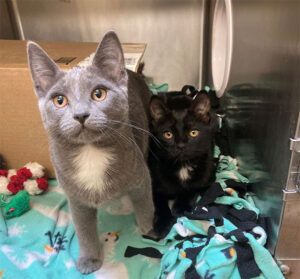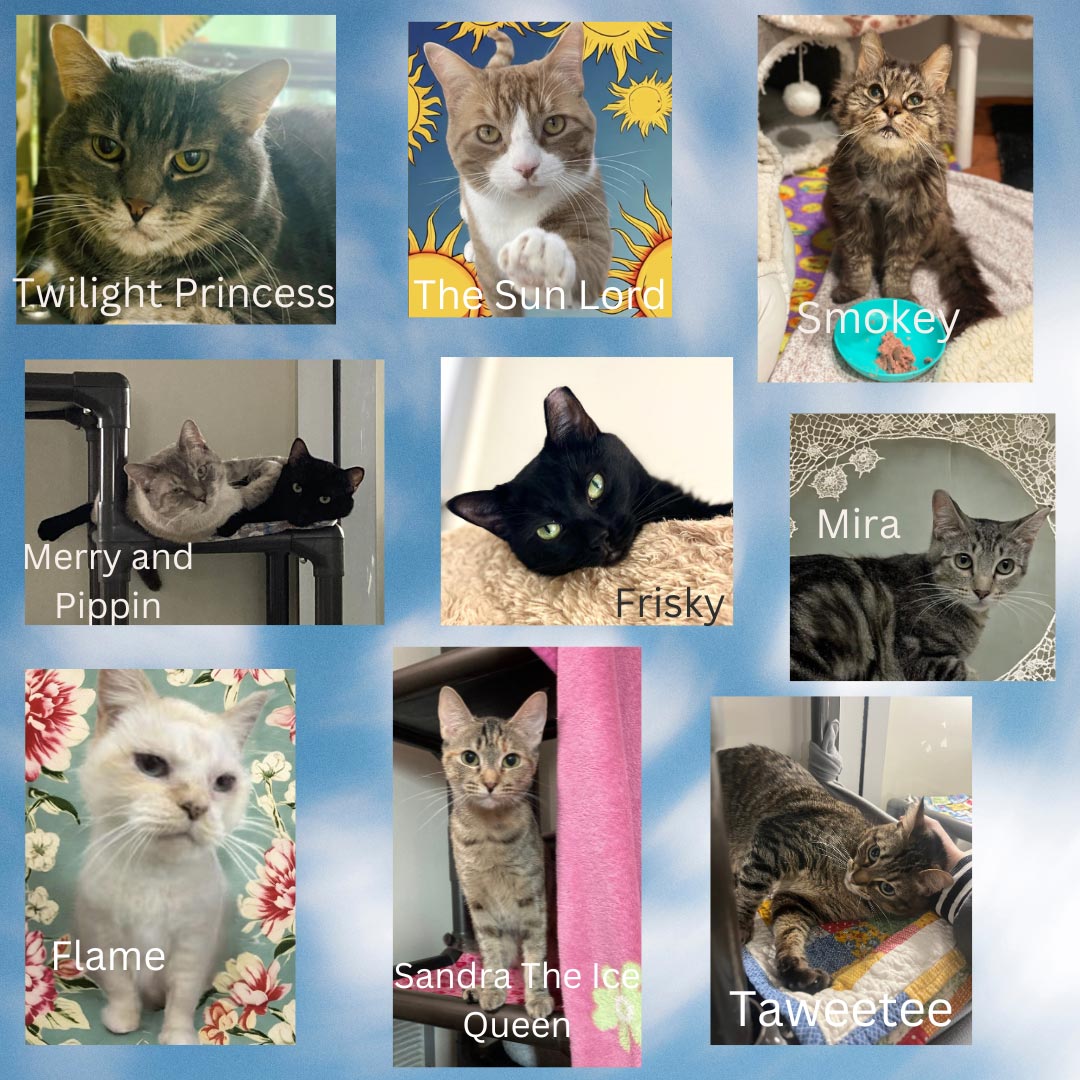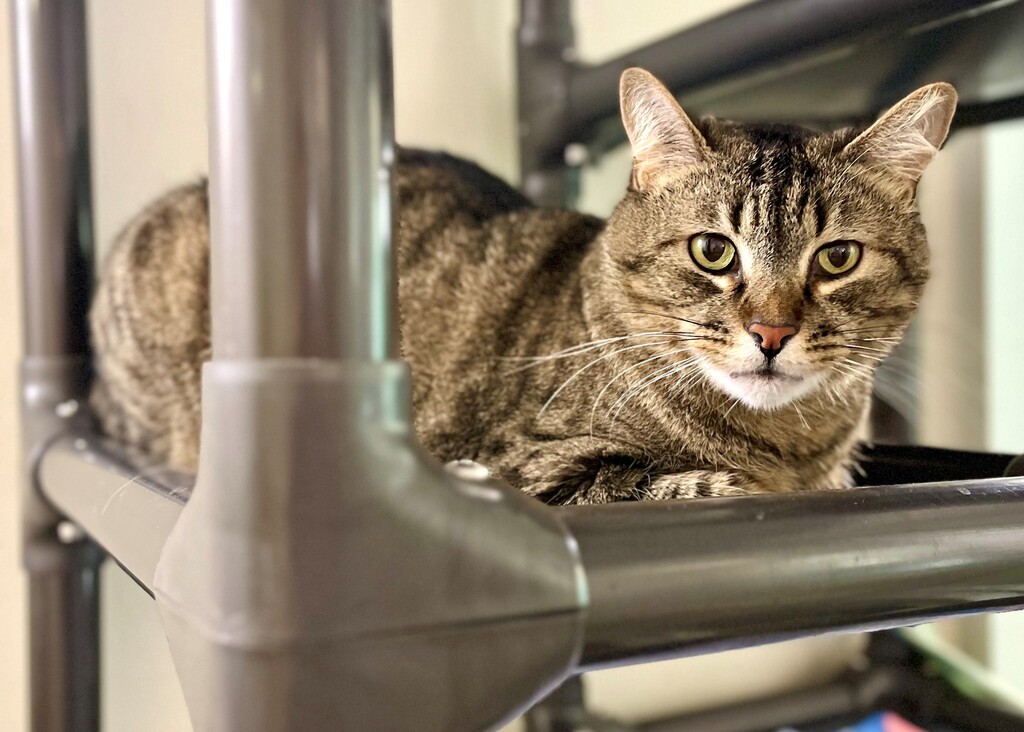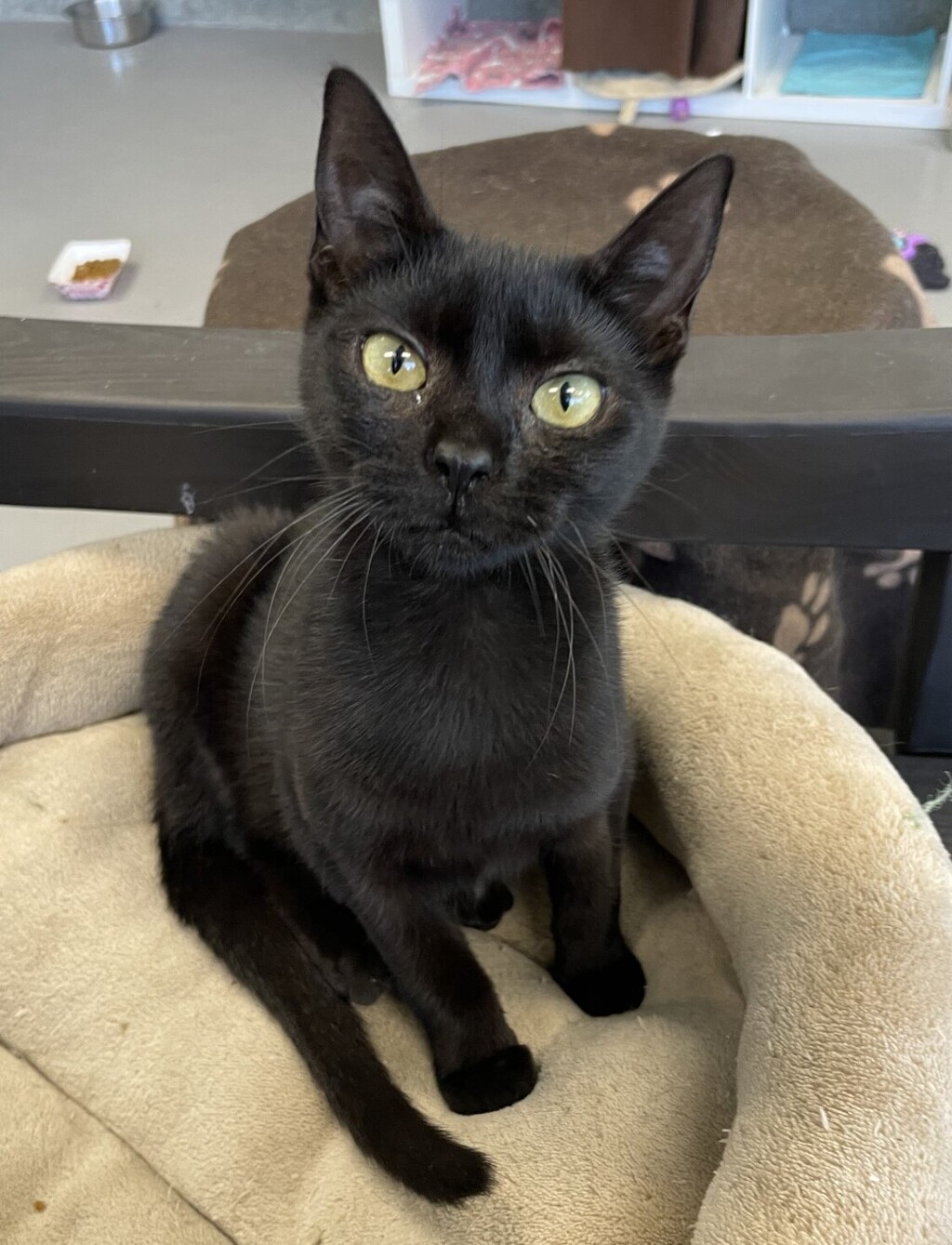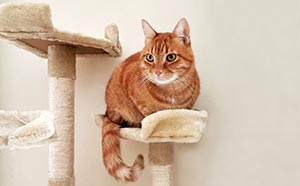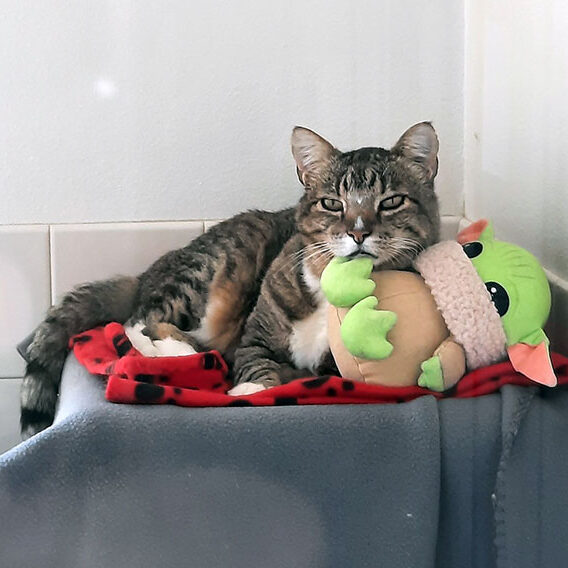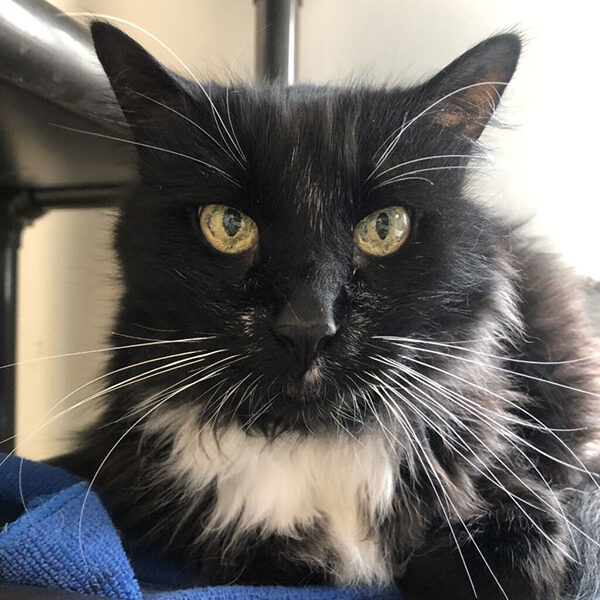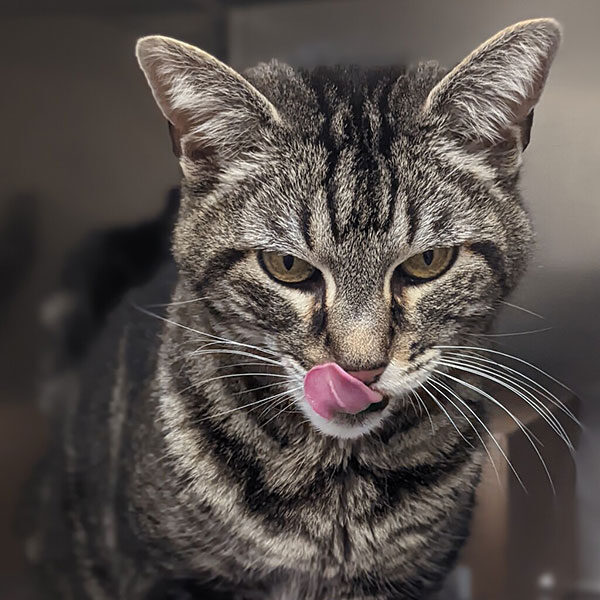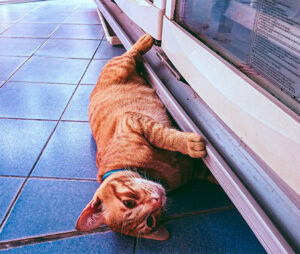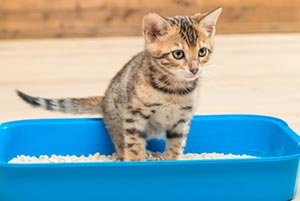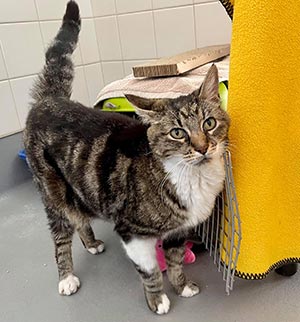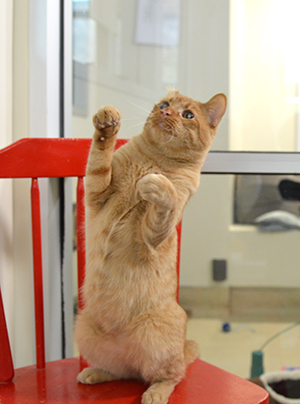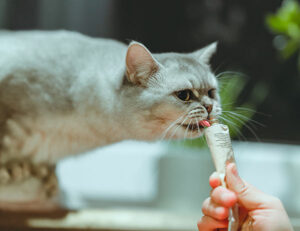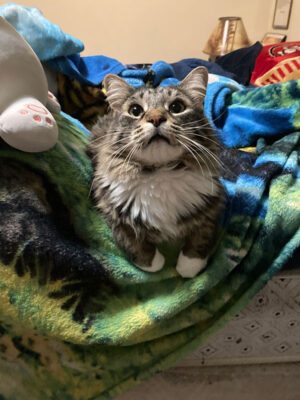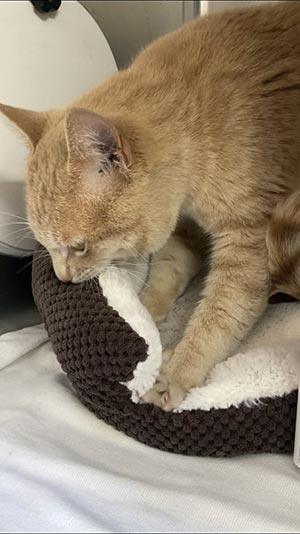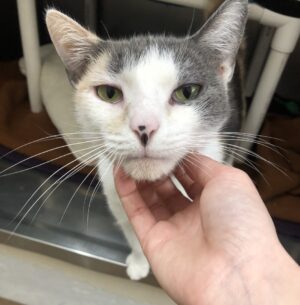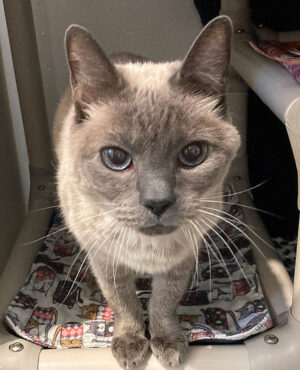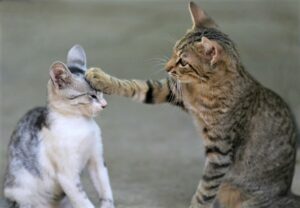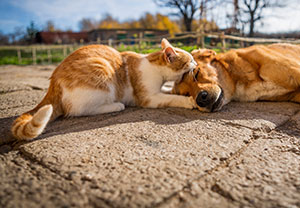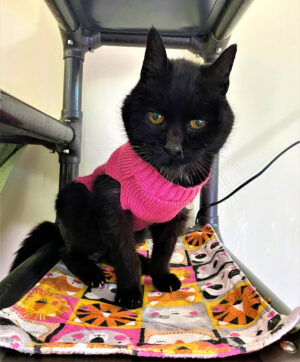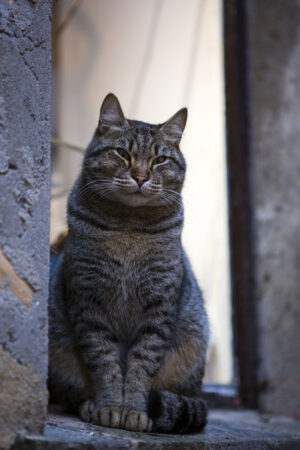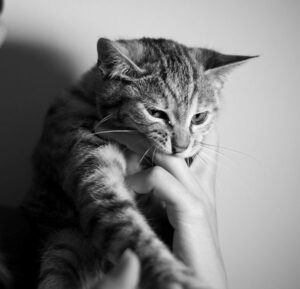HSSC Feline Behavior Program
HSSC’s Feline Behavior Program helps ensure that each cat’s stay at the shelter is as comfortable, enriching, and stress-free as possible.
We often work with challenging cats – those who start off very shy or shut down or those who are fearful of humans and may swat or bite out of fear. We help rehabilitate as many as we can and find appropriate barn cat homes or other alternative placements for those who prefer not to socialize with humans.
We strive to make sure that all available information about a cat’s personality and behavioral needs are documented and made available to potential adopters so that every cat in our care will get adopted as quickly as possible to the RIGHT home.
CATURDAYS
- Clicker Training Basics
- 3-3-3 Rules Of What To Expect From Your New Shelter Rescue Cat
- Things You Should Do with Your Kitten that Will Make Your Life with Them as an Adult Cat Much Easier!
- Cat Toys and How to Use Them
- Dog-Cat Introductions
- Having a hard time getting your cat to play?
- Helping Your Shy or Scared Cat
- Inappropriate Elimination — Solving Litterbox Problems
- Introducing Your New Cat to Your Resident Cat
- Overstimulation in Cats
- Pet Safety During the Holidays
- Play With Your Cat
- Recommended Wellness Guidelines for Cats
- Removing Pet Odors and Stains
- Teaching Your Cat to Love their Carrier
- The Fearful Cat
- Understanding Your Cat’s Nighttime Activity
- What To Do If You Find a Kitten Outside
- Your Cat – Indoors or Out?
Cats are unique individuals and they have lots of different types of play styles; one common one that many people will have seen before is when cats love stuffies/soft toys and will kick and bite them, or even carry them around in their mouths, bringing them into dens or cubbies! Ahab here is giving an excellent demonstration of just how adorable it is when a cat plays with a squishy toy.
One thing you have to watch out for with cats who like soft toys, is if they are chewing on the toys enough to rip them up. While most cats won’t intentionally try to eat the stuffing from inside, they may swallow some accidentally, so try to throw away or repair toys that are getting torn up! I also suggest avoiding the toys with the plastic pellets inside (like beanie babies) as those could be even easier for a cat to accidentally swallow. Intestinal blockages are a medical emergency and can be fatal if not addressed promptly.
Another note- for a cat like Ahab, I would not leave them alone with this wand toy; with how playful he is, and how he rolls around with it, it would be too easy for him to get the string wrapped around his neck or paw and hurt himself. He gets plenty of stuffies that aren’t attached to string that get to stay in his habitat with him all the time, so he can play whether a human is visiting him or not 😊
Ahab has already been taken to a home where he can have ALL the toys and so much playtime, but there are always other cats who would much rather be playing in your home than here at the shelter! Browse our available cats on our website, and then give our Santa Rosa or Healdsburg shelter a call to learn more about them, or just head on in to the shelter that has the cat or cats that strike your fancy!
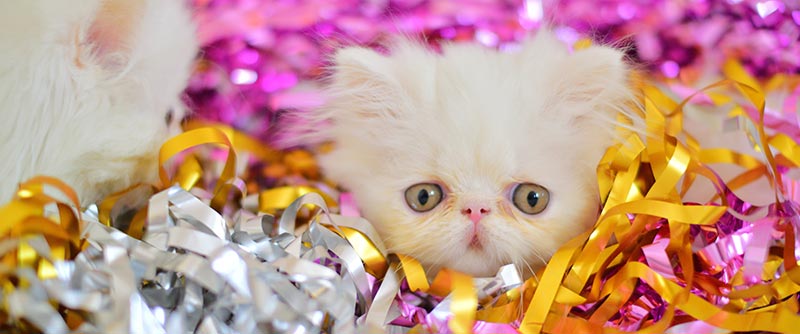
Happy almost New Year, everyone! It’s the last Caturday of 2024!
Maybe you’re celebrating by cooking a nice dinner and having a few friends over to ring in the new year together, or maybe you’re getting a bit louder and more active, or maybe you’re going out and leaving your kitty at home alone. Even if you have literally zero plans and are going to bed at 9 PM (that’s my personal plan), more likely than not, you’ll be able to hear some fireworks, or will hear happy cheers from your neighbors celebrating at midnight- and your cat will be able to hear those things, too. What can you do to keep your feline friend safe and content on this holiday?
-If your cat is normally allowed outdoors, this is a good night to stray from that habit and keep them inside.
-Before the day comes, double-check if you have any hiding spots in your house that you’d have a hard time finding and extracting your cat from, and block them off. Even normally confident cats can be fearful of new noises like fireworks, or feel uncomfortable if you have a lot of people over, and if they get scared they may be driven to hide somewhere like under your bed, or in the back of a closet behind a storage bin, or inside the kitchen cupboard that has a gap just large enough for them to squeeze through. Give them appropriate hiding spots like cardboard boxes, cat cave beds, or cat furniture that includes hidey holes. If there’s an emergency, you want to be able to easily find your cat and easily get them out! Bonus points if you turn their carrier into a cozy place to hang out and hide- nothing makes getting your cat in their carrier easier than if they already view it as a safe, comfy spot!
-If you’re leaving the house for a long period of time for a party, do your best to adjust your schedule so you can stick to your cat’s routine as much as possible- on a night where there may be some frightening noises, having everything else be the same as usual is comforting. Try to feed them at their normal time, play with them as you normally would, and give them the same kind of attention you would any other day.
-If people are coming to YOUR place, give your cat a ‘quiet room’ where they have access to litter, water, food, toys, etc. and make it a ‘no guests’ zone- if your cat is particularly shy or skittish, just keep the door shut the whole night. This could also prevent them from dashing outside as you open your front door to let guests in, or running out onto a patio or balcony if you’re spending time outdoors and people are going in and out a lot.
-White noise is your friend! It will help drown out sounds of fireworks, your party, or anything else that may be going on. You can use an actual white noise machine on a low volume if you have one, or play TV or radio quietly, turn on a fan, or play gentle music- or even put on ‘cat TV’ on a spare phone or tablet that you can leave plugged in for them all night!
-Avoid overcompensating with the attention you give them; if they are scared and hiding and you are fawning over them and over-comforting them, the ‘abnormal behavior’ that YOU are displaying towards them could serve to increase their anxiety. Make sure you know where they are, offer them the usual pets and playtime and food, but don’t ‘make a big deal’ out of their fear, and don’t remove them from a hiding spot to try to comfort them- if they are choosing to hide rather than seeking attention from you, then hiding is what they find most comforting at that moment. If you’re free to sit in the room they are in and read or watch TV or do some other ‘normal’ activity, this can help their anxiety from escalating. Mostly, just let them rest where they feel secure and try to behave just as you normally would towards them. If you discover that this event seems particularly traumatizing to them and they don’t bounce back quickly the next day, consider talking to your veterinarian about behavior medication to use for similar events in the future.
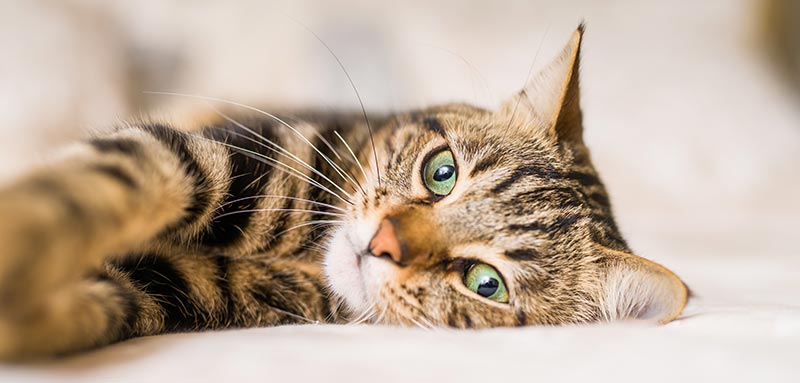
Cats are complex creatures that we are so lucky to have as our companions; today I’m going to talk about a few basic things that you can do to help keep your cat content and happy in your home!🐱
-Pet your cat how they want to be pet.🪥
This can mean something different for every cat. Some cats love to be picked up and held and pet ‘roughly’. Others will not, and when well-meaning people think they are showing them love by picking them up and cuddling them, the cat is actually feeling uncomfortable. Learning more about cat body language can help you figure out when your cat is comfortable or not, but if you’re a beginner to learning about it, an easy thing to do is simply to let your cat choose. Sit near them, offer a hand, and let them guide you to the areas they want to be pet. One of my cats will run up to me and meow when she wants pets, and once I’ve started, she turns her face away and presents her butt to me because booty scritches are her absolute favorite! She is also a very selective lap cat- she only wants to sit in my lap when it’s HER idea, so while I don’t pick her up and put her in my lap, I will sit near her and make my lap as appealing as possible by sitting in a neutral pose and draping a fuzzy blanket over my legs. It often results in a happy purring cat on my lap!
-Play with your cat every day.🪀
Every cat, regardless of age, needs interactive play time with you on a daily basis. Cats can have varying tastes in toys and play styles, but one toy that works well for many cats is a wand toy/fishing pole toy. Read about how to effectively use this kind of toy here: https://humanesocietysoco.org/owner-support/caturdays/…
There are plenty of other kinds of toys that cats will enjoy, however, both with and without your participation. You can read about some suggestions here: tinyurl.com/Caturdays
-Make your home cat friendly.🐈
While it’s easy to grab a cat tree, a soft bed, and food and water dishes, looking at your home from a cat’s perspective can help you figure out how to enrich their environment to keep their stress levels low, their happiness high, and will result in increased happiness for you- generally the more well-enriched a cat is, the fewer behavior challenges you will face! Vertical space like cat trees, window hammocks, or shelves installed specifically for your cat (no valuables to knock off of them) is essential. A variety of cat scratchers in socially important locations (such as next to the living room couch) is also a must, as are soft beds or blankets that you don’t wash too frequently, so your kitty can sit on them and ensure their scent is spread around throughout your home (it’s their home too, after all). Cheap throw blankets that you can find at many department stores are an excellent option- I have probably about 20 throughout my apartment and my cats sit on all of them. Another key thing to pay attention to- and this will be your least favorite thing- is how many litter boxes you have, and where they are located. The general guideline to follow is to have one more litter box than the total number of cats you have, and to place them in easy-access locations, away from noisy appliances. While some cats may be fine having litter boxes placed in out-of-the-way corners or closets, many will need them in a more open space that is easier for them to get to, so keep in mind that you may need to put a litter box somewhere that you personally may not be fully satisfied with. The good news is that if you scoop eliminations promptly, you likely won’t even notice a litter box in your living room- and cats love clean litter boxes anyway, so it’s extra motivation to make sure you’re keeping their bathroom clean!
Remember that a cat is a living creature who has their own needs and desires that won’t always line up with yours 100% of the time, so sometimes you may need to compromise!

For those of us who celebrate it, Thanksgiving is coming up! In the excitement and chaos of the holiday, it can be easy to forget about any special arrangements you may need to make for your feline friends. The following are some tips for how to make the event a little more cat-friendly. If you don’t celebrate Thanksgiving, you can think of this as advice for any event where you have visitors and food in your home.
When celebrating a holiday that involves food, it’s natural to want your cat to join in on the fun. If you really want to play it safe, rather than giving your kitty any human food, you can pick out a ‘special’ cat food or treat to offer them instead; something tastier than what they get on a day to day basis. If you really want to share some of what you’re cooking, the safest bet is likely unseasoned white turkey meat. Ensure that anything you offer them is fully cooked to avoid salmonella, and check for bones as they could splinter and cause GI issues. Don’t offer them too much, either; even if the food you give them is completely safe, too much of a new thing can give them an upset tummy which could lead to diarrhea or vomiting.
Even if you have no plans for giving your cat human food, they may have a different idea. Even cats who are usually good at staying off the counters may be tempted by new smells, so don’t leave anything uncovered unattended. If you have some food set out in serving dishes that don’t have covers, you can use an oversized pot or mixing bowl to cover it up. Be especially careful with any dishes that contain foods that can be dangerous to cats, like garlic or onions.
If you’re decorating your home and want to include plants or flowers in the décor, read up on what you get to make sure your choice is cat safe. Many plants and flowers can be toxic to cats, including the popular holiday flower lilies- even just brushing up against them and licking pollen off their fur can result in a medical emergency.
Having visitors over usually results in more noise and activity, and that can be stressful for your cat. Even typically friendly cats can feel overwhelmed if there are lots of people over- especially people they’ve never met before. Ensure you have a ‘quiet’ area set up for your cat that is off-limits to visitors, where they have access to water and their litter box, so if they decide to retreat there, their basic needs are still being met. To drown out background noises, you can leave a fan running, or play some gentle music at a low volume. Make time for your cat during your busy day- cats thrive on routine, so stick to their normal schedule for feeding, playing, and cuddles as much as you can. It will go a long way in keeping their stress levels low!
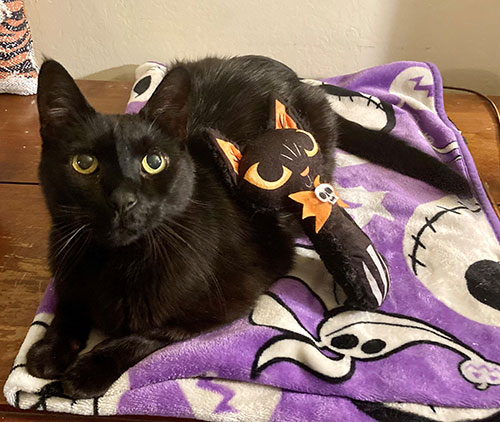
Halloween Safety Tips For Your Cat
Halloween is just a few days away! Whether you’re having a party or are looking forward to a steady stream of trick-or-treaters, this Caturday I’d like to share a few Halloween safety tips for your cat.
-If your cat is normally allowed outdoors, this is a good night to keep them inside. With all the extra activity that goes on that night- more cars driving around, more people walking the streets- it is safer to keep your kitty indoors.
-If your door is going to be constantly opening and shutting as you hand out candy, it may be best to keep your cat in a separate room with a closed door to avoid risking them running outside. Be sure that the information on their microchip is up to date, just in case! You could also consider putting up a sign that says ‘knock please’ to discourage people from using your doorbell, as shy cats may be frightened by the loud bell constantly sounding.
-If you’re having a party, this is also a good reason to keep your cat away in a safe, quiet room. Even outgoing cats can be overwhelmed when there are a lot of people they don’t know in their space. Make sure they have access to food, water, toys and enrichment, and a litterbox. If your cat is particularly skittish, use something that will help drown out background noises- play gentle music, keep a tv on at a low volume, or have a fan running.
-While most cats are not going to be drawn to candy, as sugar/sweetness isn’t appealing to them, you should still keep an eye on any food you have out and make sure your cat doesn’t try to sneak a bite of anything! While your cat may not be interested in the candy itself, crinkly wrappers can seem like a very fun toy to them, and accidental ingestion leading to a blockage is always a risk- especially if your cat has a history of chewing plastic bags or anything similar, be sure all candy wrappers go straight in the trash.
-Limit the use of cat costumes. While we may think a dressed up cat is adorable, most cats do not enjoy the process of being dressed up, nor wearing the outfit. If you have a relaxed, confident cat who you think may be okay with costumes, consider working slowly to train them to accept being dressed up using positive reinforcement methods, instead of just throwing an outfit on them.

Night Vision
Most people know that cats can see much better in the dark than us humans can, which lends to the belief that cats are nocturnal creatures. Domestic cats are actually what is known as ‘crepuscular’, meaning they tend to be most active around dawn and dusk- but that still means they need to be able to see well in dim lighting!
The eyes of cats, as well as many other animals who are most active during times of low-light, have a structure in them called the tapetum lucidum. If you’ve ever shone a flashlight towards a cat and watched their eyes shine, or turned on a porchlight at night and seen glowing eyes looking at you from the darkness, then you have seen the tapetum lucidum in action. It functions in much the same way a mirror does- light that goes in reflects off of it, and the light that ‘escapes’ from the eye after bouncing off of it is what creates the glowing effect that you see.
However, not all of the reflected light escapes from the eye. Some of it reflects back through the retina, increasing the light that goes to the photoreceptors in the eye. The photoreceptors trigger nerve impulses that pass via the optic nerve to the brain, where a visual image is formed. If there is only a small amount of light that reaches the photoreceptors, what is seen will not contain as much detail. Because the tapetum lucidum reflects an extra bit of light to the photoreceptors, it increases the amount of detail and allows cats (and other species with a tapetum lucidum) to see better in dim lighting than humans can.
The attached ‘night vision’ picture shows a comparison of what a human (top) and a cat (bottom) would see on a dark night.

Different Cat Play Styles
Playing with your cat is an essential part of their daily routine; every one from tiny kittens to super-seniors will benefit from playtime! Wand toys, or fishing pole toys, are one of the best tools for you to have to engage your cat in play time. While the type of wand toy you have matters, as cats like different ones, the manner in which you move the wand toy around is often the most important thing. Finding your cat’s play style will help both of you have a lot of fun!
Kittens are usually pretty easy to please- start waving the toy around in erratic motions, and they’ll likely be happy. Some cats can be quite picky about how they play with toys, and will only bat at a wand toy if you swish it slowly above their head in just the right way, or drag it along the edges of their cat tree, or some other very specific motion or location.
Wilma, featured in the video, is a good example of a cat who has a favorite play style. She’s a high-energy cat who needs a lot of enrichment and play time, and while she will bat at wand toys in many circumstances, what’s seen in this video is her absolute favorite- when the wand toy is dragged behind an object, so she can leap around the object and ‘catch the wand toy by surprise’. This type of play behavior mimics what an outdoor cat hunting a mouse might do, so it’s actually quite a common play style for cats to have!
Wilma is available for adoption! She’d love to be the only cat in a home, and because of her keen hunting skills, will do best in a home with no pet birds or other small pets like rats or mice. If this gorgeous lady catches your eye, and you think playing with her sounds like fun, you can come to the shelter or call our adoption counselors at 707-542-0882 to learn more about her.
Why You Should Adopt Two Kittens
If you are planning on adopting a kitten this year, I’d like to ask you to consider something: adopt two! Many people are concerned that getting two kittens at once will be too much work for them, but it’s actually the opposite- most of the time, two kittens are less work than one. Kittens are VERY playful little critters, and it can be difficult for us humans to keep up with their need for interactive play. If a kitten doesn’t have enough stimulation and enrichment, they will create their own- possibly by pouncing on your feet at 2 AM, or chewing on the cord dangling from the back of the TV. Having a second kitten around means they have an endless source of entertainment and takes some of the burden of providing near-constant playtime off of you.
Another benefit of having two kittens is that they will teach each other manners. Biting and scratching are natural cat behaviors- they are predators, after all- so it’s no surprise that kittens will pounce on and bite or scratch their toys, or sometimes your hands or feet! While you can help a solo kitten learn to direct their energy towards a toy rather than your skin, the easiest way for them to learn is with another kitten friend who will help them discover good boundaries when it comes to biting and scratching. This will help them grow up into an adult cat who knows that they shouldn’t bite other living beings as part of playtime.
The easiest way to get two kittens who love each other is, of course, by adopting littermates. However, sometimes you might want to introduce two kittens from different litters (which is normally much easier than introducing two adult cats). If you want two non-sibling kittens, I recommend watching the Kitten Lady’s video on how to safely get two kittens together: https://youtu.be/1vZiorgO5Q8
If you have another young, playful cat at home who you think needs a buddy, then adopting a single kitten could be the right fit for you if you think three felines in your house would be too much- though in that case I recommend introducing the kitten to your adult cat using traditional cat introduction methods to ensure you have a smooth start. If you have an older or more reserved cat who is likely to be overwhelmed by a kitten, then adopting two kittens can sometimes make the process easier on your resident cat, as the kittens will be able to get out their bucket-loads of energy with each other rather than constantly bothering the older cat. Of course, how much you can budget for vet visits- routine or otherwise- is also a consideration, and the added cost might make you nervous about getting a pair of kittens. If that’s the case, please don’t feel guilty about only adopting one kitten- it is not at all poor animal welfare to adopt only one kitten, just be sure you are prepared to spend even more time and effort on meeting their play and enrichment needs!
All this talk of kittens has, I’m sure, put you in the mood to adopt! The best way to know if we have available kittens is to keep an eye on our adoptions page on our website: https://humanesocietysoco.org/available-animals/
It updates throughout each day, so will show up-to-date info about who is available. If you see kittens on there and are ready to adopt, the best thing to do is come to the shelter during our adoption hours, ready to bring home some kittens that same day! Our adoption counselors will help you pick out the best kitten (or hopefully two) and send you home with them right away so you can jump right into snuggling and playing with your new family member!
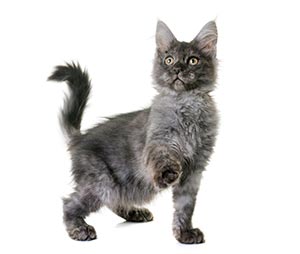
Do you ever have trouble understanding what a cat is trying to tell you, especially a cat you don’t know well or are meeting for the first time? Don’t feel bad—cat body language is tricky!
While there are many video guides available online, each cat can be a little different—one cat’s slow tail swish may mean they just spotted a bug on the wall and are interested, while another cat’s might mean they’re getting overstimulated and need you to stop petting them right away! If you’re starting a friendship with a shy cat, how can you differentiate between the ones who will welcome scritches while they’re in their cozy hidey hole, and the ones who will swat you if you try to touch them? If you have a cat who keeps asking for scritches and lap cuddles, even as they’re getting overstimulated, how can you know when to stop petting them to avoid getting a swat or a nip?
While being fluent in cat body language is helpful, even if you’re still learning or just not good at reading their signals (we’re all good at different things in life, and there’s nothing wrong with that! ), you can still engage with cats who are hard to read by using consent checks.
Slowly extend your hand toward the cat, making sure you’re coming in at a low angle where it’s easy for them to see you, and don’t get too close to their face. If they don’t approach you, or lean away from your hand—leave them be.
If they do approach you and initiate contact, give them a few scritches and then stop—if they continue to lean into your hand and seek out touch, you know for sure they want the attention!
Whenever you are petting a cat, it’s a good idea to stop every once in a while and let them choose if they want to re-engage or not. If you’re petting a cat who you know has petting-induced overstimulation, you’ll want to do these consent checks pretty frequently.
Remember—just because a cat is sitting next to you or near you, or even sitting directly on your lap, doesn’t mean they want to be pet endlessly! If a cat is choosing to be in or near your space, regardless of whether they want pets or not, rest assured that they are enjoying your company.
This video from San Diego Humane Society shows a great example of a cat saying ‘no’ to pets in a more subtle way:
Happy almost 4th of July, everyone!
Everyone celebrates this day a little differently- cooking food, firing up the grill, having company over- but even if you have zero activities planned, more likely than not, you’ll be able to hear fireworks from where you are- and so will your cat. What can you do to help keep your kitty safe and happy on this holiday?
-We may call this holiday ‘Independence Day’, but this is one day you should definitely NOT let your cat be independent! If your cat typically is allowed outdoors, today is a good day to stray from that habit and keep them inside.
-Now is a good time to double-check if you have any hiding spots in your house that it would be difficult to extract your cat from, and block them off. If they get scared, they may be driven to hide somewhere they normally wouldn’t- underneath the bed where you can’t reach them; the back of the closet behind a storage bin that they can squeeze behind; the cupboard that has a gap that gives them access to inside the wall. Make sure they have plenty of appropriate hiding options available, like cardboard boxes, cat cave beds, or cat furniture that includes hidey holes. In case of an emergency, you want to be able to easily find your cat and be able to easily get them out! Bonus points if you turn their carrier into a cozy place to hang out and hide- nothing makes getting your cat in their carrier easier than if they already view it as a safe, comfy spot!
-If you are going over to someone else’s house for a long period of time for a party, do your best to adjust your schedule so you can stick to your cat’s routine as much as possible- on a night where there are going to be some frightening noises, having everything else be the same can be comforting. Try to feed them at their normal times, play with them as you normally would, and give them the same kind of attention you would any other day.
-If you’re having people over to YOUR place for a celebration, and your cat is skittish or wary of strangers, loud noises, or both, consider giving them a ‘quiet room’ where they have access to litter, water, food, toys, etc. and keep the door shut. This also can prevent them from dashing outside as you’re opening your front door, or escaping through a patio or balcony if you’re hanging out outside and people are constantly going in and out.
-White noise is your friend! It will help drown out sounds of fireworks, your party, or anything else that may be going on. You can use an actual white noise machine if you have one, or play TV or radio at a low volume, turn on a fan or two, or play gentle music or even cat TV for them on an extra phone or tablet.
-Avoid overcompensating with the attention you offer; if they are scared and hiding and you are fawning over them and over-comforting them, the ‘abnormal behavior’ that YOU are displaying towards them could serve to increase their anxiety. Make sure you know where they are, offer them the usual pets and playtime and food, but don’t ‘make a big deal’ out of their fear, and don’t remove them from a hiding spot to try and ‘comfort’ them- if they are choosing to hide rather than come seek attention from you, then hiding is what they find the most comforting in the moment. If you’re free to sit in the room they’re in and read or watch TV or do some other ‘normal’ activity, this can help their anxiety from escalating. Mostly, just let them rest where they feel secure and try to behave just as you normally would towards them. If you discover that this event seems particularly traumatizing to them and they don’t bounce back quickly the next day, consider talking to your veterinarian about behavior medication to use for similar events in the future.
It’s June, which is adopt a shelter cat month!
We have SO MANY cuties available for adoption right now; in the excitement of kitten season, it can be easy to overlook all the wonderful adult cats who are available for adoption!
Are you looking for a sweet senior? We have not one, but TWO stand-out, love-bug seniors. Flame the 12-year-old is ready to nap the day away on a couch or sunny spot, and occasionally in your lap. Smokey the 14-year-old, who’s been spending his time chillin’ in a foster home, is a rather playful dude for his senior status, and despite being initially shy is just the SWEETEST cat ever.
Is a younger/more energetic cat more your speed? Consider Merry and Pippin, a bonded pair of 2-year-olds whose antics can be quite fun to watch as they playfully chase each other, or fall asleep in a cuddle pile. If you already have a high-energy cat and are looking to get a second, turn your eyes on The Sun Lord- at almost 3 years old, he’s an incredibly playful guy who would love to have another cat to wrestle with, or sit at a window bird-watching with!
If you’re a cat connoisseur who loves a feisty feline, check out Frisky! This lovely lady is looking for an indoor/outdoor home and adores chatting with her people, and every day with her feels like an adventure. Pretty tabby lady Taweetee also has a big purr-sonality and is looking for a human who will embrace her quirky, lap-loving self!
Shy cats need and deserve so much love, and the process of gaining their trust is SO rewarding. If you’re the kind of person who has the patience to put in the effort to win a shy cat’s love, do we have CHOICES for you! Perhaps Sandra the Ice Queen will draw you in with her regal, independent, and playful nature; or our other royal cat, Twilight Princess, who learns to love gentle scritches and a soft brush, may intrigue you. Or, consider Mira, an extremely shy young gal who we know ADORES running around with her toys at night, who really needs to be in a home environment to help her build more confidence.
We have SO many more wonderful cats available for adoption; I could spend hours gushing about each and every one. If you think this is YOUR month to adopt a shelter cat, look at our ‘adoptable cats’ section on our website: https://humanesocietysoco.org/available-animals/?_pet_type=cat
Or just come on in to either our Santa Rosa or Healdsburg locations during our adoption hours!
Many people know that long-haired kitties often need a helping hand when it comes to maintaining their coat, but even short-haired kitties can benefit from a good brushing. It can help prevent hair balls, keep your kitty cooler when it’s hot out, help YOU by reducing the amount of shed fur in your home, and it can be a great bonding activity! Some cats really love being brushed so even if they don’t NEED it, it can be enjoyable for both you and them. Here are some things to consider for grooming your feline friend!
-What type of brush should you use?
There are so very many different kinds of brushes, it’s hard to know where to start. Softer, less intense brushes are a good starting point if you don’t know how your cat responds to being brushed. Brushes that have tines with soft, rounded tips can work well for sensitive cats. Silicone brushes, or soft bristle brushes, are slightly less efficient at removing loose fur, but work really well for cats who like gentle brushing as a bonding activity with you.
-How often should you brush?
If you’re using a more intense style of brush- one with really spiky tines, or a furminator-style brush that’s designed to cut away the undercoat- you probably won’t want to use it more than a couple of times a week, as there’s a chance it could irritate your cat’s skin or remove too much fur. You should always check with your vet if you notice any hair loss or behavior changes (such as abnormal licking or scratching) after regular brushing. With softer styles of brushes, daily grooming is usually fine, and may be necessary for medium- or long- haired kitties, or any cat who is overweight and has trouble cleaning themselves.
-Brushing and overstimulation
Even cats who enjoy being brushed can still get overstimulated from the grooming. This is certainly more of a risk with the more ‘harsh’ brushes, but even with soft brushes, cats can become overstimulated, often faster than they would be from petting- it’s a different sensation from what they’re used to, after all. You will want to watch their body language to know when you should take a break. If you know your cat gets overstimulated easily, try to stick with soft brushes and apply only light pressure until you’ve figured out exactly what your kitty thinks about being brushed!
If your cat is one of those who doesn’t necessarily LIKE being brushed, but NEEDS to be due to having long hair they have trouble maintaining themselves, or if they are overweight or have arthritis or another medical condition, brushing them can be a little more challenging. Use the softest brush you can get away with, and reward them for being brushed- a favorite treat, a play session with their favorite toy, or catnip as a reward after can help make future grooming sessions a little easier. Keep brushing sessions short- you can do several short sessions throughout the day instead of one long one, if that works better for your cat. You may also consider trying the ‘glove brush’ for a cat like this, as it may mimic the feeling of just regular petting more than other types of brushes, so they may not mind it as much.
Watch the included video for some of our shelter cats thoroughly enjoying brushing sessions with one of our volunteers! The featured Oliver Twist, Dear Abby, Meemo, and Mr. Rogers are all available for adoption at our Healdsburg location- you can call them at 707-431-3386 to learn more about each of these kitties.
Whiskers, also known as vibrissae, are ‘sensory tactile hairs’ and are absolutely vital to cats! The whiskers that everyone thinks of when they picture a cat are the long ones on their muzzles, but if you look closely, you’ll spot whiskers in other areas like above their eyes, on their chin, and on the back of their forelegs.
Whiskers help a cat understand what is going on in the world around them. Their roots are three times deeper than that of a cat’s fur, and the follicles they emerge from have more nerves and blood vessels, so while the whiskers themselves don’t have any feeling, the movement of whiskers triggers the nerves in the follicle. Whiskers are equipped with a special sensory organ called a proprioceptor, which detects vibrations in the environment and aids the cat in navigation and balance. A cat’s eyesight is not their best sense, especially at close range, and their whiskers more than make up for this deficit. If a cat is hunting something- whether it’s a mouse outdoors or a wand toy that you’re swinging in front of them- their whiskers help them detect the slight changes in the air currents created by the moving object or creature to know it’s exact location. Whiskers also help cats balance on the top of a narrow fence, or a door frame or window ledge.
Whiskers also assist with a cat’s spatial awareness; when a cat puts their head up to a small opening, their whiskers help the cat determine if they can fit through the space or not. Generally, a feline with appropriate body condition will be able to squeeze through any space that their head and whiskers indicate they can, but an overweight feline may not compensate for their extra pudge- one of many reasons to keep your cats at an appropriate weight!
Since cats gauge so many things by the feedback their whiskers get them, this offers an explanation from why cats will sometimes turn away from food or water bowls that are too narrow for them. When their whiskers are brushing against, or being pushed back by the sides of the dish, it can be painful or uncomfortable for them- and it’s possible their brain is telling them that if they push their head further into the bowl, they may get ‘stuck’ and not be able to get out again! Of course, we’ve all met cats who have no problem shoving their face in a narrow glass to steal the water you’ve just poured for yourself, but in general you should be sure to offer food and water in wide, shallow dishes to avoid ‘whisker fatigue’ or ‘whisker stress’, as it’s often called.
The way a cat positions their facial whiskers can also tell you a little about how they’re feeling. Whiskers that are in the ‘relaxed’ or ‘neutral’ position will be straight out to the side and following their natural curve from the cat’s muzzle, and this means the cat is feeling at ease. If their whiskers are pointed forward, away from their face, they are focused on something or excited about something- perhaps hunting a toy or looking at a bird out a window, or in some cases this can be a sign of overt aggression. However, more common with a cat who is feeling fearful or is willing to defend themselves in an aggressive manner is whiskers that are pulled back and flattened to their face: they want to get these important sensory hairs out of the way so there is less a risk of damaging them if a fight ensues.
Due to their sensitivity, many cats will not like having their whiskers touched or petted. Some cats, however, welcome pets on and around their whiskers as long as you are gentle! Always let your cat decide if they are okay with you touching their whiskers or not, and be sure never to pull on them or rub them away from the direction the cat is angling them. And of course, never trim your cat’s whiskers! While they will shed and regrow naturally, trimming whiskers can be very detrimental to a cat- after reading about how important they are and what they do for cats, it should be easy to understand why!
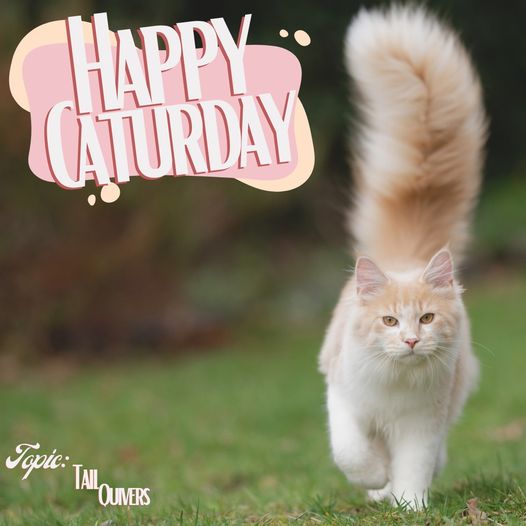
When cats are feeling relaxed and friendly, you’ll often see them walk around with their tail held straight up in the air, or maybe even in a ‘question mark’ pose! At times- often when you have just come home, or maybe when you’re about to open a can of wet food- you may see your cat ‘quiver’ or vibrate their tail. This is a sign of happiness that means your cat is excited to see you, or excited for what is happening, like feeding them or playing with their favorite toy.🪀
Why the tail-up pose when a cat is relaxed and happy? Think of it this way: if a cat is willing to expose a vulnerable part of their body to someone else, it means they trust them, so if you often find yourself with a cat butt in your face, you should take it as a compliment- its the equivalent of your cat saying they love and trust you! Cats will also frequently sniff each other’s butts as a method of identifying and greeting each other, and will typically only want to expose their butt to another cat who they are comfortable with.🐈
Some people, when they see their cat quiver their tail in excitement, think that their cat maybe spraying. The happy-quiver does greatly resemble the motion that cats do when they are urine marking, but it’s quite easy to tell when they are spraying as they will typically be backed up to a wall or other vertical surface- and of course you can smell and see the urine after! Though these two behaviors look very similar, they are not linked: a cat who says hi with a happy tail quiver is not more likely to spray than any other cat. One common thing that will more likely than not result in a cat spraying, is not spaying or neutering them, so be sure to spay and neuter your kitties!😽
It’s important to not mistake a bristling, puffy, or thrashing tail for a happy quivering tail. A cat who has their tail fur puffed up or is thrashing their tail back and forth a lot could be feeling scared and willing to act in an aggressive manner, or they could be overstimulated and/or have a desire to play. If it’s a sign of fear/aggression, you will likely see a lot of other obvious signs- growling, hissing, staring, and a very tense body, for example. A cat with a poofy tail or wagging tail who is in the mood to play will not display these warning signs, and they will often start engaging in what we call ‘zoomies’! In those cases, it’s a sign to play with your cat. Throw some toys around for them to chase, or start swinging their favorite wand toy around to give them a healthy outlet for that energy- otherwise you may find yourself with a cat who tries to play with your ankles as you walk around your home, and it’s much better for everyone if they direct their playful energy towards a toy rather than your skin!
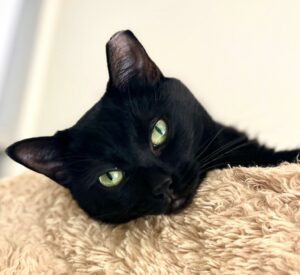
Do you have a catio, a garden, a porch that gets some awesome sunlight, or a nice cat-friendly neighborhood? Frisky is in the meow-ket for an upgrade to her current living situation, which is currently a studio ‘a-paw-tment’ with an awesome window view. Frisky catches the ‘bus’ (her carrier) four or five days a week for a nice short commute to her favorite park (our catio), as she lives her best life when she can have some quality outdoor time and isn’t willing to give up that luxury in her forever home. Frisky thinks that the outdoors is best when shared with someone special, and as you can see in the included video, will greet you time and time again with enthusiasm.
As adventurous, loving, cute, and smart as this lady is, Frisky isn’t always the best at being a housemate. She can be sassy and demanding, won’t always like the meals you fix her, and is picky about the kind of toys she’ll play with. Frisky also has a healthy set of personal boundaries, and has no problem saying ‘no’ if you pet her when she doesn’t want to be pet- the queen of sass that she is, this may even include when she’s lounging in your lap. What Frisky truly desires is someone who can understand her body language so much that it’ll be just like she said ‘stop’ out loud. So if you’re well-versed on cat body language and enjoy confident, sassy cats, you and Frisky will have no problem getting along!
This intelligent, friendly, and sassy lady is ready to find her partner in crime who can share in some outdoor adventures with her. If you think this is YOU, come to our shelter or call our adoption counselors at 707-542-0882 for even more info about Frisky!
Did somebody say ‘kittens’?
While our shelter isn’t overflowing with kittens just yet, kitten season is most certainly here and will be in full swing before we know it! The first stage of kitten season, we don’t have many available for adoption kittens- it’s more about the super little guys who need lots of TLC so they can become big enough to get spayed or neutered, get all their vaccines, and eventually grow up enough to be adopted into one of YOUR loving homes!
One of the essential parts about helping as many kittens as possible is something many people may not think about- we need to keep as many kittens OUT of the shelter as possible. With their brand-new immune systems, a shelter where so many felines are coming and going (including some with contagious illnesses) is NOT a good place for a kitten to hang out. While we place as many of these babies in foster care as possible, the best case scenario is to stop kittens from unnecessarily coming to our shelter in the first place. Of course we want to help the ones who need extra support from humans, but a mother cat is SO much better at caring for kittens than we are. Mom cats will often leave their kittens alone for a few to several hours at a time, so kittens who you find ‘alone’ outdoors may not actually be alone! Every year, we get so many amazing Good Samaritans coming to us seeking help for a kitten or kittens that they found, and in order for us to be able to help as many as possible, we want to be sure bringing those little ones to the shelter is actually the best course of action.
Please refer to the lovely ‘kitten flow chart’ you see here, which can help guide you as to what the best course of action for a kitten is! When in doubt- pick up your phone, call a local animal shelter, and ask for advice. If the kitten needs to go to a shelter, they will be able to help guide you as to WHICH shelter you should contact, as any given shelter may be at capacity for kittens or otherwise not able to care for them- and it will save you a trip by going straight to a place that can help, instead of showing up at a shelter that is at capacity.
Mama cats, kittens, and humans everywhere will appreciate your diligence this kitten season in helping us give aid to as many felines as we can!
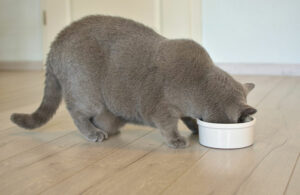
Do you ever watch your cat walk, and see a part of their belly that hangs down, wobbling as they move? This little flap is often called the ‘primordial pouch’. Many people assume the presence of this hanging pouch means their cat is overweight, but that is not the case at all! Every cat has this flap of skin and fat, and the size can vary drastically between cats. It may be more prominent on older cats, and actually LESS prominent on overweight cats, as having a larger belly can actually obscure the pouch entirely- so if your cat’s belly is big and doesn’t wobble at all, that may be a sign that they are overweight. There’s a genetic factor that contributes to the size as well, so certain cat breeds may have a larger or smaller pouch, but your typical mixed breed pet cat could have any size. Big cats like lions and tigers have these pouches as well!
So why do cats have these pouches? There’s a few different possible reasons. The pouch is thought to serve as extra food storage, and the elasticity can help a cat’s belly extend when they just had a large meal. This would come most in handy for wild big cats, who sometimes eat one large meal rather than multiple smaller ones- or if food is scarce in the wild. The excess skin also contributes to their overall flexibility, letting them twist and bend at a greater range, which can come in handy both during hunting, or when they are the ones needing to run away from something and jump and climb with great maneuverability. It can also serve as protection- if you have two or more cats and have seen them play fight, or watched your cat use a ‘kicker toy’, you’ll see that cats do indeed rely on their powerful back legs a lot, and use kicking motions during their play or roughhousing. The extra skin and fat provides another layer of protection to safeguard some of the cat’s vital organs.
The bonus to these pouches is, of course, that they are absolutely adorable, as it’s fun to watch the wobble of their belly when your cat is running around playing!
Today I would like to share with you the progress that Jasper has made since coming to our shelter!
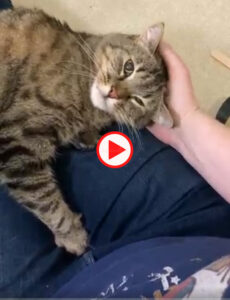 Jasper has been with us for about two months now. Initially, he was very hissy and frightened and was not at all interested in engaging with humans. I slowly started to break down his walls with the use of treats- at first he only cared about ‘temptations’ crunchy treats, but over time I’ve discovered that he goes crazy for wet food treat sticks (like Churu or Tiki Cat, for example). The first time Jasper came fully out of his hiding spot and walked up to me, I was ecstatic. I didn’t try to pet him at that time- just let him sniff me and get some tasty food- and pretty soon he was comfortable enough to start playing with a wand toy!
Jasper has been with us for about two months now. Initially, he was very hissy and frightened and was not at all interested in engaging with humans. I slowly started to break down his walls with the use of treats- at first he only cared about ‘temptations’ crunchy treats, but over time I’ve discovered that he goes crazy for wet food treat sticks (like Churu or Tiki Cat, for example). The first time Jasper came fully out of his hiding spot and walked up to me, I was ecstatic. I didn’t try to pet him at that time- just let him sniff me and get some tasty food- and pretty soon he was comfortable enough to start playing with a wand toy!
I started doing some clicker training with Jasper, really just to reinforce eye contact, coming and sitting close to me, or just being calm in my presence, and I used his favorite wet food treats for this. I would give Jasper these treats by squeezing a bit onto the end of a wooden tongue depressor, and one day, while I was in the middle of doing this, Jasper put his paws on my lap to try and reach for the treat. Just a few days after that, he came right up to my hand and started nuzzling it, asking for pets, and then crawled into my lap! He was clearly very nervous and close to overstimulating- the fur at the base of his tail was very poofy, and his tail was swishing wildly- but I sat and let him ‘pet himself’ against my hand in the way that he was most comfortable with, and he and I both had a wonderful time.
Since that day, every time I go to visit Jasper he comes off the tower and runs up to me to get pets (and food, too, as I of course still bring his favorite treat). While he hasn’t reached this level of friendship with anyone else at the shelter just yet, overall he is MUCH more relaxed with other staff and volunteers than when he first arrived. I’m sure that anyone else with a bit of patience will be able to achieve what I did with Jasper, likely at a faster pace in a calmer home environment, and long-term his forever person will likely see even more cuddles and less overstimulation as he gains confidence. I’m so proud of Jasper for being able to relax and come out of his comfort zone in the shelter to show off a taste of how sweet and amazing he’ll be in his forever home.
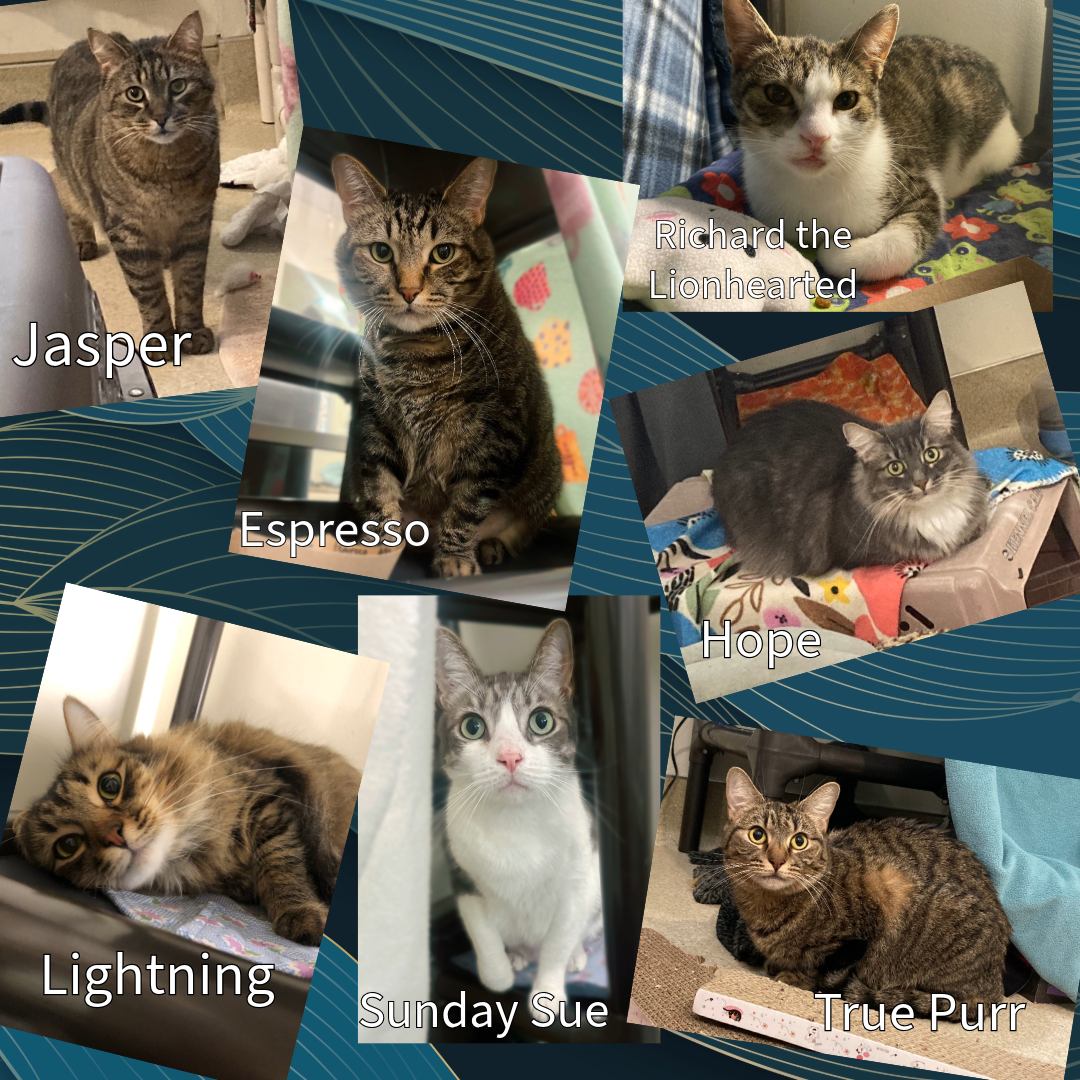 About a month ago, we took in a group of 14 cats from an individual who had dedicated a lot of time and energy into helping cats in need. Through no fault of their own, they were no longer able to provide care for these kitties, and thankfully HSSC was in a position to help!
About a month ago, we took in a group of 14 cats from an individual who had dedicated a lot of time and energy into helping cats in need. Through no fault of their own, they were no longer able to provide care for these kitties, and thankfully HSSC was in a position to help!
All of the cats were quite scared when they first arrived- it was a big change, from being in a nice home and then coming to a shelter. Thankfully, they all made EXCELLENT progress- and seven of them have already been adopted!
That leaves us with seven more cats from this group, all of which are shy but coming out of their shells more and more each day, and I believe they will all blossom faster in a home setting than they will here at the shelter. I’m eager for them all to find their perfect homes so I’d like to shine a spotlight on them today!
Let’s start with the most relaxed two of the lot- Sunday Sue and True Purr.
Sunday Sue is a very sweet boy who comes off his tower readily for quiet visitors, often purring and making biscuits before you’ve even started petting him.
True Purr is a gorgeous lady who loves to be pet and play, and can often be found napping in a nice cat bed or her carrier.
These next two- Espresso and Jasper- are for the more patient people who know that shy cats don’t always make the best first impression.
If you visit Espresso in her room at the shelter, most likely you’ll be greeted with a hiss or a growl. Don’t take it personally- she does this to everyone she doesn’t know. However, once she DOES know you, she will adore you- her best friend on staff gets to give her belly rubs, pet her all over, and listen to her cute meow! If you give her a chance in your home, within a month or so YOU will be the one getting to do this: https://youtube.com/shorts/DiBwJWUB-pA?feature=share
Jasper hasn’t warmed up to belly rubs like Espresso just yet, but with treats and a wand toy, you’ll have a great time and win his friendship with a bit of patience. You can watch him in action here: https://youtu.be/h0vi26iOwBc
Hope, Lightning, and Richard the Lionhearted are the middle-of-the-road of the group: Not quite as outgoing as Sue and True Purr, but not as shy as Espresso and Jasper.
Richard the Lionhearted is a young guy, and while skittish, he’s incredibly playful, loving wand toys and his electronic toy. He’ll likely retreat to the top of his tower or a hiding spot when you visit him, but once you let him sniff your hand and start petting him, the purrs begin and he never wants you to stop! We think he would love to live with another cat, so you could adopt him with someone else from this group who he already knows, or introduce him to your own kitty at home.
Lightning is similar in that he’d prefer to stay on his tower or his hidey hole as he’s getting to know you, but as long as you go slow he warms up to pets right away and adores hanging out with you.
Hope will also mostly stay in hiding- though she’s started to come out for play-time regularly- but once again, this is a cat who adores pets if you let her sniff your hand first (and maybe bribe her with a treat) and will be purring away before you know it! She also seems to enjoy being around other cats, so would likely do well going home with one of her friends, or being introduced to your own mellow kitty.
You can see all these kitties on our adoptions page! Check them out and then give our Santa Rosa shelter a call at 707-542-0882 if you’d like to know more about anyone. https://humanesocietysoco.org/available-animals/?_pet_type=cat
 It’s a well-known stereotype that cats are picky eaters. While I know plenty of felines who are extremely food motivated and will eat whatever is put in front of them, I have also known plenty of felines who are finicky about their food! What can you do to help your picky eater cat be a little more willing to eat?
It’s a well-known stereotype that cats are picky eaters. While I know plenty of felines who are extremely food motivated and will eat whatever is put in front of them, I have also known plenty of felines who are finicky about their food! What can you do to help your picky eater cat be a little more willing to eat?
-If your cat is historically a good eater, and they are suddenly showing a reluctance to eat, that isn’t necessarily a picky eater: that’s a cat who is potentially having some kind of health problem, and you should contact your vet right away!
-Try a variety of foods. Grocery stores or pet stores will usually have individual cans of cat food for sale, so you can get one can of a bunch of different foods instead of wasting money on a whole pack when your cat may not eat it. Kibble can sometimes be purchased in smaller packages instead of giant ones. Be sure you are not just looking at the different brands, but also the different styles of food: patè vs. shreds vs. chunks vs. prime filet, etc. for wet foods, and the sizes and shapes for kibble. In general, wet food is a better option- both for palatability and for some health reasons- so unless your vet tells you otherwise, feeding at least a mix of wet and dry food is better than dry food alone.
-Usually in that same area in the store, you’ll see a bunch of treats for cats, including some wet food kinds or broths that are in little packs. These should always say that they are not a complete nutritional option for your cat, but there is nothing wrong with adding them to your cat’s food to help entice them to eat! You could put broth or wet food treats on the top of your cat’s food, or mix it in. Put some of their favorite crunchy treat underneath a pile of wet food, or leave them poking out of the top. Sometimes they just need a little jump-start of something extra yummy, and then they’ll continue to eat their regular food.
-Presentation in general is very important, and preferences can differ from cat to cat. I have one cat who, when she eats patè, wants it to be sectioned into little chunks so she can easily bite at it, whereas another of my cats does best if it’s smooshed as flat as possible into the bottom of the dish or spread over a licky mat. Some cats may want it ‘fluffed up’ with a fork. Scooping the food out of the can and leaving it in the shape it comes out in is not going to be appealing for many cats. Some cats may like wet food and dry food in the same dish, and others may only eat them if they are in separate ones. Temperature is also important! Wet food pulled straight from the fridge that is cold can be unappetizing; heating it up in the microwave for a few seconds can get it to a better temperature, soften it up a little, and release more of the smell to make it more appetizing.
-You will also want to be sure you are using the right dish. A bowl with a narrow opening will have your cat’s whiskers rubbing up against the sides while they are trying to eat, and while some cats don’t mind this, others suffer from ‘whisker stress’ or ‘whisker fatigue’ as whiskers are a VERY sensitive part of their body, and it can hurt to have them rubbing against a bowl this way. It can be better to use a very wide, shallow bowl, or even a plate. Sometimes using an elevated bowl can be helpful as well, especially for older cats who may have some pain associated with bending down to eat their food. Or- do away with a regular dish entirely and try using puzzle feeders and licky mats for your cat’s meals!
-Where you feed them is also a factor. Cats will not want to eat near their litter box, and some cats will not want to eat next to their water dish either. They will also need to feel safe while eating, and this may mean that they need to be separated from other animals during meal times- sometimes putting dishes on opposite sides of a room is enough, whereas other animals may need to be behind a closed door so another cat or a dog won’t scarf their own food, then come after theirs before they’ve had a chance to finish! Noise or activity going on can also affect this- one of my cats’ regular feeding spot is in the kitchen, near the washer and dryer, and if I have either machine going then she is unwilling to come all the way in the kitchen and I have to place her bowl several feet away so she doesn’t have to be right next to the noise! A very reasonable request, honestly.
Many cats love to chomp away at grass! Their affinity for it may be a leftover trait from their ancestors- wild cats would get a lot of parasites from hunting and being outdoors all the time, and eating grass helped to ‘clean out’ their GI system- so yes, it is normal if your cat eats grass and then throws it up. If your cat is seeking out grass a lot, however, they may be intentionally trying to help an upset stomach, so don’t be afraid to call your vet if your cat is doing this! Many cats also just enjoy the activity and find it enriching, and you can never have too much enrichment for your cat!
Not all grass is created equal- letting your cat munch away on whatever random grass is outside isn’t the best plan. Growing your own grass is pretty easy: grass-growing kits made for cats can be found at many pet stores, and of course ordered online.
Many of the feline residents at our Healdsburg location seem to be grass connoisseurs! These cool cats are available for adoption, so if you see a cute face that strikes your interest, give Healdsburg a call at 707-542-0882 to learn more about them!

Today’s post is for those people who are thinking about dipping their toes into the world of HAVING A CAT for the first time! Maybe you’ve loved cats for a long time but have never been able to have one yourself; or maybe you used to not like cats but have a friend with a cat who changed your mind when you saw how cool cats can be. Whatever the reason, if you’ve never had a cat before, it can be intimidating to think about what you need to prepare for a new feline friend. Below are some of the basic things you’ll need to think about before you adopt!
-Adjustment space for your cat
Cats are often slow to adjust creatures. While many young kittens and some outgoing cats will be ready to explore your entire home within hours (or minutes) of their arrival, most cats will have an easier time adjusting if you start them off in a single room- even cats who aren’t shy! Pick out a nice room with a door that shuts that you can set up the suggested supplies in, and after your cat shows you that they are feeling comfortable in that one room, you can slowly start to expand their world. Bringing things out of the room that smell like them and placing them throughout the house when it’s time to explore can help them feel at home faster.
-Enrichment
While cats can be great at creating their own enrichment out of things found in their environment, the more you supply them with, the less likely they’re going to be to scratch furniture, jump on counters, or chew cords. A well-enriched cat is happy cat! Just like how humans have different interests and likes, cats are all going to prefer different kinds of enrichment, but there are some universal things you should offer all cats. Every cat should be provided with vertical space (such as cat trees or window hammocks), multiple scratchers, beds or soft blankets to sleep on, and secure places to hide. And of course there are too many kinds of toys to count! Everything from little fuzzy mice, to ping pong balls, to kicker toys, to catnip could be entertaining for your cat. One toy that is essential to have for every cat is a ‘wand toy’, also sometimes referred to as a ‘fishing pole toy’. Wand toys are great for engaging your cat in one-on-one play time, which is something every cat needs. To learn more about how to effectively play with your cat with a wand toy, you can read this: https://humanesocietysoco.org/owner-support/caturdays/#1661791767055-9b0b0a88-b01c
-Food
Find out what kind of food your cat was eating in the shelter or previous home, and offer them that, at least for a little while. Sudden diet changes can sometimes result in vomiting or diarrhea, so if you’re looking to switch up the kind of food you offer, do so gradually- each day offer a little less of the old food, and a little more of the new food. Don’t be afraid to ask a vet if you’re unsure how much food your cat should be getting each day. Whatever amount they need to get, I suggest breaking it down into three meals a day (two is okay if that’s all your work schedule allows), and you should choose times that you can be consistent with every day as cats love routine! For more information on feeding, you can read this: https://humanesocietysoco.org/owner-support/caturdays/#1660851011854-c889aee2-0f6a
-Water
You’ll want to make sure your cat’s water gets cleaned every day and is far away from litter boxes. Many cats prefer their water to be far away from their food, as well. Having more than one water dish is ideal, and bonus points if you give them a water fountain! Many cats prefer drinking running water over still, and adequate hydration is very important for felines.
-Litter boxes
Yes, it’s plural for a reason- you should always have multiple litter boxes. No one will list cleaning litter as their favorite activity, but offering multiple (uncovered) litter boxes and cleaning them every day is a LOT better than dealing with outside-the-box eliminations, and the best way to solve inappropriate elimination is to prevent it from ever happening in the first place. I personally have found that having a litter genie/litter locker type of disposal unit next to each box makes cleaning them a much easier experience. As for what type of litter you should use? Cats may have different preferences, but mostly you are going to want to provide something that is as similar to sand or dirt in consistency as possible- like clay litter, or fine walnut shell litter. Whatever kinds you try, make sure you choose litter that is labeled as ‘unscented’- scented litter may smell a little better to us humans, but most cats despise it and many will refuse to use litter boxes with scented litter.
-Other animals/children in your home
If you have a dog in your home, prepare yourself for a patient introduction process. While sometimes we get lucky and our animals become friends quickly, I suggest that you ‘prepare for the worst, hope for the best’ with introductions. If you’re expecting it to take three months for your cat and dog to like each other and it only takes two weeks, you’ll be very happy indeed! Planning for it to take a long time means you’ll either be pleasantly surprised, or really prepared for the situation. You can find our guide with tips about introducing cats and dogs here: https://humanesocietysoco.org/wp-content/uploads/2020/12/HSSC_Dog-Cat-Intros_2020-12.pdf
If you have young children in the home, you’ll also want to make sure they are prepared to interact with your cat. If they’ve never been around a cat before, it can be helpful to have them visit with a friend’s outgoing cat, and show them the proper ways to pet cats- and perhaps using a stuffed animal, show them the ways NOT to pet a cat! If you’re not sure yourself, ask a cat-savvy friend of yours to give both you and your child a demonstration. I also strongly suggest reading up on ‘overstimulation’, something that can be a surprising concept to people who haven’t been around cats much. You can read our guide about overstimulation here: https://humanesocietysoco.org/wp-content/uploads/2020/12/HSSC_Cat-Overstimulation_2020-12-15.pdf
-Establish a relationship with a veterinary office right away
It can take a bit of time to get non-emergency appointments at the vet, especially if you are a new client- so don’t wait, start looking for a vet as soon as you make the adoption official!
There is ALWAYS more to learn about cats, and I encourage you to never stop learning- I know I don’t! If you want a place to start, you can check out our cat behavior resource library here: https://humanesocietysoco.org/cat-behavior/cat-behavior-virtual-library/
One guide I particularly recommend to new cat people is the 3-3-3 guidelines, which is about what you can expect from the first three days, three weeks, and three months with your new friend: https://humanesocietysoco.org/wp-content/uploads/2023/09/HSSC-3-3-3-Cats.pdf
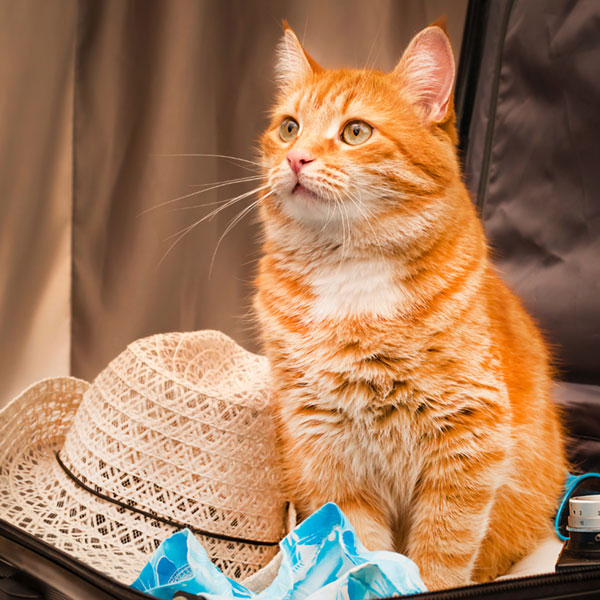
When it comes to vacations, some of us are the type of people who want to plan out every little detail, while others don’t want anything set in stone other than knowing you have a place to sleep at night. Whatever kind of vacationer you are, one thing that you definitely want to organize and plan for is how your cat is going to be cared for while you’re away! What can you do to help your feline companion be as comfortable as possible while you’re gone?
The answer really depends on your individual cat. I will tell you that the absolute ideal situation is to hire a pet sitter who can stay overnight and be present for mealtimes, playtime, and all the ‘normal’ times that you are typically home and spending time around your cat. For some cats, this may be absolutely necessary. My skittish girl, Dany, does not do well with strangers- so if I only had someone come by at mealtimes, Dany would not eat at all while I was gone. She needs someone to be around enough for her to get used to them and feel comfortable enough with them to eat.
If your cats are a little less skittish than my Dany, but still wary of new people, then having a pet sitter come by twice a day to feed, play with them, and scoop litter boxes will likely work just fine. Do your best to get these visits scheduled at the regular times your cats would eat- so if breakfast is at 8 and dinner is at 6, schedule the pet sitter to come by from 7:45-8:30 in the morning, and 5:45-6:30 at night. The less you can interfere with your cat’s regularly scheduled daily events, the better.
What if hiring a pet-sitter isn’t in your budget? Is having a willing friend stop by once a day to feed them adequate? Well, again, it depends on your cat and their individual needs, but in general I would advise against this. Missing out on play time and their regular meal times can really throw a cat off- or if they love sitting on the couch and cuddling with a human, they’re missing out on that opportunity if you’re only having someone come by to throw food in their bowl before running out the door. Having your cat be alone for most of the day also means that it is more likely to be missed if they eat something they shouldn’t, or vomit in a corner, or have a lot of blood in their stool, or pee outside the litter box, or show any other concerning behavior. That being said- if you are taking a short trip and your cat is healthy and relatively confident with strangers, then it’s likely not the end of the world to do this, especially if your friend is willing to hang out for an hour or so and offer playtime or pets to the cat if they want it.
Making sure your pet sitter- whether it’s a paid professional or a friend doing you a favor- has all the resources they need while you’re gone is very important. Having a trusted neighbor or friend with a back-up copy of your house key is always a good idea, in case they get locked out. Write down any emergency numbers- like the vet, and perhaps another friend who could help out if there’s a human emergency that your sitter has to go attend to. Make sure you explain expectations clearly, as far as what needs to be done for feeding, playing, litter box cleaning, etc. In addition to showing them where all the cat supplies are and how to feed your cats, what their favorite toy is, and things like that, you should also have it all written down so they aren’t questioning if you told them to feed a half can or three quarters of a can of Friskies, or if breakfast was at 7:30 or 7:45. Having extra-special toys and treats that your cat loves be readily accessible to your sitter will also help them engage with your cat more, and will help your cat feel more comfortable- which is of course what you’re striving for! Any other special information about your cat should also be written down- do they try to bolt out the door to the backyard anytime it’s opened? Will they jump on the counter and eat human food if it’s left unattended? Dealing with these things likely seems like second nature to you because you’ve lived with your cat for a long time, but a pet sitter isn’t necessarily going to think of them if you don’t tell them.
There are a couple of things that I suggest that you NEVER do with your cat when going on vacation:
-Leave your cat alone for longer than 24 hours. It may be tempting if you are taking a single day trip and will be back in 36 hours to just put out extra food for your cat, but this is a long period of time where something could go wrong or your cat could get into trouble. Their routine is thrown off by you being absent so they may be feeling stressed, and their behavior may be different and they may do something they normally wouldn’t- like chew on something or ingest something and put themselves at risk.
-Board your cat. Putting a cat in a totally new environment with people they don’t know caring for them is one of the more stressful things that could happen to them. You shouldn’t throw both of those things at them at once- a pet sitter may be a stranger, but at least your cat has the familiar environment around them.
Some people may want to take their cat with them on vacations. Whether this is a good idea or not, once again depends on the cat and how much work you can put in ahead of time. With most cats, you can’t just decide one day that you’re going to take them and think everything will go smoothly- but if you’ve invested the time to make sure your cat is harness trained and comfortable going places outside your home, then you may have an ‘adventure cat’ in the making. Having them carrier trained is also essential, as well as knowing how they react to strange humans, or seeing a dog on the street, or having a kid run up to them. You also have to be prepared to bring along all the extra supplies for your cat, including their litter, litter box, food, toys, and more. Taking your cat on vacations isn’t a quick and easy fun thing to do- it takes work to get them ready, but if you are willing to put the time in and your cat is relatively outgoing and confident, then it’s certainly a possibility you can explore!
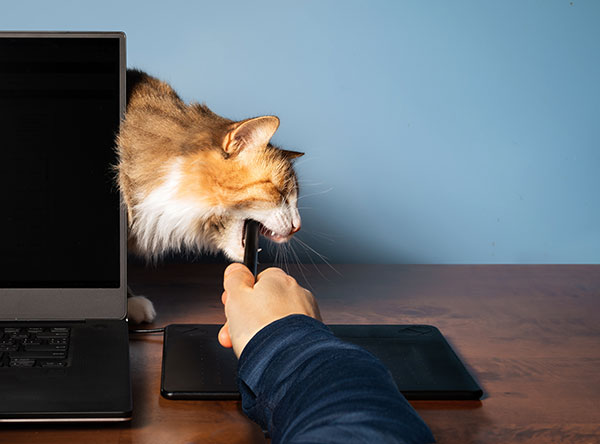
This week I’d like to talk about cats who chew on household items, and how to manage the problem!
First off, you’re going to want to establish if your cat is just chewing on things, or if they are actually ingesting them, the latter often known as pica. Neither is good, but a cat who is swallowing the things they chew on is going to be at risk, and a vet visit is absolutely necessary to check for a life-threatening obstruction. You should also ask your vet about nutritional deficiencies or other possible medical causes of pica. From a behavioral standpoint, there is unfortunately no cure for pica, but it is manageable by cat-proofing the chewable objects in your home and providing some alternatives to chew.
Even if your cat is just chewing on objects and not swallowing them, it’s still not a great problem to have (and accidental ingestion is always a risk). Look at WHAT your cat is chewing- power cords? The edge of your wooden desk? The tassels on your fuzzy blanket? If there is just one type of object that your kitty is affixed on, you can either cat-proof the item, or when not in use, simply put it away in a location the cat cannot get to. For cords, you can purchase cord-covers or secure them to a wall or other cords with zip ties or tape to make them less appealing and harder to target. For couches, table legs, or the like, commercially available anti-scratch spray could also help dissuade them from chewing, and you can try other environmental deterrents like double-sided tape, aluminum foil, bitter apple spray, or other scent deterrents that have been determined safe by a vet. If your cat is a houseplant eater, do a search online and/or ask a vet to make sure your plant isn’t one of the many that can be toxic to felines- in which case it might be time to re-home the plant!
One very common thing that certain cats may adore chewing on is PLASTIC. Plastic bags, wrappers, edges of trash bags, etc. I personally have a cat who loves plastic and has ingested it before- specifically, he ate a chunk off the plastic wrapping of a bundle of toilet paper. There isn’t really a way to ‘chew proof’ plastic, so the best solution for cats like him is to make sure they do not have access to it. Any plastic bags I get at the grocery store are tucked away in a place he can’t reach them. When I buy toilet paper or paper towels, I immediately unpack them into a cabinet and throw the plastic away. When I put trash bags in my bins, I make sure the edges are tucked inside the can so there’s nothing sticking out for him to chew. If I’m eating any candy or other food that comes in a wrapper, I unwrap it next to the trash bin, throw the wrapper away, and put the food on a plate so there’s no opportunity for me to forget and leave the plastic wrapper on a table or on the counter or someplace he could grab it. I recently discovered something I missed, as I heard the unmistakable crunching sound of him chewing on plastic- the tag on an extension cord that has the safety information listed. It was challenging at first, going through my home and figuring out how to secure everything plastic or unpack things to be able to throw plastic away, but it’s become second nature now and it is worth it to secure my cat’s safety and not have to worry about rushing him to the emergency room!
If there’s no known medical cause for undesirable chewing behavior- it’s possible your cat is just bored. Are you having regular play sessions with your cat? Do you have enrichment that piques their interest? Even if your house is literally covered in cat toys, if your cat doesn’t like any of them, they’re going to feel bored. Maybe your cat doesn’t have a nice window seat to watch the outside world, and adding one would make a huge difference. Maybe your cat just wants a paper bag with some catnip sprinkled inside it, or maybe they want some more snuggle time with you. One thing to remember is that chewing is a natural behavior, and your cat does need an outlet to express it, so searching for toys or enrichment that are specifically designed for chewing could help solve the issue. Cat grass, fresh catnip, or silver vine sticks could be appealing to your kitty, and there’s a wide variety of toys meant to satisfy chewing urges. Having these things on hand and redirecting your cat to them if you see them begin to chew on something else can be a huge help.
Cats and water have a complicated relationship. Domestic cats are well known for wanting to stay dry at all costs- many cat people dread the day they may need to give their kitty a bath! However, many cats enjoy drinking from running-water fountains, a trait which stems from the cats they descended from (the African wildcat, Felis sylvestris lybica). The only source of germ-free water available in the savannah was flowing water: streams, rivers, and the like. The cats who drank this water rather than the still water survived longer to pass on their genetics, so their preference has been passed down to our house kitties. There are also many species of wild cats who enjoy going in water as part of their daily routine, including tigers and ocelots. There’s even a feline called the ‘fishing cat’ who has partially webbed front toes to aid in swimming!
Even among our domestic companion cats, there are always some unique felines who enjoy water! I still remember one cat adopted from our shelter in early 2020, originally Desmond but named Buster by his new family- in our shelter, the animal care techs had noticed he liked to put toys in his water dish and play with them, so we gave him a larger container with a shallow layer of water. He would happily walk in it to get a treat or play with a toy! After he was adopted, his family sent us an update that it was part of his daily routine to go and play in their partially filled bath-tub!
One of my own cats, Dany, isn’t a fan of baths- but as you can see in the included video, water falling from the sky seems to be a different story! Whenever it rains, she loves to go out on our balcony and will walk around letting the rain fall on her fur and getting her paws all wet. And then of course she wants to jump in my lap to dry off her damp toes! I’ve seen many cats who love to sit in windows and watch the rain fall, and many who respond positively to the sounds of rain- I’ve used recordings of gentle rain sounds at the shelter to help soothe scared kitties on occasion.
For those cats who may be anxious or afraid about the loud sounds a rainstorm can bring, you’ll want to make sure they have plenty of appropriate hiding spots that they can feel safe in: that is, hiding spots that you could easily extract them from in case of an emergency. Bonus points if you set up their carrier to be a safe hiding spot for them! You can also play other noises that they find less scary to drown out the stormy sounds- like gentle music, or an oscillating fan. While you may feel the urge to comfort your frightened kitty friend, don’t overdo it, as cats will pick up on your feelings of stress and anxiety and can translate it into their own. Do your best to keep to their normal routine, providing food and play sessions at the times you normally would.
If you have your own kitty who loves water in one way or another, I’d love to see pictures or hear their story!
Halloween is just a few days away! Whether you’re having a party or are looking forward to a steady stream of trick-or-treaters, this Caturday I’d like to share a few Halloween safety tips for your cat.
-If your cat is normally allowed outdoors, this is a good night to keep them inside. With all the extra activity that will be going on- more cars driving around and more people walking the streets- it is safer to keep your kitty indoors.
-if your door is going to be constantly opening and shutting as you hand out candy, it may be best to keep your cat in a separate room with a closed door to avoid risking them running outside. Be sure that the information on their microchip is up to date, just in case they do get outside!
-If you’re having a party, this could also be a good reason to keep your cat away in a safe quiet room. Even outgoing cats can be overwhelmed when there are a lot of people they don’t know in their space. Make sure they have access to food, water, toys and enrichment, and a litterbox if you do decide that it’s best to keep them behind a closed door. If your cat is particularly skittish, have a fan running at low speed, or play gentle music softly, as this will help drown out background noises. You could also consider putting up a sign that says ‘knock please’ to discourage people from using your doorbell, since knocking is generally quieter.
-While most cats are not going to be drawn to candy, as sugar/sweetness isn’t appealing to them, you should still keep an eye on any food you have out and make sure your cat doesn’t try to sneak a bite of anything! While your cat may not actually be that interested in the candy itself, they may be interested in the fun crinkly wrappers- especially if your cat has a history of chewing on plastic bags or anything similar, be sure all candy wrappers go straight in the trash!
-Limit the use of cat costumes. While we may think a dressed up cat is adorable, most cats do not enjoy the process of being dressed up, nor wearing the outfit. If you have a relaxed, confident cat who you think may be more OK with costumes, consider working slowly to train them to enjoy the process using positive reinforcement methods, instead of just throwing an outfit on them.
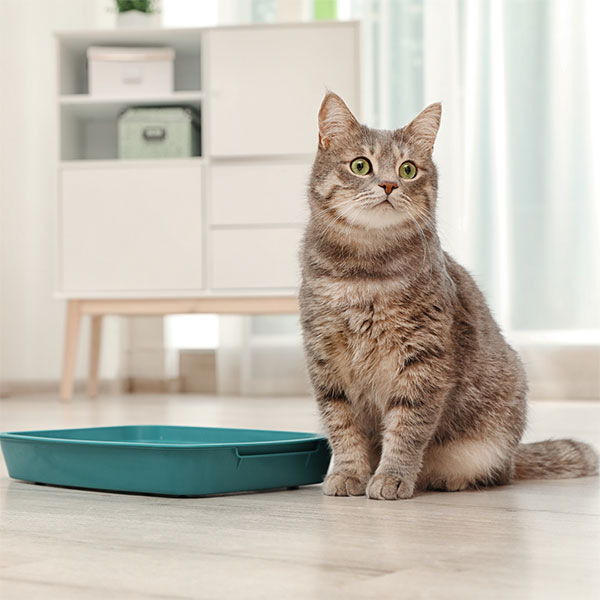
Today I’m going to broach the topic that is one of the biggest sources of frustration for people with cats when it happens- inappropriate elimination. Inappropriate elimination, or IE, refers to when a cat urinates or defecates outside of their litter box- on your bed, on the floor, or on a pile of laundry, for example. While that’s obviously very inconvenient for us humans, a cat engaging in this behavior is sending a message- that something is wrong.
IE is frequently a multi-faceted issue, meaning that there can be multiple contributing factors. Often, there are both medical and behavioral/environmental influences, so it’s important to look at IE from all angles to have the best chance at solving it. The important thing to know is, with rare exceptions, IE CAN be permanently solved. IE is a very common reason that people seek to rehome cats. A lot of people wait to ask for help, and by the time they seek assistance, they have become so frustrated with the situation that they have a hard time putting in the effort it can take to fix things. The longer a cat is engaging in IE, the more of a ‘habit’ it can become for them, which makes it harder to stop- not to mention that if there’s a contributing medical factor, the longer you wait to get it treated, the worse it can get. In other words, there are many reasons that you need to take action immediately if your cat stops using the litter box!
First thing to do is get a vet appointment. There’s a long list of medical troubles specific to the urinary system, but even non-urinary related things can cause a cat to go outside the litter box, so you’ll want to be sure to take notice of any differences in your cat’s behavior, and inform your vet.
As I’m not a medical professional, I’m not going to go into the medical side of things. From the behavioral side- it would be impossible for me to cover every scenario, but I would like to touch upon some very common things that I see being done ‘wrong’ with litter boxes, and other factors that can contribute. As you read through, you may see some things that you notice that you do (or don’t do but should be) but find that your cat still uses the litter box consistently. Keep in mind that just like humans, cats can and will tolerate non-ideal situations for a long period of time- if they hate the litter substrate you use, but the rest of their life is completely fulfilling, they will likely tolerate the litter. However, if something in their life changes for the worse- such as your friend comes to visit with their dog and it chases them, or you start a noisy construction project in your kitchen- it can push them past their stress threshold and they are no longer willing to tolerate the litter. You have to look at your cat’s life as a WHOLE- medical factors, environmental factors, individual personality, etc.- when trying to problem-solve IE issues. And if for whatever reason your cat isn’t spayed or neutered- get that done right away!
-Substrate/type of litter: cats absolutely have substrate preferences. While I would say the majority of cats prefer sand- or dirt-like textures, there will always be outliers, so you can try different kinds to see what they like. It is usually a good idea to change only one litter box at a time, or add a new box with a different type of litter, and then you can see what your cat prefers from their options.
-NEVER use scented litter. Scented litter is designed for humans, not for cats, and while the smell may seem pleasant to you, I promise your cat does not like being right up in it and digging around in it. Felines have a MUCH better sense of smell than humans- they have up to 200 million odor-sensitive cells in their noses, whereas humans only have up to 10 million. If you think the litter boxes in your home smell gross, then you are probably not cleaning them enough. If you find scooping litter is a chore, I highly recommend getting a ‘litter genie’ style device to keep near the boxes- they will save you a lot of individual trips to the trash can.
-Avoid covered litter boxes, and especially avoid automatic litter boxes. Covered litter boxes trap in more scent which is unpleasant to your cat (think port-a-potty), and they can make entering and exiting more difficult, and can make your cat feel less safe while going to the bathroom. Cats don’t care about privacy; they would rather be able to see their surroundings to know that they are safe while they do their business, especially in multi-pet households. Automatic litter boxes are typically covered, and in addition to this, there are a few other things that are bad about them: 1. While the machines themselves are often large, the area inside for the cat to actually go is usually far too small. 2. The noise and motion they make can be frightening to cats; while they are typically designed to do their thing when there is no cat inside of them, machines aren’t perfect and they could activate in error, and even a cat who is just sitting near a box could end up being spooked by them, then becoming unwilling to enter them again. And 3. You should be monitoring your cat’s eliminations. You need to know if they are having diarrhea, or blood in their stool, or if they haven’t pooped in three days, and automatic litter boxes take away your daily routine of checking for these things.
-Make sure the open, uncovered boxes you provide are large enough, and that you have enough litter boxes and spread them throughout your home. Remember when I said cats don’t care about privacy? You should not be tucking litter boxes away in the back of dark closets or under beds- they should be in socially important locations that are easy for your cat to access. This means that yes, you should likely have a litter box in your living room. The general guideline to follow is have one more litter box than the total number of cats you have- so if you have two cats, you should have three litter boxes: perhaps one in your bathroom, and two on opposite sides of your living room, or one in the living room and one in a bedroom. And as for size- sadly, many commonly available litter boxes are too small for the majority of cats. Look for boxes that are labeled as ‘extra large’, or make your own out of a large plastic storage bin- just be sure to remove the lid and cut down at least one side to create an easy entrance.
-Play with your cat! Give your cat enrichment! Even if you have the perfect litter box setup, if your cat is bored or stressed, that can lead to IE as well. You need to set aside time every day to play with your cat, ideally using a ‘wand’ or ‘fishing pole’ style toy, as well as providing them with lots of other options for things to do- cat trees to climb, windows to sit in and watch birds, electronic toys, puzzle feeders, catnip, multiple cozy options for naps… the list goes on. Providing your cat with enough stimulation and enrichment throughout their lives should be at the top of the prioirty list for anyone who chooses to have a cat as a companion. Their presence enriches our own lives so much- I know I am FAR happier having cats than I would be without them- so the least we can do is return the favor!
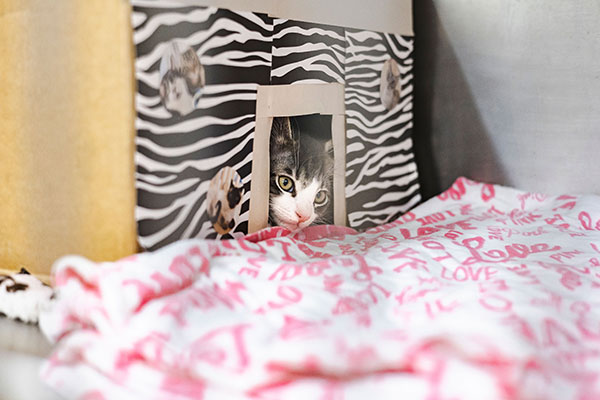
There are times when visitors walk through our shelter and are looking in the cat habitats and wonder to themselves, “where are all the cats?” Our adoption floor habitats are quite impressive- we have tall towers for the cats to climb, a variety of toys, drinking fountains, window views for several of the habitats- and of course hiding spots. Watching cats playing or engaging with enrichment in their habitat is quite fun, but some people may find themselves disappointed that they aren’t able to see all of our cats. After all, having that magical moment where your eyes meet those of a fluffy kitty, and they slowly blink at you as a sign of affection, is what can make some people feel a connection and want to visit with that cat and adopt them. So why do we set things up to allow the cat to remain out of view if they so choose?
The last word in that sentence is the key. One of the most important things that we can do for animals in a shelter environment (or honestly anywhere) is to give them choices. Being able to decide things for themselves contributes to lowering their stress and raising their confidence. If we were to not provide hiding spots for shy cats, and forced them to remain out in the open where everyone walking by could see them, it would increase their fear, anxiety, and stress levels, which are things that we always strive to decrease. More often than not, when shy cats are given the choice to remain hiding in the shelter they will choose to stay hidden- at FIRST. Eventually they will start to come out during the day and not feel as anxious about the things that are happening outside their habitat- because they know that if they need to, they can run back to their hiding spot at any point. Often, one of the first things that lets me know that a shy cat is starting to feel more comfortable here is when I see them out and about in the habitat when I do my morning checks on them. Even though they may still run to hide if I enter the habitat, it’s usually the first step to them feeling much more confident about interacting with humans, and it eventually leads to them coming out of hiding when a person is in the room. Long term, it results in a much more confident cat who is better equipped to deal with stress as it comes up- such as the big adjustment of being adopted and getting used to a new home. You shouldn’t let the fact that a cat is hiding dissuade you from thinking about adopting them- the shy ones are worth the effort (I say as a person who adopted a shy cat who now snuggles in bed with me every night). Also, not every cat who’s in a hiding spot is shy- even very outgoing cats will still sometimes choose to nap in a covered location because it blocks out the light, or feels safer, or is just cozier for them. Sometimes we are pleasantly surprised when we go into habitat with a cat who’s hiding, we sit on the ground, and suddenly the cat pops out of their cubby and is immediately in our lap asking for attention!
Of course, we have portfolios for each cat with their picture and a short description of their personality posted outside of every habitat. This way, even if you don’t see the cat in-person until you’re ready to visit them inside their habitat, you still get to see their cute face and learn a little about them. This information can also be found on the adoption section of our website-except there, we are able to post even more photos, and really, who doesn’t want to look at a bunch of adorable animal pictures? If you’re ready to start browsing and get a look at some of those cute photos, you can view all the cats, dogs, and more here: https://humanesocietysoco.org/available-animals/
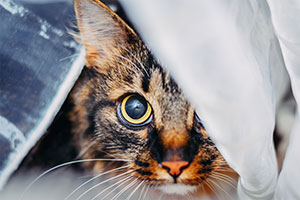
There’s a lot of cats out there who we consider ‘shy’- they take time to warm up to people, hide a lot at first, but are often receptive to petting even before they fully come out of their shell. These cats are what I think of as ‘traditional’ shy cats. However, there are also many cats who seem like they are traditionally shy at first, but very quickly come out of hiding and seem to feel confident and outgoing in their space- except when it comes to being touched or otherwise engaging closely with humans. These cats will come out and walk around near you, but if you stand up too fast, or talk too loudly, or reach for them, they will run away or perhaps give you a little hiss and a swat. I tend to refer to these cats as ‘skittish’. They’re OK being around humans, but they get spooked easily and are conflicted about accepting pets. Shy cats and skittish cat are some of my favorites; their levels of skittishness and/or shyness vary greatly, but regardless of their individual personality, I find that working with them is extremely rewarding. If you are up for offering a little extra TLC and putting in extra time, I highly recommend adopting one. Here are some things to keep in mind to help you grow your friendship with these cats after you adopt them.
When a skittish cat is first getting used to you, you’re going to want to move slowly. It might not seem like it would be intimidating to set down their food bowl at a normal speed, but the slower you move, the easier it is for the cat to predict what you are going to do, and you WANT them to know your every move as it will help decrease their anxiety and stress. Try to move in literal slow motion when you first bring a skittish cat home. Don’t worry, you will not need to do this forever- just until the cat is feeling more confident. It is also very helpful to make sure you are not looming over them. Cats tend to feel more comfortable being approached from below or the same level that they are on, so if they’re in a hiding spot at ground level, the best way to make them feel comfortable is to lie on the ground, rather than standing or sitting above them and leaning over them. Make sure you give them options to climb and get up high, so they have choices and can pick whatever space feels safest to them.
Many skittish cats will not take too long to emerge from their hiding spots and will come up to you, but don’t want to be pet. Understand that hands might be scary to them. For many shelter cats, we do not have detailed information on their backgrounds. They might not have had much prior experience with being pet, so hands are an unknown, frightening thing to them. It’s possible they lived with a child who didn’t know cat etiquette and would pet them a bit roughly. Or perhaps their main experience of being reached for and handled was when they needed to receive bad-tasting medication. Try and look at things from their perspective, and if you can understand that they might have a negative association formed with a hand coming towards them, it can help you be more patient as they learn to trust you.
To help with their fear of hands, or just their fear of being near a human in general, use food to your advantage. Eventually you’ll be able to get your cat to eat a treat right out of your hand, or pet them while they eat, but if you try to start off with that, you’ll likely end up getting scratched or bit. You need to go very slow and first have them simply associate your presence with food. You can do this by sitting with them at meal times and tossing treats to them from a distance. See a good example of what I’m talking about in this video that we posted a few weeks ago starring Abbey, a skittish cat who’s currently available for adoption at our shelter: https://fb.watch/mVU1V71V2_/
As your cat becomes more confident with you, you can ask them to come closer to you to get treats- but remember that part of building trust is showing them that they can walk right up to you and not be reached for or touched. It can be hard to know when your cat is feeling comfortable enough with you; just remember that when in doubt always let the cat make the decision as to if they want to be touched or not- have some treats out nearby for them, and extend your hand so it is available for them, but allow them to make first contact-and if they don’t, don’t try to touch them and just let them enjoy the treats. If you bribe them to come close to you with food, and then force physical touch on them, they’re going to take much longer to trust you.
You can also use something else to pet your cat in lieu of your hand. If they want physical touch and just find hands frightening, then using a stuffed animal or a ‘petting stick’ to touch them can be very helpful (we make petting sticks out of wooden kebab sticks with a large pom pom securely glued on the end). Just keep in mind that you will still need it to be their choice to make contact- you won’t want to take the petting stick or stuffed animal and shove it in their face and immediately start petting them; hold it out to them for them to sniff and decide if they want to touch it or not. If this goes well, long term it usually results in you being able to start by petting them with the object and then transitioning to your hand, but that does take time and patience and you should not expect that to happen on day one!
It is also possible that a cat who is swatting at your hands is not actually afraid of them, but instead views them as a toy. If a cat is taught at a young age to play with hands, this typically carries over into adulthood, and while you might not enjoy the behavior, they see it as completely appropriate because it’s what they learned. While it is a lot easier to discourage this behavior in kittens than adult cats, it can still be managed and they can learn better play etiquette. With cats who show this behavior, it is especially important to give them lots of play time with wand toys, as well as other toys that they can engage with on their own. Ensure that you never entice them to play by waggling fingers or otherwise using your hand, and if they start to bat at your hands- or feet for that matter- stop moving, wait for them to stop what they’re doing, and then immediately redirect them to a wand toy or other favorite toy.
Your cat is never going to completely change their personality- a skittish cat will likely always be skittish to some extent. They may always be afraid of strangers, or spook if there’s a sudden loud noise. But if you can give them a safe home environment and show them that you deserve their trust, they will get better as the months go by, and more likely than not they will form a very strong bond with you. Some cats who have been skittish here in the shelter who I thought would have a long adjustment in a home have completely warmed up to their new people within a week, whereas others can take months. Every cat is different, so they will each progress at their own pace, but the one thing I can tell you for sure is that it is definitely worth the effort you’ll put in!
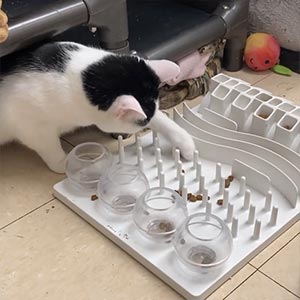
“Contrafreeloading” is when an animal, given a choice between easily available food or food that they have to exert effort to get, chooses the food that they have to work for. Many animals instinctually want to forage for their food, so if they’re given an open dish with their food in it, versus a box with holes cut in it that they have to reach into to get their food, they’ll ignore the bowl and go for the box.
Cats are a species who tend NOT to engage in contrafreeloading. Give them a puzzle feeder and a bowl of kibble, and they’ll likely go straight for the bowl. One hypothesis as to why is that the food puzzles we give our cats don’t necessarily align with the way they would be getting their food in the wild, so the puzzles aren’t activating their instinctual behavior. It’s likely that if we created food enrichment puzzles that were able to allow cats to really feel like they were ‘hunting’, they would be more likely to engage in contrafreeloading. There are some cats who defy the typical though, and will ignore a food dish in favor of a puzzle feeder. While hunting for wild prey, a cat would potentially stick their paws into tight areas or areas where they can’t see very well, in order to try and flush out any prey who may be hiding in that spot- so puzzle feeders that allow cats to use their paws to pull treats or kibble out of things are often a popular choice!
Even if your cat won’t actively choose to use a puzzle feeder over a dish with freely available food in it, that doesn’t mean that there aren’t benefits to using one anyway. There are some cats who will scarf down their food extremely quickly- SO quickly that it comes right back up again. While you should consult your vet if your cat is a scarf-and-barfer to figure out if there’s something else going on, using a puzzle feeder can definitely aid with this problem. It’s also possible that puzzle feeders can help with weight loss. And of course, the general enrichment value of a puzzle feeder shouldn’t be overlooked! Cats need to be engaged and mentally stimulated to keep them happy and healthy, and using a puzzle feeder can be a great way to add more enrichment to your kitty’s world. If you’re interested in using a puzzle feeder for your cat but don’t know how to start, I recommend checking out this website, as it’s a great free resource that shows how different kinds of puzzle feeders work, so you can pick one that you think your cat is most likely to use: foodpuzzlesforcats.com/
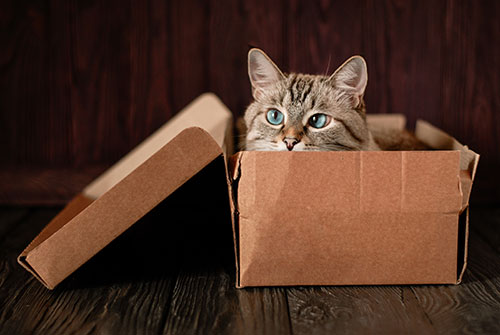
Everyone who has a cat has had it happen to them: they buy their pet some fun toy or a cat tree, bring it home and set it up- only for your cat to go straight for the box it came in instead. So why do cats love boxes so much?
Cats’ affinity for boxes is likely based in their natural instincts. Cats are both prey and predator, and boxes can help fulfill the needs that come with being both of those things. From a prey perspective, a box provides cover from prying eyes- they’re great for concealment. For this exact same reason, cats may also be drawn to boxes from a predator perspective. Most cats are ambush predators, which means they lie in wait in a hiding spot until just the right moment comes, and then they pounce. You can use this knowledge to your advantage during playtime to keep your cat more engaged- if they go into a box, try slowly dragging a wand toy past them and see what happens.
We’ve all seen cats try to cram themselves into boxes that are too small for them. One reason for this may be that they want to get warm. When we cover ourselves with blankets, they help reflect our body heat back towards us- cats may do the same with boxes, and the smaller the box, the better! Your cat may also just be acting playfully- maybe they are sticking their paw in that far too-small tissue box because their instincts are telling them it would be a good hiding spot for a mouse.
There’s also an interesting thing many cats do- they will sit in the illusion of a box. Put some tape on the ground in an enclosed circle or square, and your cat might just go sit in the middle of it. Or maybe you make your bed in the morning, and then set a folded shirt or pair of pants on the blanket only to turn around and find your kitty curled up on top. There are a few hypotheses as to why this may be. One is that cats are more farsighted: they can’t see things well up close. So maybe by just seeing the outline of a ‘box’, they are thinking they are actually inside something that has raised edges. Additionally, when a cat sits on something, it’s their way of ‘claiming’ it. Cats always want their environment to smell like them, so a new object that they can claim in as easy a way of sitting on it is very appealing to them. In the case of clothing, because it smells like their person (you), they’re especially interested in mixing their scent with yours as it helps them feel comfortable and safe.
Don’t worry too much if you get that expensive cat tree and your cat seems to ignore it in favor of a box- boxes are an easy, quick enrichment item that cats enjoy and know what to do with right away, but they can get boring over time. A cat tree is a long-term enrichment investment, and after they get used to it your cat will likely grow to love it. You can help them enjoy their new thing sooner by leaving treats, catnip, or familiar toys on it or next to it, or using a wand toy to encourage them to play on it.
Pretty much everyone has heard a cat hiss at some point. Many times people become concerned if they hear their cat hissing. I’ve heard cats get labeled as ‘mean’ or ‘bad’ or ‘aggressive’ if they hiss. The truth is, ANY cat will hiss under the right circumstances, and today I want you to understand one thing: A hiss is NOT a bad thing.
When a cat hisses, they are saying ‘no’ or ‘back off’ or ‘I don’t like that’. There are many different circumstances in which a cat could hiss; sometimes, we have to work around it- like if a cat is at the vet and they are scared but need an important procedure done- but most of the time, when a cat hisses, it means that you need to listen to them and stop what you are doing. I’ve seen many viral videos where someone is messing with their cat in some way- scaring them with an object, poking them, or holding them in an uncomfortable position- and when the cat hisses, the person laughs and keeps doing what they are doing. I think these videos are the opposite of funny- they are quite mean and sad. I have also seen people respond to their cat hissing by yelling at them, or smacking them gently, as though they believe that the hiss is an ‘incorrect’ behavior that the cat is engaging in. We should in fact WANT our cats to hiss when they are unhappy with what is going on. It’s an excellent form of communication since they probably aren’t going to be able to learn to speak the word ‘no’ anytime soon. If a hiss is ignored, that is often when cats will proceed with swatting, biting, or otherwise attacking- and I don’t blame them for that. If we CONSISTENTLY ignore our cats’ hisses, then they might stop doing them when they are upset- and instead go straight to the biting part. We definitely don’t want to train them to stop communicating!
Cats will, of course, also hiss at each other when the occasion calls for it. Turn up your volume and watch the included video for an example. These two cats are Pirate and Litty, currently available for adoption at our Santa Rosa shelter. They came from the same household and are fine living with one another, but sometimes Pirate spends a little too much time being in Litty’s personal bubble. The way she lets him know that she needs space is by hissing at him- to which he responds with a short pause, then turning and walking away. This is a GREAT interaction- Pirate respected Litty’s wish, and thus the situation was not escalated by either cat swatting the other. This same thing applies to your own cats- I talk to people who are concerned when their cats hiss at each other, and what I always ask is what happens AFTER the hiss occurs. If the cats part ways, then all that happened was likely a play session got too intense for one of the cats, and they told the other ‘no’, and there is no issue if the other cat listens. If the other cat does not RESPECT the hiss and continues trying to interact with the cat who hissed, that’s when there’s a deeper issue that you’ll need to address (and if you’re wondering, some of the main things to do for fighting cats in a household is to increase playtime, increase offered enrichment, and ensure enough resources like food, water, and litter boxes are available for all).
Moral of the story is- respect a hissing cat! Just like we need other humans to respect us when we say ‘no’ to something, we need to respect our cats when they tell us ‘no’ in their own way! They are not ‘bad cats’ or ‘aggressive’ just because they hiss, and we should not treat them as such.
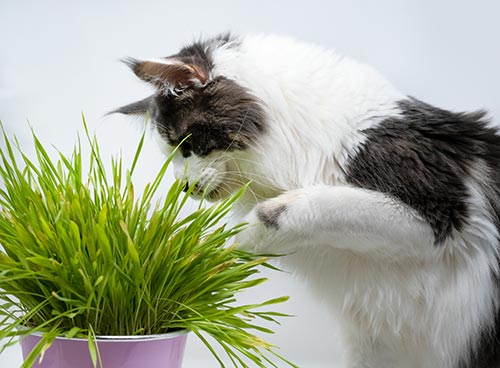
Most cat people have offered their kitty catnip at some point, and their response is usually quite fun to watch! Scent stimulation is often overlooked with felines, and I highly recommend regularly including it in the enrichment you offer to your cats. Here are some things to know to give your feline friend as enjoyable an experience as possible.
- Not every cat will have a response to catnip; an estimated twenty percent of cats will not react at all. If you give your cat a catnip toy and they don’t seem to care, you can try offering dried or fresh catnip, and if they don’t care about either of those, then you likely have one of those kitties who aren’t affected by it. If this is the case, you can try another plant that may elicit the same reaction: silver vine. You can get it in a dried form just like catnip, or as small sticks that your cat may like to chew on. Some cats, however, may not be affected by either catnip OR silver vine.
- If your kitty is one of the majority who does enjoy catnip, it’s a great tool to use to get them interested in something new. Did you just get them a cat bed or a scratching post that they don’t seem to care for? Try sprinkling some catnip on the item in question; it may catch their attention and help them figure out that this new thing is actually really fun.
- If your cat is in need of some extra exercise, giving them catnip before a play session can help them feel extra pepped up and more willing to chase after the wand toy you’re swinging. However, some cats will have the opposite reaction to catnip, and will just want to sit and stare at the wall for a little while, so it won’t work to get EVERY cat hyped up. Once you know how your cat responds to catnip, you’ll know how best to use it!
- If you have a cat who overstimulates easily, or mistakes hands for toys during play time, you’ll want to use caution when offering catnip. Make sure you have a long-handled wand toy on hand so it will be easy to redirect their energy away from you. Having an electronic toy turned on for them can also be a good idea, or directing them towards a kicker or other toy that they can interact with without your hand being nearby. If you have a cat who overstimulates at the drop of a hat, then you may want to avoid catnip entirely.
- If you have recently adopted a shy cat (or even not so recently), I highly recommend offering them catnip on a regular basis. I frequently use it as a tool in the shelter for scared or shut down cats, often with great success. It can make them feel just a little more comfortable, and perhaps more willing to engage with you.
- With catnip, a little goes a long way- no need to offer a giant pile as a tiny sprinkle will usually do the trick! However, you don’t have to worry if you accidentally give them too much, as it won’t harm them- giving them more just doesn’t make them have a stronger reaction. Once a cat has been stimulated by catnip, it takes a little while before it can have an effect on them again. Some cats ‘reset’ quickly and may be ready for more in just a half hour or so, but most cats will take at least a few hours, or sometimes much longer, before they’ll have a reaction again.
Everyone celebrates this day a little differently- cooking food, firing up the grill, having company over- but even if you have zero activities planned, more likely than not, you’ll be able to hear fireworks from where you are- and so will your cat. What can you do to help keep your kitty safe and happy on this holiday?
- We may call this holiday ‘Independence Day’, but this is one day you should definitely NOT let your cat be independent! If your cat typically is allowed outdoors, today is a good day to stray from that habit and keep them inside.
- Now is a good time to double-check on if you have any hiding spots in your house that it would be difficult to extract your cat from, and block them off. If they get scared, they may be driven to hide somewhere they normally wouldn’t- underneath the bed where you can’t reach them; the back of the closet behind a storage bin that they can squeeze behind; the cupboard that has a gap that gives them access to inside the wall. Make sure they have plenty of appropriate hiding options available, like cardboard boxes, cat cave beds, or cat furniture that includes hidey holes. In case of an emergency, you want to be able to easily find your cat and be able to easily get them out! Bonus points if you turn their crate into a cozy place to hang out and hide- nothing makes getting your cat in their crate easier than if they already view it as a safe, comfy spot!
- If you are going over to someone else’s house for a long period of time, do your best to stick to your cat’s routine as much as possible- on a night where there are going to be some frightening noises, having everything else be the same can be comforting. Try to feed them at their normal times, play with them as you normally would, and give them the same kind of attention you would any other day.
- If you’re having people over to YOUR place for a celebration, and your cat is skittish or wary of strangers, loud noises, or both, consider giving them a ‘quiet room’ where they have access to litter, water, food, toys, etc. and keep the door shut. This also can prevent them from dashing outside as you’re opening your front door, or escaping through a patio or balcony if you’re hanging out outside and people are constantly going in and out.
- White noise is your friend! It will help drown out sounds of fireworks, your party, or anything else that may be going on. You can use an actual white noise machine if you have one, or play TV or radio at a low volume, turn on a fan or two, or play gentle music or even cat TV for them on an extra phone or tablet.
- Avoid giving them TOO much attention- if they are scared and hiding and you are fawning over them and over-comforting them, it can serve to increase their anxiety. Make sure you know where they are, offer them the usual pets and playtime and food, but don’t ‘make a big deal’ out of their fear. If you’re free to sit in the room they’re in and read or watch TV or do some other ‘normal’ activity, this can help their anxiety from escalating. Mostly, just let them rest where they feel secure- let them hide. If you discover that this event seems particularly traumatizing to them and they don’t bounce back quickly the next day, consider talking to your veterinarian about behavior medication for other such events in the future.
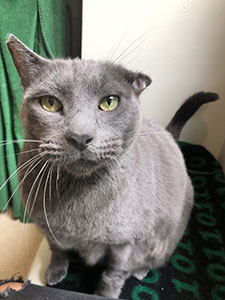
I’ve written posts before about helping shy cats settle into your home, but what about ‘average’ cats? With the exception of some really outgoing and confident felines, all cats are going to take some time to feel at home with you and adjust to their new environment. In the animal shelter world, we have what we call the ‘3-3-3 Guidelines’, which offer generalized information about what you should expect in the first 3 days, the first 3 weeks, and the first 3 months after adopting a cat.
Keep in mind that these are just guidelines- every cat will adjust a little differently. If you do adopt one of those super outgoing, confident felines, they’ll probably adjust much faster; if you adopt a very shy cat, it will likely take them longer. The things discussed here are what to expect for the ‘average’ cat, so don’t worry if your new family member adjusts at a slightly different speed.
First 3 days
What to expect:
The first three days in a new environment can be scary, and your cat will likely be a little on edge, and probably want to hide- yes, even if they were affectionate when you met them at the shelter. They may not eat or drink much, or only at night; if they aren’t eating or drinking, they may not use the litter box, or they may only use it at night or when they are alone. They will not feel comfortable enough to show their true personality.
What you should do:
Keep them confined to a single room in your home. A bedroom, office, or other quiet room is ideal; bathrooms or laundry rooms or other rooms that can be loud and busy are not the best choice. Pick a room that you don’t have a ‘time limit’ on how long they can stay in there; if you have a family member coming to visit in two weeks and will need to be in your guest bedroom without the cat, you should NOT use that guest room as your new cat’s home base! Whatever room you choose, be sure to block off all BAD hiding spots- under the bed, in the back of a closet, and under a couch are all examples of bad hiding spots. You want to offer GOOD hiding spots such as cave-style cat beds, cardboard boxes (you can even cut holes strategically to make an awesome little setup), or even blankets draped over an open-undersided chair. You want to be sure that wherever they are hiding, you will be able to easily find them and interact with them (when they are ready). For these first few days, if your cat is just hiding the whole time, hang out in the room but don’t force attention on them. This is a great time to get them used to the sound of your voice, how you smell, and your presence in general.
Be sure to provide them with everything they need in this starter room: A litter box or two (kept away from food and water); a scratcher; bedding; vertical space like a cat tree; and other toys and enrichment items. Right off the bat, you should try to establish the mealtime routine: I strongly recommend choosing set times each day and offering meals at specific times that you will be able to stick to long term. At least twice a day is what you should aim for; three times a day is even better if it works for your schedule!
First 3 weeks
What to expect:
Your cat should be starting to settle in and adjust to the routine of food; they should be eating, drinking, and using the litter box every day.. They will likely be exploring their environment more, and may engage in behaviors such as jumping/climbing up everywhere they can reach, or scratching furniture, as they learn what boundaries exist and try to make themselves feel at home. They will start to show off their true personality more, will be more trustful of you, and will likely become more playful and be utilizing more of their enrichment (even if it’s only when you’re not in the room).
What you should do:
Continue to hang out with your cat in the room; if they aren’t terribly shy, they will likely be approaching you for attention, or at least willing to let you approach them in their safe spot to give some brief pets (just go slow and let them sniff your hand first, or bribe them with a tasty treat). Stick with the mealtime routine, see if they will engage with you in play, and rearrange the room as needed with anything you’ve discovered isn’t working- maybe you THOUGHT the closet door was securely shut but they found a way to worm themselves inside; or maybe they are scratching an armchair, and you need to try a different kind of scratcher and place it next to that armchair. If they aren’t using enrichment or coming out while you’re in the room with them and you’re a bit worried, check for signs that they are using things: toys being moved around, claw marks on their scratchers, things being knocked off a high shelf, etc. These are all good signs. If they are eating, drinking, and using the litter box during this phase, everything is likely going fairly well!
If your cat is already acting confident, then provided you don’t have any other animals, go ahead and open the door and let them consider exploring the rest of your home. If your home is especially large, or has some rooms that you don’t want to worry about them hiding in, consider keeping some doors shut at first- for example, if they’re in your guest bedroom and your regular bedroom has a REALLY appealing closet with lots of hidey holes, keep your bedroom door shut for now. The most important thing to remember is do NOT shut the door to their ‘safe’ room- that has been established as where they are fed, where their litter is, and it smells like them and is what they are used to. They should be free to run back to it if they get spooked! Never force them to leave the room, either- wait for them to decide to explore on their own.
If you DO have other animals, rather than opening up the house to your new cat, this is when you will likely be able to begin the introduction process, which you can find more information on here: https://humanesocietysoco.org/wp-content/uploads/2022/02/HSSC_Cat-Cat-Intros_2020-12.pdf for other cats, and here: https://humanesocietysoco.org/wp-content/uploads/2020/12/HSSC_Dog-Cat-Intros_2020-12.pdf for dogs. Be sure to wait until your cat seems fairly confident in their single room before you start introductions; very shy cats may take longer than 3 weeks before you can start.
3 months and beyond
What to expect:
Your cat will likely have adjusted to your normal routine of comings and goings, and will expect food at their regular mealtimes. They will feel confident and have a sense of ownership with you and your home, and feel like they belong there. They should be playful and interested in toys and enrichment, and both you and them will feel a bond with the other that will continue to grow!
What to do:
Enjoy life with your new cat! Most cats will be at least fairly well adjusted at the three month mark; you can start to move their things out of their ‘safe’ room and into the rest of your home: establish a new place you want to feed them, put their favorite cat bed in a different bedroom, and their favorite scratcher next to your couch- letting them know that they belong in the WHOLE house, not just their one room! If there is anything extra special you want to do with them- such as harness training so you can take them on walks, or teaching them to high five- this is a great time to start the process, as positive reinforcement training will help solidify the relationship you have been building. If you haven’t already started the process of introducing your new cat to any other animals you have, you should begin! Unless you were told at the time of adoption that this is a very shy or very fearful cat, they should not be spending most of their time hiding (though it is normal for cats to nap or hang out in hidey holes, or get spooked by visitors/events and temporarily go back into hiding). If your cat still seems very nervous, is very wary of any members of your household, or is showing other behaviors that are concerning to you, reach out to the shelter where you adopted them for assistance.
Remember that each cat is an individual and may not adjust exactly along this timeline! It is also important to note that cats are all different in how they show affection- just because a cat doesn’t want to cuddle on your lap, this doesn’t mean there is anything ‘wrong’ with them, and it doesn’t mean you’ve done a bad job helping them adjust to your home- while many cats enjoy cuddling, others can be perfectly content to curl up at the other end of the couch, or come to you for two minutes of pets and then go nap on the cat tree in the corner- sometimes just being in the same room as you, even without interacting, is the truest show of love!
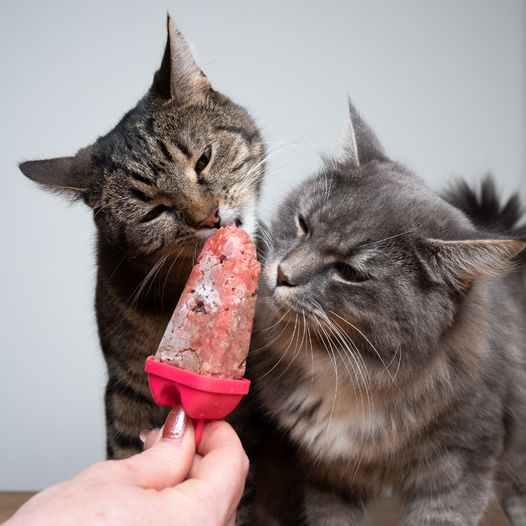
It’s starting to heat up and we’re all looking for a way to cool down, including your cats! While cats can handle warmer weather better than us, it’s still crucial to prioritize their well-being. Here are some do’s and don’ts to help your feline friends beat the heat, along with signs of heat stroke to watch out for:
- Provide multiple water options and ensure it’s clean. Fresh water encourages hydration.
- Gently wipe their body or paws with a damp towel, if they’re comfortable with it.
- Engage them with ice cubes, frozen treats, or pet-safe broth. Placing wrapped frozen water bottles nearby also helps.
- Keep your home cool for your cat’s benefit too. Run oscillating fans, close blinds/windows, and encourage them to stay in cooler areas like linoleum, tile, or hardwood floors. Cooling mats can be placed in their favorite spots. And if you have AC, lucky you!
- Avoid playtime during the hottest parts of the day. Stick to mornings and evenings.
- Never leave your cat unattended in a car, even for a minute or two. The temperature inside rises rapidly and can be dangerous.
- During a heatwave, it’s best to keep outdoor cats indoors, where you can control the temperature and monitor for signs of heat stroke.
✂️ Consider grooming options carefully. Shaving your cat, such as with a lion cut, may not help them stay cool. Fur acts as a natural thermal regulator, slowing down heat absorption. Regular brushing to remove excess fur is more effective in keeping them comfortable.
???? Signs of heat stroke to watch for anxiety, bleeding from the nose, seizures, muscle tremors, dizziness, vomiting, prolonged panting, bright red tongue, dark red or pale gums, weakness, or lethargy. If you notice these signs, administer emergency first aid and seek veterinary care immediately.
???? Emergency first aid steps:
- Move your cat to a cooler location.
- Gently apply cool or tepid water (not ice cold) to your pet’s body and use a fan for maximum heat loss.
- Wet the area around your cat by placing damp towels in their carrier while taking them to the vet.
Stay cool!
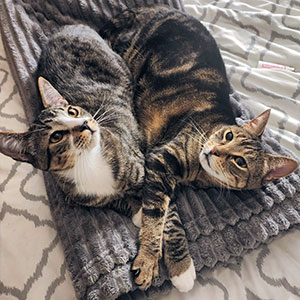
This week I’d like to talk about bringing a new cat into your home when you already have other animals.
Before you decide to adopt a cat when you already have other animals, consider the practical side of things. I am definitely a person that ALWAYS wants more cats- but I recognize I am at my limit in my current living space. There simply isn’t enough space for me to provide enough litter boxes, enough water dishes, enough vertical space, or enough other enrichment to keep more than the three cats I already have happy. Other than the long-term additional supplies you will need to provide for an additional cat, you also have to think about where their initial adjustment space is going to be. Cats are going to take time to settle into their new home, and you’ll need a nice cozy room to set them up in where the other animals in the home won’t have access to them, as even if your new cat is confident and ready to explore the whole house from day one, you will still have to keep them isolated until you’ve had a chance to do proper introductions with your other animals. Many people think of a bathroom as being a good place to set up a new cat; while having them take over your bathroom might not sound inconvenient short-term, you should prepare for the possibility that the room you’re going to be using may be their main base for weeks, or even months, depending on how smoothly introductions go. Bathrooms are also normally not ideal for creating a cozy, safe environment for a cat- it can be difficult to fit a cat tree, a litter box, food and water, hidey holes, and toys. If you’re fortunate enough to have an extra-large bathroom, it could be a good option for your new kitty’s home base, but using a bedroom or office space or something else similar is usually a better choice. (Stay tuned for a future Caturday post that talks more about helping a new cat settle into your home.)
Now, let’s talk more about introductions. Not doing proper introductions between animals is probably one of the most common mistakes people make. People always have this urge to rush through them- and I get it, they are a LOT of work! I think we all have heard an anecdote from someone about adopting a new cat, throwing them into a room with their other cat, and now they’re best friends. This should not be the expectation, and I NEVER recommend that introductions be conducted in this way- there is a serious risk of injury, either to one or both of the animals, and potentially to you as well if you get in the middle of an altercation. There is also the possibility that animals will seem like they are accepting each other at first, because they are confused, in shock, or otherwise just don’t understand what’s going on enough to react to it, and then a few days later issues will arise. The best way to solve problems between your animals is to prevent them from happening in the first place- if you rush things at the beginning and your animals don’t like each other, it can be VERY hard to undo things and start fresh. If you truly do find yourself with two easygoing animals who are going to like each other quickly, then you will be able to breeze through the steps of an introduction. To ensure long-term peace, it is best for both you and your animals to stick to the tried and true introduction method.
HSSC has handouts available that go over the introduction process between cats, and between cats and dogs:
https://humanesocietysoco.org/wp-content/uploads/2022/02/HSSC_Cat-Cat-Intros_2020-12.pdf
https://humanesocietysoco.org/wp-content/uploads/2020/12/HSSC_Dog-Cat-Intros_2020-12.pdf
It’s impossible to say exactly how long an introduction will take, as every animal is different. From what I have experienced, the average amount of time to go through all the steps is 3-8 weeks. You need to take the longer time into consideration when deciding what is realistic for you to do; being pleasantly surprised at the process going quickly is much better than feeling frustrated if you were hoping you’d only have to use your second bedroom as a base for the new cat for a single week. In some cases where a cat is extremely shy, it can take significantly longer for them to feel confident enough in their new space to even BEGIN the introduction process with your other animals. Be honest with yourself, and if you don’t feel you can take on the challenge of integrating a new animal into your home right now, it is 100% okay to wait until you are ready. I am a huge advocate for having multiple cats- once they are getting along and become friends, it truly does add to their quality of life- but if bringing a new cat home is going to make you more stressed, it will probably make your animals more stressed as well. Be kind to yourself, and it will help you be more kind to your animals too!

This week I’d like to talk about why we sometimes choose to adopt cats out in pairs!
We often get cats at our shelter who have already been living together. Sometimes we have information from their previous people, who will tell us how well they get along and if they love being together, but sometimes we don’t have much to go on. Once these pairs have settled into our shelter, we spend a day or two watching how they interact with each other and determine if we think they should stay together. Sometimes it’s obvious that they really love each other- they’ll cuddle, groom each other, play together, and spend much of their time with the other one nearby. However, other times it’s more subtle. Some cats aren’t big cuddlers, but will feel more confident with their friend around. They may hide until their buddy has come out and started to play, and that will signal to them that things are safe and they’ll feel comfortable approaching the human with the toy. Sometimes, they’ll only want to eat if their friend is nearby. We also look for differences in behavior anytime they need to be separated (if one of them needs a medical procedure, or needs to be monitored for signs of illness). If they seem much more shy or withdrawn, or don’t want to eat or play when they normally would, that’s a great indication that they should stay together.
If we’re ever in doubt as to if a pair is bonded or not, we err on the side of caution and keep them together- there are plenty of people willing to welcome two cats into their home! Taking on two cats over one can seem intimidating, and considering the practical things is important: Do you have space for enough litter boxes in your home for two cats? Are you prepared for providing double the food? However, for the day-to-day stuff like playing and enrichment, having two cats who love each other is often LESS work- having another cat around is just about the best enrichment you can provide! Even if they don’t really want to play or cuddle together, just having the other one nearby can be a great comfort. I think we’ve all had a friend in our lives who we like being around even if one of you is watching TV and the other is reading a book- well, cats can share that same sentiment!
Our shelter frequently has cats that we are looking to adopt out in pairs- this information will always be listed in their ‘about me’ section on our website, and can also be found posted on their habitats in our adoption center, so if you’re looking to adopt a bonded pair it will be easy to find that information whether you’re online or in the shelter!
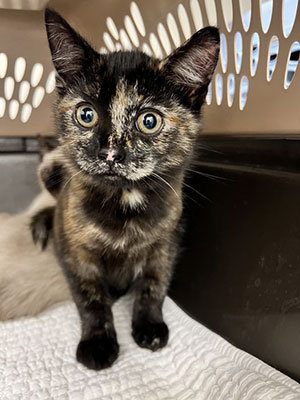
Today, I’d like to talk about things you should do with your kitten that will make your life with them as an adult cat much easier!
As a new kitten adopter, we know you’ll be very excited to spend a lot of time with your kitten- or kittens, as we suggest you adopt in pairs if you don’t already have a young, playful cat at home (you can read my post about that here). You may be wondering if there are specific activities you should engage in with your kitten to help them grow into an easygoing, friendly, low-stress adult cat. The answer is YES! See below for some things to do (or NOT do) with a new kitten to make both their life and YOUR life easier!
-Get them used to a carrier (and maybe even riding in a car)
I suggest you invest in a larger-sized carrier that you will be able to use as your kitten grows into an adult cat- do not expect a fully grown adult cat to use a tiny kitten carrier! Leave the carrier out for your kitten to explore; make it a fun place by tossing toys inside, or leaving catnip or treats for them to find (though keep in mind that kittens under the age of 6 months will not have a reaction to catnip). You can even feed their meals in the carrier if they’re already comfortable with it. Once they’ve become fully comfortable going in their carrier, practice closing the door for brief periods of time, rewarding calm behavior with treats! If you’re feeling ambitious, you could also work on desensitizing them to car rides once they love their carrier; start by just carrying it around your home briefly, then to the car and back, then sitting in park with the engine on, and progress to a drive around the block. Take things slow and make it a positive experience and you’ll be able to reduce the stress of future vet visits or moves for both of you.
-Feed them yummy snacks with a syringe
At one point or another over the course of their life, your cat is probably going to need to take some kind of medication. Many cats will turn their noses up at meds in food, so you may have no choice but to use a syringe or a ‘piller’ tool to get your cat what they need. If you desensitize your kitten to these tools while they are still young, you’re going to have a much easier time medicating them in the future! At least once a day, use a syringe or piller to give them a yummy treat- you could start by just smearing wet food on the tool and letting them lick it off, and progress to putting watered-down wet food or wet food treats in the actual syringe and slowly depressing the end while letting them lick from the tip. Doing this won’t mean they’ll willingly eat yucky-tasting medication, but it can make them willingly come to you when you’re holding a syringe, and you will have a much easier time medicating them! If/when meds enter the picture, be sure to keep the medicating experience as positive as possible- I like the ‘sandwich’ method, where you give them a treat, give them the medication, and then give them another treat.
-Get them used to having their paws touched/nails trimmed
With kittens, it’s relatively easy to just hold them and trim their nails- but as they get bigger this might become a much more difficult task. If you make it a positive experience, they’re going to be much more likely to hold still for their manicures as an adult. Start by just gently touching their paws while they’re eating their favorite snack, and then get them used to having you push gently on the pads to extend their nails. Trim one nail at a time- even just one per day- and give them a treat or other reward after.
-Be consistent about not letting them play with your hands
While it might seem cute to have a kitten play-bite your fingers, it’s suddenly not so cute when they are bigger and are applying more pressure. You should never encourage your kitten to play by waggling your fingers or wiggling your toes under a blanket. Use wand toys, kicker toys, and more to let them get out their urge to pounce, bite, and scratch, and if they ever turn their energy towards your skin, immediately redirect them towards an appropriate toy instead. The most common cause of cats or kittens trying to play with human hands or feet is a lack of playtime- the more you play with them with toys, especially wand toys, the better!
-Harness train them
More and more people are taking their cats for walks- why not be one of them? You can keep your kitty safe while still giving them the bonus enrichment of the great outdoors! While it’s possible to train adult cats to accept harnesses, it’s much easier if you start the process when they are kittens! Go slow and don’t just throw a harness on them immediately; get them used to the harness as an object that just exists near them first, then have them get used to it touching them, having it slipped over their head, having them wear it for only a minute at a time, and so on, offering treats or another reward every step of the way.
-Get them used to strangers
Especially if you just have one or two people in your household, you should try to expose your kitten to other people as well. Invite friends and family over to interact with the kitten after they’ve had time to settle into their new routine in your home. A kitten who is socialized with multiple people as they grow is much less likely to be skittish and fearful as an adult.
Particularly if you have a kitten who’s on the shyer side, make sure not to do too much too quickly. Ease them into all kinds of different experiences, and make it a fun, positive time! For some basic tips on training, read my post about it here. We know you’ll have fun doing new things with your kitty, and they’ll bond with you even more and can grow up into an adult cat who is adaptable and ready for anything.
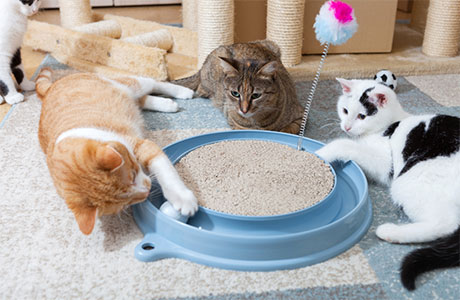
Every cat- kittens, middle-aged adults, seniors, blind cats, deaf cats, cats with three legs- needs to have play time as a constant in their life. Cats are hunters, and it is our responsibility as the humans who share our lives with them to make sure they have appropriate outlets for their natural instincts. Cats who don’t get enough play time can become frustrated, and may express their pent up energy in ways that are less than ideal: bullying other cats in the household, pouncing on feet, knocking things off your nightstand at 3 AM. The solution to pretty much every behavior challenge is probably going to involved increasing play time and enrichment, one way or another.
There is absolutely NO replacement for one-on-one, engaging wand toy play! You will need to make time to do this every single day with your cat. For wand toy play tips, see here: https://humanesocietysoco.org/owner-support/caturdays/#1661791767055-9b0b0a88-b01c
HOWEVER, if you are like most people, you have a busy life. Maybe you have a cat who wants five wand play sessions every single day, and you know you can’t make that happen on days that you work, or are taking care of your children, or have three appointments and have to go grocery shopping. Whatever the reason- whether you have a cat with extra-special play needs, or you find yourself having a lot of busy days lately- what can you do to bridge the gap? How can you compromise with your cat and meet them in the middle to keep their energy needs fulfilled?
This is where ‘independent play’ toys and enrichment items come in. Many cat toys are just simple things like a stuffed mouse toy, or a ball with a jingly bell in it, or a little crinkly mylar puff ball. Maybe you’re really lucky and you have a cat who loves all these things and will go find them and play with them on their own. Most cats, however, will find these objects a little boring when you aren’t available to toss them around and make them seem appealing to them. Read on to find out how to help keep you cat entertained without you having to be there for every second of it!
-Battery powered/electronic toys. There is a huge variety out there! You may need to experiment to find out what your cat likes. There are large ones that have a piece that moves/spins around for your cat to chase (example: Smarty Kat Loco Motion: https://www.chewy.com/smartykat-loco-motion-electronic-cat/dp/130291). There are fish that are motion or touch activated to flop around. There are tiny bug-like things that ‘walk’ around while making a buzzing sound (example: https://www.amazon.com/HEXBUG-Nano-Robotic-Cat-Toy/dp/B00TTU9RAQ?ref_=ast_sto_dp&th=1&psc=1). It can often be helpful to look for toys that don’t run constantly/have timer functions, as your cat is likely to get bored after a little while, and then you aren’t running the battery out for no reason- or you can simply set a timer on your phone so you’ll remember to go back and hit that ‘off’ switch.
-Keep toys in contained space. One main reason why cats may not play with ball toys on their own is because they are so easy to lose- one bat, and suddenly they’re out of reach under the couch or the dresser. A solution for this can be to put that toy in a contained space: a large plastic storage bin, a box, or even your bathtub. I find the bathtub makes an excellent space for kitty play-time, since it is rounded: they’ll bat the ball toy, it’ll roll up the side a bit, and then come rolling right back towards your cat!
-Hang something from up high that dangles/moves easily. There are toys that fit around the tops of door frames (example: https://www.chewy.com/ethical-pet-door-able-bouncing-mouse/dp/56367). These toys aren’t always super secure, but you can always temporarily secure them with some painter’s tape. Toys that hang off door knobs can also work, or toys with suction cups that stick to smooth walls/floor surfaces. You can even take those thin, long paper party streamers and tape them to the ceiling, and set an oscillating fan on them so they will blow back and forth. Just be mindful that if you choose to use a toy that has a long rope/string section, you’ll want to check up on your cat from time to time to make sure they aren’t tangling themselves up in the toy.
-Make meals and treats enriching. Don’t just dump their food in a bowl, give it to them in a puzzle feeder. Some cats can be kept occupied for a much longer period of time if they have to work for their food. A great free online resource to learn about all the different types of puzzle feeders, for both wet and dry food, can be found here: http://foodpuzzlesforcats.com/
-Cat TV. You can create this ‘naturally’, if you have birds/other interesting things to look at outside your windows, by installing perches on windowsills or strategically placing cat trees or even just a chair by a window or sliding glass door. If your windows don’t look out on anything that your cat finds exciting, consider using a phone, tablet, or TV to play some videos of birds, fish, or rodents for your cat. Some cats find these very soothing and will fall asleep in front of them eventually; others can get hyped up by watching them and may require a play session when they are done so they can get the release of catching something. Some cats may try to catch the bird in the screen, so the first couple times you try these videos with them, keep an eye on them so you can see if you need to worry about your TV getting knocked over!
-Rotate your cats’ toys so they don’t get bored. Whatever toys or enrichment items you end up choosing, provide them to your cat on a rotating basis. Humans aren’t the only species that gets bored of the same thing happening over and over. Streamers hanging from the ceiling may be fun for a little while, but it can become ‘old news’ to your cat after a little while, so once you’ve figured out what kinds of independent play your cat likes to engage in, cycle through what has worked so it can stay fresh and new for your cat!
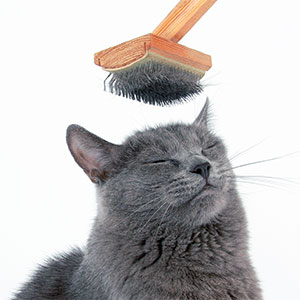
Most people know that long-haired kitties need a helping hand when it comes to maintaining their coat, but the truth is, no matter the length of their fur, every cat can benefit from a good brushing. It can help prevent hair balls, keep your kitty cooler when it’s hot out, help YOU out by reducing the amount of shed hair in your home, and it can be a great bonding activity! Some cats really love being brushed so even if they don’t NEED it, it can be enjoyable for both you and them. Here are some things to consider for grooming your feline friend.
-What type of brush should you use?
There are SO many different kinds of brushes out there, it’s hard to know where to start. Softer, less intense brushes are often a better choice for daily grooming and are a good starting point if you don’t know how your cat responds to being brushed. Brushes that have tines with soft, rounded tips can work well for sensitive cats. Rubber/silicone brushes, or soft bristle brushes, are slightly less efficient at removing hair but work really well for cats who like gentle brushing as a bonding activity with you.
-How often should you brush?
If you’re using a more intense style of brush- one with really spiky tines, or a furminator-style brush that’s designed to cut away the undercoat- you probably won’t want to use it more than a couple times a week, as there’s a chance it could irritate your cat’s skin or remove too much fur. You should always check with your vet if you notice any hair loss or behavior changes (such as abnormal licking or scratching) after regular brushing. With softer styles of brushes, daily grooming is usually fine (and may be necessary for medium- or long- haired kitties, or any cat who is overweight).
-Brushing and overstimulation
Even cats who enjoy being brushed can still get overstimulated from the grooming. This is definitely more of an issue with the more intense brushes, but even with softer brushes, cats can become overstimulated as it’s a different sensation from what they may be used to. You will want to watch their body language to know when you should take a break. If you know your cat gets overstimulated easily, stick with soft brushes and only apply light pressure until you’ve figured out exactly what your kitty thinks about being brushed!
If your cat is one of those who doesn’t necessarily like being brushed, but needs the help maintaining their fur due to the length of their fur, if they are overweight, or have arthritis or another medical condition, you can still brush them- keep sessions short and reward with a treat or a play session with a favorite toy after to help them associate being brushed with positive things.
We have a cat in the shelter right now who absolutely adores being brushed- Maximillion! There’s no better way to make friends with this kitty than picking up his soft-bristle brush and stroking his fur with it. Sometimes he gets so excited by the brush, that he’ll be napping in his cubby and will hop right out if he sees a person holding it! He’s been in the shelter for almost 200 days now waiting to find his fur-ever home, and we hope his purrfect match comes along soon so he can enjoy getting brushed by, playing with, and hanging out with his new best friend in a home!
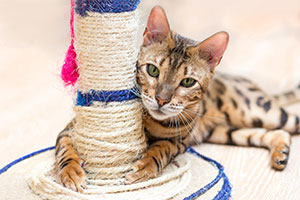
Scratching is a natural behavior that all cats need to be able to engage in. It helps remove the dead outer sheath of their claws as they ‘shed’ them, and is a natural, healthy way for them to mark their territory, both visually and with scent- cats have scent glands between their toes! Sometimes our cats would rather scratch our couch, chair, or table leg instead of the super nice, expensive scratching post we got for them- so what can you do to help stop this?
-Offer different kinds of scratchers
There are two things to look at when picking out a scratcher for your cat: material, and physical orientation. There are lots of different materials your cat may find enjoyable to dig their claws into, and if your cat is scratching something that you’d rather they not, they may be unsatisfied with their current selection. For example, if you have a bunch of really cool cardboard scratchers available that are going ignored, try a sisal rope scratcher instead. As for physical orientation- some cats like horizontal, some like vertical, and some like an angle somewhere in between. If your cat is ignoring the awesome vertical post you bought them and is sharpening their claws on your carpet or rugs, try a scratcher that can lay flat on the ground (or even just lay the post on its side and see if they like that). Some cats like to have a variety, and you should always offer multiple scratching options.
-Encourage your cat to use the scratcher
Your cat may be a little wary of new objects, or not realize it’s there, or simply not know that they like scratching it until they try it. Sometimes you can get a cat to scratch something by simply scratching it yourself, with your fingernails, as they watch and listen. Sprinkling catnip on the scratcher, or leading them over with a treat or two, can also work. Getting your cat to play on and around it is helpful as well, as if they dig their claws into it as part of playing, they’ll be more likely to come back later just to scratch it! Anything you can do to create a positive association with the scratcher will increase the chances that they will use it.
-Number (and location) of scratchers matters
Your cat definitely needs OPTIONS for scratching; one scratcher is never enough. However, if your cat is scratching the couch in the living room, and you add five scratchers to the bedroom, it likely isn’t going to make any difference. Remember that scratching is a way of them marking their territory, so they are going to want to do it throughout your entire home, and especially in the rooms that are important to YOU- the ones you spend the most time in. If your favorite activity is hanging out on the couch reading books or playing video games, you’re going to need scratchers in the living room. If you’re big on cooking and spend a lot of time in the kitchen, you’ll need scratchers in there. I suggest you have at least one or two scratching options in every room in your home.
-Put deterrents on the things you don’t want them to scratch
Cats like to scratch things that they have already been scratching, so if your kitty has been having a good time clawing up your armchair, they may not want to stop even if you have their favorite kind of scratcher right next to the chair. To give them time to focus on their new scratcher and forget about their old spot, put something there that makes them not want or not be able to scratch it. In some cases you may simply be able to block access to the object. There are plenty of products out there you can buy that are meant to deter scratching- anti-scratch sticky tape, sprays, clear plastic covers that are sticky on one side- but you can also create deterrents from things you probably already have in your home. If you don’t have double-sided tape, you can always take what you have and fold it back on itself to create a piece that is sticky on both sides. Securing aluminum foil to the spot they’re scratching can also work. Also explore putting things on the ground in front of the location that your cat doesn’t like to walk on; a cookie sheet, an upside-down carpet runner, or ‘scat mats’ that you can buy. Remember that ‘environmental deterrents’ are the way to go- never use a spray bottle on your cat or otherwise physically punish them for scratching, as these techniques are not only less likely to correct the behavior, but can also negatively impact the relationship you have with your cat.
Most of the time you will only need to use these environmental deterrents temporarily- a couple of weeks, or a month for really persistent cats. If you find that after a while they go back to scratching the undesirable spot again, simply use whatever environmental deterrent worked for them last time, and utilize it again for a short period of time.
-Trim your cat’s claws
Trimming your kitty’s claws can sometimes make them scratch less, or if they do scratch, reduce the damage done. The younger you start getting your cat used to claw trims, the easier it’s going to be for you, but you CAN get adult cats to accept claw trims. There are lots of great videos on the internet that can you show proper claw-trimming techniques and offer tips for getting your cat used to it, and I’ll write a post on this topic in the future!
Last week, I shared how we set up the smaller kennels we have in our shelter; now, I’d like to show you how we set up our larger cat habitats to make our kitties feel as comfortable as possible!
Cat Towers
All our habitats have ‘Kuranda’ cat towers in them. These are easy to sanitize- a very necessary step in shelters to keep our kitties healthy- and provide the cats with vertical space, which is essential for every feline. Many cats feel safer being up high, and for those who like dark, low-to-the-ground hiding spots as they adjust, the lower shelves work perfectly.
Hiding Spots
It’s easy to create nice hiding spots using our cat towers- we take a blanket or two and drape them over the shelves to create a dark, cozy space. The cat can feel safe and secure, and it is still easy for staff and volunteers to engage with the cat by tossing them treats, waving a wand toy nearby, or offering a hand to sniff. We also provide alternatives such as cardboard boxes, paper bags, and hidey-hole cat beds.
Toys
All of our cats are provided with a variety of toys. Wand toys are essential for human-cat interactions, and are kept outside of habitats in between uses to avoid having a cat get tangled up in one. They also have plenty of toys they can engage with on their own- ping pong balls, rattle mouse toys, ball-on-track toys, crinkly toys, cat tunnels, and the list goes on. For our especially playful cats, we provide battery operated toys with ‘timer’ functions, so we can turn them on for some entertainment that doesn’t require a human in the room, before the toy shuts itself off after ten or so minutes.
Scratchers
Scratching is a natural cat behavior, and it must have an outlet! We have specially made carpet-patches that Velcro to the wall, and also give each cat a cardboard scratcher. If they don’t care for these options, we sometimes get scratching posts donated to us, and will use these for our picky scratchers.
Bedding
Remember our Kuranda towers? Well, they’re a lot comfier to lounge on if they have bedding on the shelves, and thanks to a lot of generous volunteers, we have a lot of ‘cat mats’ that have been custom-made to the exact size of the shelves. We also provide soft blankets and comfy cat beds, and even have some self-warming mats.
Grooming tools
Particularly with our long-haired kitties, volunteers set aside time to brush them, but it’s always nice for them to be able to scratch their own itches. All of our habitats are equipped with a ‘self groomer’ affixed low to the ground, and we often see our kitties rubbing up against these and getting rid of some excess fur!
Windows
Many of our habitats have windows that look on to the outside world; these provide sunlight and entertainment! While of course most cats will have a good time watching birds, some of them are also people-watchers. Even the habitats that don’t have a window usually have an indirect window view, thanks to the glass walls in between each habitat, so everyone gets to enjoy some sunlight and a bit of a view.
Crates
A crate is kept in each habitat at all times. In case of an emergency evacuation, it’s important to have one ready to go, and keeping it in the habitat means it will already smell like the cat and will be less of scary object. It also doubles as a hiding spot!
Water Fountains
Every habitat has a water fountain! Most kitties find moving water much more appealing than still water. Some cats even have fun playing with the water. If a cat seems to be wary of the fountain or doesn’t seem to be drinking much water, we make sure we add a regular bowl into the habitat to give them a second option.
Litter Boxes
We make sure we choose the right litter box for each cat- so a senior cat with joint pain will get a very low-sided box, and an extra-large cat will get an extra-large box. The litter box is kept away from food and water, and we will make space to offer multiple litter boxes if we think it is medically or behaviorally necessary (as most cats prefer to have more than one litter box).
We are very fortunate to have our large habitats; many shelters only have the resources to provide smaller kennels, and certain cats are simply not able to thrive in these smaller spaces. We partner with lots of other shelters when bringing in cats, and are often able to take on kitties who are not doing well in the traditional kennel set up. It’s amazing to see a previously shy, shut down, or seemingly aggressive cat transform into a completely different kitty in our habitats.
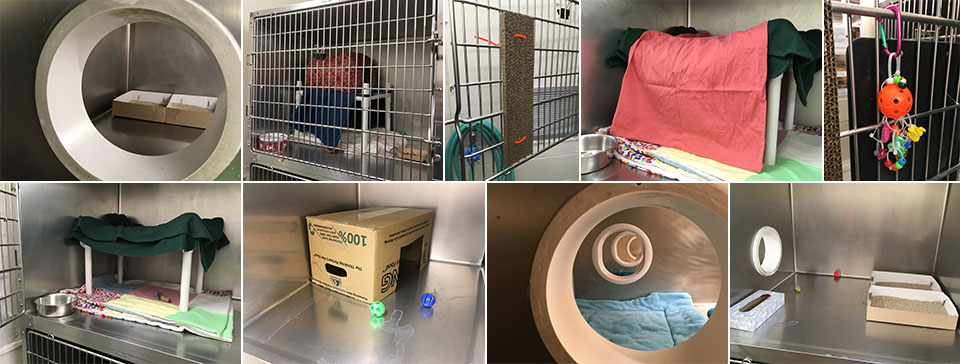
When cats first arrive at our location, typically they will go into one of the kennels in the back of our building- often referred to as our ‘hospital’ area. While many of the cats we receive don’t actually have any health problems, it’s necessary to do basic health checks and vaccinations to make sure no one is contagious or suffering from anything that requires some extra TLC from our medical department. Until we know more about a cat’s medical status, it’s often best to keep them separate from our adoption floor population. These kennels are much easier to sanitize than our larger adoption floor rooms, which means it’s easier to contain the spread of things (such as ringworm) if we unknowingly take in a feline who has a contagious condition. If we get in a really sick cat, they are often better off in a smaller space where there are less variables and it’s easier for us to keep a close watch on them. Cats who have mobility issues will be safer without things to climb on until we’ve figured out how to best help them. Many cats even feel more secure staying in a smaller space for a little while, until they’re feeling more confident.
Whether a cat stays in one of our kennels for a single day, or if it’s necessary to keep them in one for a week or longer, we make sure their stay is as comfortable as possible.
Portals
An essential part of our setup is providing separation between a sleeping/eating area, and a litter box area. We have ‘portals’ installed in all of our kennels so they are at least two kennels wide. If we happen to have extra space, we open up more portals so a cat may have access to three, four, or even five kennels at once!
Hiding Spots
Hanging a towel or pillowcase over the kennel door can work well, but we also provide hammocks (built and sewn by our wonderful volunteers) that they can choose to sleep underneath or on top of. Boxes with creatively cut holes in them make for great shelter for scared kitties, and we also take advantage of covered cat beds.
Toys and other enrichment
Since we’re working with a smaller space, we can’t provide all of the same enrichment items that we do in our larger habitats, so we have some alternatives. A flat cardboard scratcher gets affixed to the kennel door with pipe cleaners, and we have some toys that hang from the door with a carabiner, specially-made by volunteers with beads and zip ties (kittens especially love these). Of course regular smaller toys, like ping pong balls or rattle mice, are put in as well. Stuffed animals are also available for the cats who want something soft to snuggle up to or to use as a kicker toy.
Bedding
Some cats actually prefer lying on the hard surface of the kennel, so while we put in a lot of soft, squishy bedding and often cat beds, we usually leave some of the floor exposed as well so they can make their own choice about where to sit.
Skylights
Most of the rooms with our cat kennels in them have skylights, so the cats still get to enjoy the daylight!
Once a cat is medically cleared to move to a larger habitat, we get them set up in their new space as soon as possible. Sometimes we don’t always have enough habitats for everyone at once, so we make sure to prioritize the cats who are most in need of a larger space, either for medical or behavioral reasons. We also have several staff members who open up their offices to share with our animals when the need arises! We will often make cats available from the kennels too, as it allows us to find their forever homes even faster- who needs a larger habitat if you can go straight to a home? Having both habitats and kennels available to us increases the amount of animals we can save, and we’re proud of the level of comfort, enrichment, and socialization we’re able to offer no matter where they are in the shelter.

Last week, I talked about the perks of adopting a shy cat. Now, I’ll give you some tips for how to set them up for success when you first bring them home.
While almost every cat is going to have some kind of adjustment period when getting used to a new home, shy cats in particular will find the change in environment scary. A lot of times, cats who start off shy in the shelter will become outgoing as they spend more time here socializing with staff and volunteers, so you might be told the cat you’re adopting is shy even when confronted with a seemingly very friendly cat! However, most of the time they will have at least a short period of regression in a home, so it’s important to expect that a cat may be initially more shy in a home than what you experience in the shelter. It’s extremely important to set a shy cat up for success to help them grow confident faster and bond with you sooner.
You should have a single room with a door you can close to start the cat off in; this should be set up before you bring your new cat home. A bedroom or quiet office space is ideal. I usually don’t recommend using a bathroom, as they are usually too high-trafficked and can be a little small, but if it’s your only option and you’re willing to put some effort into the set-up, it can be made to work. You’ll of course need all the necessities in this room- food, water, litter, scratcher, toys, etc. With most shy cats, and ESPECIALLY extra-shy ones, you will want to block off ‘human-inaccessible’ hiding spots. Underneath a bed, high on a shelf in a closet, behind a bookshelf… cats can fit into VERY tiny spots and you want to be able to easily know where they are and have access to the area. If your cat spends all it’s time hiding in a tiny dark hole that you can’t even see, you won’t have as many opportunities to bond with them. And if there’s an emergency and you need to get them out, you won’t be able to.
Instead, give them appropriate hiding spots, and give them more than one option. Use a covered cat bed, a paper bag, a blanket draped over a folding chair to create a crevice underneath, or a cat tree or other cat furniture. Cardboard boxes are also awesome, of course- you can either have them on their side and drape a towel over part of the opening, or flip them upside down after cutting a cat-sized hole or two to provide access. You can and absolutely should use a crate as a hiding spot; keep it covered with a towel or blanket so it’s dark and cozy. Getting them used to the crate as a safe spot will make your life so much easier for future vet visits or moves. Very shy cats should be given a day or two to adjust before trying to engage with them very much. If your cat wants to hang out with you right away, of course indulge them, but don’t be worried if they run to a hiding spot if you shift your position too quickly or if there’s a loud noise. Even if they are pretty friendly from the get-go, you should still give them some time to get used to the room, keeping the door shut, before you let them explore the rest of your house- if you let them out too soon it could overwhelm them and push them back into hiding. Some shy cats aren’t that shy about people, but are more nervous about new environments.
If your shy cat doesn’t want anything to do with you at first, don’t worry. Give them 24-48 hours where you don’t ‘actively engage’ with them too much- you can help them adjust in more subtle ways. Bring them food and place it just outside their hiding spot (but not in it unless they’re not eating anything, even overnight), hang out on the other side of the room playing on your phone, or sit nearby and read a book to them. It can be a good idea to leave low-volume TV, soft radio, or even a fan on, as the white noise can drown out background noises that could make them feel more anxious. After a couple of days, if they haven’t shown any interest in spending time with you, this is when you need to more actively- but gently- begin to interact with them. Continue to spend time in the room talking to them and just ‘hanging out’, but also try to engage them more. See if they want to play: use a wand toy or shoelace and swish it back and forth for them. Even if they won’t play, but will watch it with their eyes, this is still a great sign you’re on the right track. See if they are interested in being pet inside their hiding spot- extend a soft hand and let them sniff it, and if they don’t flinch away from you or hiss, see how they feel about a little cheek scratch. Never start off by touching your cat’s butt or back; this has more of a chance of startling them. Use food as a bonding opportunity; present their food to them at mealtimes and see if they will eat in front of you. You can try putting food in your hand and see if they’ll eat it that way, just make sure you keep your palm flat so they won’t accidentally nip you. You should also offer high-value food, like cat treats or plain cooked chicken. You can also try offering catnip or silver vine, as sometimes this helps shy cats loosen up and relax.
As they start to enjoy interacting with you, push their boundaries a little- hold their favorite treat a little further away so they have to come out of their hiding spot to get it, or swing their favorite toy further away so they have to move to play with it. They will slowly begin to feel more confident and be willing to come out of their hiding spot to spend time with you. Once your cat is feeling relaxed and confident with you and in their room, begin to leave the door open to the rest of your home. If you have a large house, I recommend you keep parts of it closed off so your cat doesn’t have too much to explore at one time- expanding their world too quickly might be too scary for them. Whatever you do, DON’T lock them out of the room you started them off in- that’s their ‘safe zone’ and they should be free to run back to it if they get overwhelmed. It can take a while for shy cats to feel comfortable in a new environment. Some cats progress quickly and feel at home after only a week or two, while others may need a couple of months. If your cat is making slow progress, it doesn’t mean you’re doing anything wrong- they are still making progress!
The number one thing when adopting a shy cat is to be patient. If you’re going to adopt a shy cat, please understand that it can be a time commitment, and most of them aren’t going to become friendly and confident in a matter of hours. Depending on their personality, they may always retain elements of skittishness, and may always be afraid of strangers. But they will love YOU, SO much, and the time you put in to showing them that you and your home are safe for them is 100% worth it. I can personally attest to that, as I adopted a very shy cat a few years ago, and while she can still be skittish and is afraid of strangers, she brings so much joy to my life with her playfulness and her cuddliness.
If you’ve had a shy cat for a WHILE, and they still seem to be lacking in confidence and you need some tips on how to help them feel more comfortable in your home, I recommend watching this Jackson Galaxy video, as he gives some great advice!
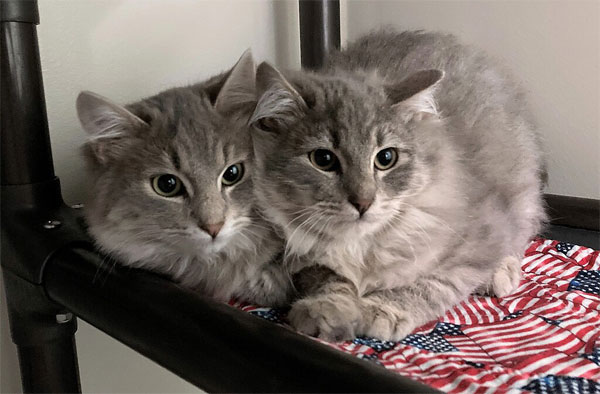
There are lots of outgoing cats out there who adore snuggles from the start and don’t know the meaning of the word ‘shy’- so why should you pick a more timid feline? Well, there are LOTS of reasons!
-Seeing the transformation is rewarding
Shy cats are my FAVORITE, and this first point is the main reason why. Who doesn’t enjoy seeing a being- whether it’s a person, cat, dog, or rabbit- become more confident? We’ll get cats into our shelter who are fearfully hissy, or who won’t come out from under their tower, or run to hide at the slightest movement. We start working with them- then, in a day, or two days, or a week, or a month, they warm up to us. They start enjoying the enrichment we give them. They’ll accept a treat out of a hand. Then they get adopted, and a few months later their adopter sends us a photo of this once-terrified kitty comfortably lounging in their lap, completely relaxed. There’s nothing more gratifying to me than watching their journey.
-They REALLY bond with you
Outgoing cats will love you from the beginning. They will love ANYone as soon as they meet them. There’s absolutely nothing wrong with this of course! Friendly, confident cats are amazing. A shy cat is going to take months to really, truly bond with you. But most shy cats, once they’ve fallen in love with you, are REALLY in love. They don’t want just any ol’ person- they want YOU, because you are the one who has spent all this time helping them and giving them a great life. As a person who has a shy cat, even though it can feel frustrating that I can’t share how amazing my kitty is with most visitors, it really does make me feel special and loved when she waits for them to leave and then immediately comes out and runs to me for some comfort cuddles.
-Every personality type deserves a great home
Of course every cat deserves a great home, regardless of if they are shy, or outgoing, or overstimulate easily! If you have a quiet home or have developed the patience that is well-suited to adopting a shy cat, well, why not? It is ABSOLUTELY an ego-boost to adopt an animal that is possibly a little bit harder to find just the right home for, and I will definitely sing your praises and give you a virtual pat on the back. There is nothing wrong with being proud of helping an animal that others who have noisy households or really busy lives may not be able to, through no fault of their own. Everyone can use the confidence boost that comes from doing something amazing. On the flipside, don’t feel guilty about not choosing to adopt a shy animal if they would not fit in well with your life: you are being respectful of their environmental needs and we appreciate you for choosing to adopt a more outgoing cat!
-Shy cats may be more independent/less clingy
If you don’t want a cat who is always following you from room to room and demanding constant pets, a shy cat may be the way to go. Even though they’ll appreciate a lot of scritches and attention once they’ve bonded with you, they’re used to being independent and most probably won’t mind as much if you have a busy day and can’t spend as much time with them as usual. Or they may be more content to simply sit near you and enjoy your presence even if you’re not actively engaging them.
-Sometimes they are easier to enrich
In a lot of cases, once shy cats have settled into their home, I’ve found that they are incredibly playful! In addition to enjoying interactive play-time with their humans (a necessity for every cat), it often seems to be easier to get shy cats fascinated in other kinds of enrichment. They may enjoy batting toys across the ground themselves- ball toys that will easily roll, or fun ‘rattle mouse’ toys that simulate the feel of real prey can be especially appealing. Many shy cats also respond positively to catnip, ‘cat tv’ videos, or even just sitting up in a cat tree with a nice view out a window. Because these cats used to spend a lot of time focusing on remaining hidden, once they have their confidence, it can be easy for them to find entertainment in the smallest of things.
-They may be more open to living with other cats
While this isn’t a hard and fast rule, cats who are a bit more on the shy side may make it easier to maintain long-term peaceful kitty relationships in your household. Cats who are very confident and outgoing aren’t going to have any problem bullying other cats, staking claim to prime territory and not allowing anyone else there, and in general being pushier with other cats. If you have two of this personality type in one household, it can lead to conflict. If you have two cats who are on the shyer side, they are more likely to be okay with the “that cat tree can be yours, this one over here is mine” mindset. When bringing a second cat into your household, you should always try to find one who has a complimentary personality to the kitty you already have- and of course doing a proper introduction is essential!
We always have at least a few shy cats available for adoption at our shelter. Today I want to bring your attention to Jasper and Sammy! These two are 5 and ½ months old and are growing their confidence a little each day. Jasper is the more outgoing of the two; he’s the first to engage in play, and can often be spotted checking out his neighbor cats or human passerby through the windows of his habitat. Sammy takes longer to warm up but is just as cute and fluffy as his brother. The secret to bonding with these two is simply just FOOD. Jasper and Sammy are both lovers of wet food, or wet food treats, and if you are patient, they will even eat directly out of your hand. While these guys are likely to always be on the shy side, we’re sure they will blossom more in a peaceful home with a great routine and a patient, loving person. If you’re a shy-cat person like me, you’re going to love these guys. You can give our front desk a call at 707-542-0882 to schedule an appointment to meet them!

Happy almost new year, everyone! While you’re preparing to celebrate in whatever way you choose tonight, don’t forget to also prepare for helping your kitty stay safe and happy throughout the night! I have a few suggestions on how to help your cat have a good New Year’s Eve.
-If your cat is normally allowed outside in the evening hours, get them inside early. This is not a good night for your feline friend to be wandering!
-If you are going out somewhere while your cat stays home alone, do your best to still keep to their routine as much as possible- if they are normally fed at 9, maybe consider waiting to leave for that party until AFTER 9.
-Whether you are staying home or not, it can be a good idea to have some kind of gentle noise or music playing to help drown out fireworks, which could be frightening. A white noise machine or fan can work for this.
-Before whatever evening activity starts- whether you’re going out and your cat will be alone while fireworks may be going off, or if you’re having friends over to your place and will be making some noise, be sure to play with your cat ahead of time! This is when you should pull out their favorite toy, their best enrichment item, and the potent catnip. Wear your kitty out and they will be more likely to be relaxed throughout the night.
-If you ARE having company over, or if your cat is particularly skittish or has a history of being afraid of fireworks (or if this is your first New Year’s Eve with your cat and you’re unsure how they will react), it is a good idea to pre-emptively block off hiding spots that are hard for you to access, and make sure you provide your kitty with appropriate hiding spots- like their crate, a cardboard box, a covered cat bed, or a blanket draped over an open-bottomed chair to create a little ‘fort’. In case of an emergency, you want it to be easy to get to your cat, so make sure they can’t get their way to that deep dark corner of your closet or under your bed that you wouldn’t be able to reach!
-If you’re having a celebration with food, party poppers, silly string, or whatever other fun things at your home, as much as you may want to leave the clean-up until the next morning, be sure to throw out or put away anything that would be a potential hazard to your cat before you go to sleep. If you feel bad that your cat doesn’t get any special food, give them a special cat treat so they can be just as excited for the new year as you!
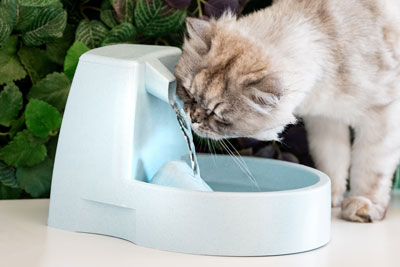
This week I’m going to talk about water consumption! Making sure your cat stays hydrated is a key component of keeping them happy and healthy, as it is a piece of helping to prevent medical problems like kidney disease or urinary tract infections.
Cats typically get a lot of their moisture from their food, which is one reason to consider offering your cat wet food. If you’ve been advised by your vet that it’s really important for your cat to stay hydrated, you can even add water to their food- sometimes heating it up a little and mixing it all together can make it more appetizing. However, there are ways to encourage cats to drink more water.
Many people have witnessed a cat drinking out of a dripping faucet at some point, and there’s a scientific reason for this! Our domestic kitties are descended from the African wildcat (Felis sylvestris lybica), and for them, the only source of germ-free water available in the savannah was flowing water- streams, rivers, and the like. The cats who drank this water rather than the still water survived longer to pass on their genetics, so their preference for moving water has been passed down to our cats. While it’s of course not reasonable to install a stream in your home, there are lots of different kinds of moving water fountains available for cats, and these can encourage water consumption.
Not every cat is going to love a water fountain- some kitties can even be afraid of them. If your cat doesn’t like fountains, or you can’t have one for whatever reason, there are still strategies you can use to get them to drink more out of their regular bowl:
-Make sure the water is CLEAN. Changing it daily may seem like a pain, but it really is important for your cat.
-Avoid putting a water dish near the litter box, and where your cat eats. While the reasoning behind the first one may seem simple, it is not as common knowledge that many cats prefer to have their water far away from their food to avoid contamination.
-If you have more than one cat, you should provide more than one water fountain or bowl in separate areas, to avoid the possibility of resource guarding and ensure that everyone feels comfortable getting a drink.
-Offer your cat a wide, shallow bowl to drink out of. Some cats suffer from ‘whisker fatigue’ and have a painful or uncomfortable sensation when their whiskers touch the sides of bowls. This could also apply to food dishes. Of course, some cats seem to have the opposite preference, and enjoy drinking out of glasses or mugs. Quite often this is because that water is ‘fresher’ than whatever is in their bowl, so if your cat does this a lot it could be a sign that you aren’t cleaning their bowl enough.
-Make the plain water more appetizing by adding some flavor to it. Get pet-safe chicken broth, and add a little to the bowl, or make ice cubes out of it and put them floating in the water dish- some cats may enjoy batting them around or licking the cube, especially on really warm days. If you do add something like this to their water, just remember that it becomes even more important to clean the bowl or fountain on a daily basis!
-If your cat is mainly a kibble eater and isn’t really interested in having canned wet food added to their diet, you could try adding a topper of cat food ‘broth’ treats (or pet-safe chicken broth), wet food treats (like tiki cat sticks or churu), or give it to them separately if they enjoy them enough. Just keep in mind that these things aren’t nutritionally complete, so they have to be an addition to whatever regular food your cat needs, rather than a substitution. And if your cat is on a special diet for medical reasons, be sure to check with your vet before giving them any broths or special treats!
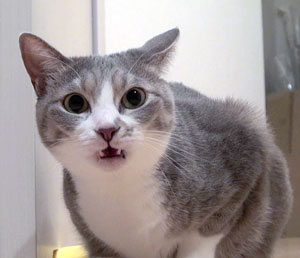
Do you ever see your cat making a weird face- open mouth, weird stare, and kind of looking like they are upset or sneering- and wonder what is going on? This look usually occurs after a cat has smelled something of interest to them.
This face that they are making is called the ‘flehmen response’. Cats (and many other animals) have a vomeronasal organ, often referred to as the Jacobson’s organ, located above the roof of their mouth- and it connects to their mouth near their upper teeth. The purpose of the flehmen response is to draw scent into the mouth and channel it straight to the Jacobson’s organ, giving the cat a direct shot of whatever the scent is and allowing them to know more about it. Since scent is an essential part of a cat’s life, this is incredibly useful to them!
Outdoor cats would predominantly use this to pick up on pheromones- such as those found in urine for marking territory, or for a male cat to identify a female cat in heat- but a cat may have this response to any scent that they find particularly interesting. One of my cats does it quite a bit when she sniffs my shoes after I come home! And, fun fact, there are lots of other animals who will show the flehmen response as well- pandas, horses, goats, hedgehogs, and more!
For those of us who celebrate it, Thanksgiving is coming up! In the excitement of the holiday, it can be easy to forget about any special arrangements you may need to make for your feline friends. I have a few pieces of advice for how to make Thanksgiving cat-friendly! If you don’t celebrate Thanksgiving, then you can think of this as advice for any event where you have visitors and delicious food in your home.
-When celebrating a holiday that involves a lot of food, it’s natural to want your feline friend to join in on the fun! However, you definitely want to be cautious about what food you offer your cat. Rather than giving them human food, you may want to pick out a ‘special’ cat food to offer your kitty instead; something tastier than what they get on a day to day basis. If you really want them to share in some of what you’re cooking, a small amount of unseasoned white turkey meat is probably your safest bet. Ensure that anything you offer them is fully cooked to avoid salmonella, and check for bones as they could splinter and cause GI issues. Be careful not to go overboard; even if the food you offer your cat is completely safe for them, giving them too much of a new thing could give them an upset tummy which could result in diarrhea or vomiting.
-Even if you don’t want your cat to join in on receiving Thanksgiving food, they might have a different idea. When you are making so many delicious dishes, they are often left on the stove or counter for people to serve themselves- but if you turn your back or leave the kitchen, your kitty may be too tempted by the delicious smells and decide to hop up there and serve themselves as well! If I’m going to be leaving a dish out on a counter, I like to take a large pot or mixing bowl and use it to completely cover the dish so I don’t have to worry about my cats getting too curious and helping themselves. Many tasty human dishes contain garlic or onions, which can be dangerous to cats, so be extra careful about leaving anything with these in them out in places that your cat could get to.
-If you’re setting the table and creating a nice atmosphere in your home, you may turn to flowers or other plants as pretty décor. However, there are many different kinds of plants that can be very harmful to cats. This includes the popular holiday flower, lilies. Before you or your guests set out the beautiful flowers, make sure you know what they are and if they’re cat-safe or not.
-If you’re having visitors at your home, the noise and activity may be less happily festive to your cat, and more of a stressful disturbance. Even typically friendly cats can feel overwhelmed if there are lots of people over- especially people they’ve never met before- and different noises and activity levels going on throughout the home can be frustrating to cats, as they thrive on familiarity and routine. Make sure you have a nice area set up for your cat that is off-limits to visitors, where they can eat their food, drink some water, and have some peace and quiet if that is what they want. To drown out background noises, you could leave a fan running, or play some gentle music at a low-volume. And do your best to make some time for your cat during your busy day! Try to stick to their usual routine of feeding, playing, and cuddles if at all possible, as it will go a long way in keeping their stress levels low ♥
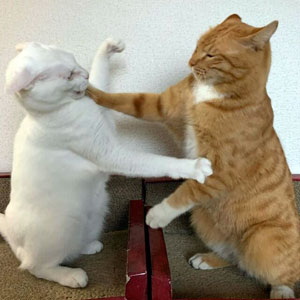
Today I’m going to talk about when cats fight! It could be two cats you’ve had for years- even siblings who grew up together- who have started to fight with each other, or you could have adopted a cat recently, and everything SEEMED to be going well with the introduction process at first- but now, six months in, they’ve started fighting. What do you do?
First off, you should determine if they are actually fighting, or if they are just playing rough! It can be hard to tell the difference sometimes. Since it is difficult to describe exactly what to look for, I’ve found two videos that will help show you.
Video of cats playing: https://youtu.be/l_GQKtA13-w?t=32
Video of cats fighting: https://youtu.be/y8HfHxMqXt0
If your cats are just playing- then no need to do anything of course! They are having a great time with each other.
If your cats are fighting, then I do encourage you to watch the linked video all the way through, as Jackson Galaxy has some great advice in there. Here are some basic things you need to know:
-If your cats are fighting often, you will likely need to do a reintroduction. Cats don’t just work things out on their own. To do a reintroduction, you really do just start from scratch and go through the steps. You can find our guide about introductions here: https://humanesocietysoco.org/wp-content/uploads/2022/02/HSSC_Cat-Cat-Intros_2020-12.pdf
-Try and figure out why the fighting was happening so you can avoid the situation repeating itself. If you go through the steps of reintroducing your cats, but you don’t fix the underlying issue, then they are likely to wind up back at ‘fighting’ again. One common thing that can lead to fighting is not enough stimulation/playtime; if one cat isn’t having their energy and play needs met, they may turn that focus onto the other cat and end up taking things too far. You should be playing with your cats every single day, and if there is one cat who is consistently the aggressor against the other, take special care to ensure that cat gets enough playtime with you! Wand toys are your friend, as are any toys that they like to engage with on their own- kicker toys are often especially great at letting a cat get excess energy out.
Lack of resources (such as litter boxes, water dishes, highly valued napping spots, etc.) is another extremely common thing that can lead to fighting. You should make sure you have plenty of litter boxes (at least one more than the total number of cats in the home), and make sure they are SPREAD OUT- having 3 litter boxes right next to each other is basically the same as only having one litter box. Make sure you have more than one water dish or fountain, plenty of scratchers and nice napping spots, and enough vertical space for all the cats in the household to enjoy at the same time. If your cats have issues surrounding food, plan on having separate areas for mealtimes- someone can get put in a bedroom, another one in a bathroom, until they are done with their food.
What about those times where you really aren’t sure if the cats are fighting or playing, or if they start off playing and it turns into fighting? Or maybe they are fine most of the time but every once in a while they get in a bad fight? Of course, you will want to intervene in the moment to break it up. Don’t insert yourself physically between the cats, as you could end up getting hurt- sometimes all it takes is clapping loudly, or stomping your feet, or raising your voice, to startle them into ending the fight- then you will want to give them some solo-time for them to cool down, taking the time to play with each of them separately so they have a healthy release for their energy. You can also use visual barriers to break up a fight- even something as simple as a flattened cardboard box can be held in between the two cats to break that eye contact.
If you’re concerned and unsure if you need to do more than in-the-moment intervention, what you should do is look at the overall behavior of the cats. Is someone eliminating outside of the litter box? Are appetites decreasing? Does one of the cats spend much of their time hiding under a bed or in a closet? Do either or both of the cats slink slowly around the house, tail down, not showing confident body language? Have you noticed any other behavior changes? If the answer to any of these questions is ‘yes’, then that means you really do need to take this seriously, and address the underlying issue and possibly conduct a reintroduction. If, however, the cats seem to be content with the rest of their lives- show positive body language, eat, drink, and use the litter box without issue, engage in pets and playtime as normal- then you likely have two cats who get along fine and just sometimes have a play session that is too rough for one of them. Just be sure to keep a close eye on the situation in case it starts to get worse! The faster you are to intervene in a bad situation, the easier it will be to arrive at a solution.

Throughout history, various cultures have viewed black cats in different lights- either as symbols of bad luck or evil omens, or in others as a sign of good fortune! Of course, none of these seem to have any scientific basis; as Groucho Marx said, ‘a black cat crossing your path signifies that the animal is going somewhere’.
Somewhere among all the good and bad myths about black cats, many people have become afraid that black cats who are adopted out in October- close to Halloween- may be mistreated in some way. Thankfully, this does not appear to be true. The number of black cats adopted in October are comparable to the number adopted at any other time of year, indicating that there is no influx of people seeking them out for nefarious purposes, and there is no evidence to suggest anything negative is happening with owned black kitties- there is no increase in the number of missing black cats that are reported, or animal cruelty reports, or anything similar.
There’s also the idea that year-round, black cats are less likely to get adopted than cats with other coat colors. A study conducted by the ASPCA revealed why we might perceive it this way- because there are simply MORE black felines than there are cats with other coat colors. This can make us feel like black cats are getting left behind, even when they are not! For example, let’s say a shelter takes in 10 cats- 8 of them black, 2 of them orange. Within the next week, 5 cats are adopted: one orange, and four black. This still leaves behind four black cats vs. only one orange cat, which can make us perceive that people are viewing them as less desirable, even though more black cats got adopted than orange kitties!
So, the great news is, we really don’t have to worry about black cats in shelters any more than we do any other colors of felines! However, I’m certainly still going to encourage you to adopt a black kitty, and we happen to have some right now who are waiting for their forever homes.
Storm and Midnight are two adorable cats available for adoption at our Healdsburg shelter. They’re barely out of kitten-hood at 6 months of age! Though they may have started off shy with us, they’ve blossomed into snuggly, energetic kitties who love people. You can find out more about them by calling us at 707-431-3386 or reading about them on our website: https://humanesocietysoco.org/pets/storm-the-cat/
This week, I’m going to talk about ‘chatty cats’- those who meow a lot!
Meows can be absolutely adorable. It’s neat to hear the different voices of different cats, and having your cat ‘talk’ to you can be lots of fun! However, a cat that is constantly meowing may have something else going on, and it may get frustrating for you at times.
Is your cat fixed?
Unaltered kitties will be more vocal, especially when it comes to mating behaviors and when searching for a mate. There are so many reasons to get your kitties spayed or neutered- don’t hesitate!
Vet checkup time!
If your cat’s vocalizations have recently changed in type, frequency, or volume, a vet checkup is in order. There are several different medical reasons a cat could be vocalizing more than they used to. Be sure to take note of the context and details of the vocalizations to tell your vet- does it happen right after they eat? After they use the litter box? Is it a meow, or more of a wail? If you aren’t confident in your ability to describe the sound, you can always try and get a recording on your phone.
Stress/Anxiety
If your kitty has been meowing or crying more frequently recently, but gets a clean bill of health from the vet, then the answer could be that something in the environment has changed that is causing them stress. Did you just rearrange your living room? Is there construction happening on your street? Did new neighbors move in who have a barking dog? Try to identify what you think could be causing your cat anxiety, and do what you can to help them. Playing soft music or having a fan running can help drown out outdoor noises. If the noise won’t be going anywhere anytime soon, you could also work on desensitizing them to it by getting a recording of the sound, and playing it at a soft volume while you play with them, give them treats, etc. and slowly increase the volume over time. If you rearranged a room in your house, make it a positive place for them by putting in blankets or cat beds that smell like them, playing with them in there, giving them treats, etc.
These are just a couple examples of things that could be making your kitty feel stressed; don’t be afraid to get creative in your thinking. Extra-sensitive cats may even get temporarily upset over small changes, such as a water dish being moved to the other side of a room.
Attention-seeking
One reason a cat may meow will be because they want something. It could be pets, it could be food, or they could be after playtime. If you think this is the case, then the reason your cat is continuing the behavior is likely because you are inadvertently rewarding them for meowing. What you’ll need to do is ignore the meows and reward the silence. Do they meow incessantly while you’re preparing their food? Wait for a moment of silence before you put the food bowl down. Do they meow and paw at you when you’re working on your laptop until you pet them? Ignore them until they take a break and sit quietly next to you, and then lavish them with pets. As a cat-parent, your first instinct is usually to run to your baby and give them whatever they want when they meow to you in their adorable little voice, but if you don’t want them to meow at you all the time then you will need to be consistent with your responses. If your cat is keeping you up at night with their meowing (or other activity) I recommend reading this previous post I wrote: https://humanesocietysoco.org/owner-support/caturdays/#1660850808545-5f89e550-2b69
Personality
Sometimes, there isn’t an external reason for a cat to be meowing all the time. Some cats just really like to talk! If you have one of these cats, there isn’t much you can do about it. You can probably still reduce the frequency using the suggested techniques in the attention-seeking section, but there is no real way to change a cat’s personality- and honestly, we wouldn’t really want to anyway!
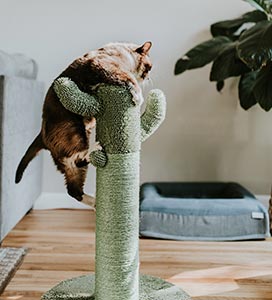
Cats are, without a doubt, interested in climbing and exploring everywhere they can. This of course includes areas where many people would rather they not go: the kitchen counter, or maybe the dining room table. So how can you dissuade them from going in these areas?
Most importantly, you need to make sure that you don’t give your cat a compelling reason to go on the counter. Don’t leave any food out, not even little scraps- cats have an excellent sense of smell and will know!
Many people turn to a spray bottle to deter a cat from a certain action. I caution you against this, because more likely than not all your cat would learn from this is not to do that thing when you are around. They’ll connect the action of you picking up or shaking the squirt bottle with being sprayed, but they won’t necessarily connect their action with the consequence. It’s also possible that over time, this could have a negative effect on your relationship with your cat.
Instead, I advise you to use much more effective environmental deterrents. What this means is that you will leave something on your counter that your cat doesn’t like for them to ‘discover’ on their own. Whatever environmental deterrent you choose, it should not need to be a permanent measure. You may only need to use it once, or maybe for a week, or perhaps longer for very determined cats (or intermittently for those who will try again every once in a while). As for what you should use, there are a variety of things you can try. If you know of an object or material that your specific cat hates (that isn’t harmful, of course) then go ahead and use that! If you’re not sure what to try, here are some suggestions:
-Aluminum foil
-Tape with sticky side up
-Motion activated air-spray (one brand example is Ssscat)
-Citrus scent
-Overlapping cookie sheets that will ‘clatter’ when your cat jumps on them
-A light coating of water that will get their paws wet
-A small but bright motion sensor light, if your cat is doing this at night
You also need to remember that no matter how many environmental deterrents you try, they aren’t going to do long-term good if your cat doesn’t have appropriate spots to climb and get up high. Note that I used the plural here, as more likely than not you will need to provide more than one thing to climb, especially if you have multiple cats. Cat trees can be expensive- less so if you are willing to purchase them unassembled and do that work yourself- but they are not the only option. Basic sturdy shelves, if installed securely, can create a wonderful little ‘stairway’ for your cats along a wall. Window hammocks/shelves specifically designed for cats can also be great, though I do recommend the ones that attach to the sill with screws rather than suction cups on the window. Even just clearing off the top of a bookshelf can provide a great perch for your cats as long as they have the means to get up there. The more of these climbing spots that can be next to windows, the better! Some cats like to have something in the corner of a room that is frequented by your household members, so they can stay above the activity but still watch everything that happens. Do everything you can to make these climbable spots appealing to your cats- leave treats for them to find, sprinkle them with catnip, or give them lots of pets up there if they find attention reinforcing. If you combine creating positive associations with the areas you want them to climb with temporary environmental deterrents in the areas you’d rather they not, your kitty will likely no longer feel the need to jump on your counter.
Today’s Caturday post is just a feature for three of our adoptable undersocial kittens- Dragon, Big Foot, and Stouffer- but I thought you might all like to see how cute they are and how much progress they’ve made from the hissy, scared kittens they were when they first arrived.
Today, I want to talk about a cat’s sense of smell. Scent is a very important tool for cats. While humans have about 5 million olfactory sensors in our noses, cats have an estimated 45 to 200 million!
By understanding how cats use scent, you can help make your cat more comfortable and less stressed, AND avoid unwanted behavior such as furniture scratching and urine marking.
Cats really want everything in their environment to smell at least a little bit like them. They use their scent to claim ‘ownership’ of an object, or a person, and we WANT them to do this because it shows that they are feeling confident and comfortable. Cats have scent glands all over their body- on their face, their paws, on and around their tail- and they use these to deposit their scent all around them. When you come home and your cat runs up to you and rubs their head against your leg, they are basically saying ‘hey, I love you, you belong to me.’ They will rub their face and body against chairs, table legs, whatever cat furniture you have, and anything available to them in areas that they frequent and want to feel comfortable in. When a cat scratches something with their claws, they are depositing scent. When a cat sleeps on their favorite blanket or your pillow, they’re depositing scent. This is all great behavior that we want to see in our kitties!
Most people don’t want their cat to scratch the couch or their favorite armchair. The thing to understand is that to your cat, this is perfectly reasonable behavior. This area is important- to you, AND to them. It is only natural that they will want to ‘claim’ it. So rather than trying to get kitty to leave the couch alone and go to the scratching post on the other side of the room, you will likely have more luck putting a scratcher right next to the couch they like to scratch, as well as putting a temporary deterrent such as sticky tape or aluminum foil on the couch- so this way you are giving them a ‘no, don’t scratch this’ while at the same time giving them a ‘yes, do scratch THIS thing which is right in the same area’. If you put a blanket on the couch that they like to sit on, this is another way for them to have the area smell like them (by simply lying on the blanket), and they may feel less of a need to scratch there.
Urine marking is, of course, another ‘natural’ way for cats to deposit their scent around their territory- but it doesn’t mean we want them to do it in our home! An altered cat who is using urine to claim their territory is not a confident, comfortable cat- they are likely feeling anxious or stressed which is why they are using such an extreme measure to try and make themselves feel better. You can help your kitty by making sure there are lots and lots of ways they can confidently mark their territory with just their scent glands. In addition to scratchers, which I’ve already touched upon, make sure there are plenty of ‘soft’ materials all over for your cat, as these hold scent well for kitty’s purposes. You could use cat beds, or fuzzy blankets, or pillows, or towels. Of course carpeted cat furniture works very well. You also have to be sure that you aren’t cleaning these objects too frequently- if your cat has a favorite blanket, but you’re washing it once a week, you’re removing their scent over and over again. In other words- having cat hair on your stuff is good! Of course, if your cat is spraying out of anxiety or stress, there is likely an underlying reason and you will need to address that as well as giving them better options to mark their territory.
A cat’s excellent sense of smell is why we should avoid scented litters, too. Whatever scent the litter has added to it, while it may smell pleasant to us, that scent is amplified for the cat and can lead them to dislike their litter box so much they will choose someplace else to go. It’s also why litter boxes need to be frequently cleaned, and why covered litter boxes should be avoided: imagine if the only bathroom you got to use, every single day, was a dirty port-a-potty.
Scent is also very important when it comes to introducing your cat to new animals. If you bring another pet home, one of the first things you should do to help them get comfortable with each other is give them things that smell like the other one, and make their interactions with the scent a positive experience by feeding them treats or playing with them on and around the object.
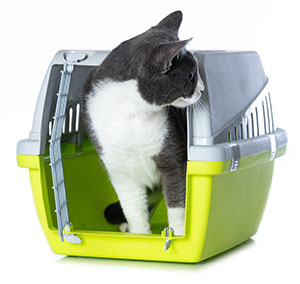
Whether it’s a routine trip to the vet, an emergency evacuation, or time to move to a new home, one of the most stressful parts of having a cat can be getting them in a carrier when they don’t want to be there- not to mention keeping them relatively calm when they’re inside. It doesn’t have to be stressful! I strongly recommend that EVERY cat should be taught to like their carrier- or at the very least, they should not be actively afraid of it.
A big reason why many cats are afraid of carriers is because the carrier is only ever used when something negative is happening to them. My first suggestion for cats who don’t like going in their carriers is simple desensitization. Find a place in your home where the carrier can stay out all the time. Make it cozy with blankets inside and over it, feed the cat next to it (and then inside of it once they’re comfortable with it), leave treats and catnip inside for them to find if they choose to check it out. Most cats LIKE resting in cozy dark places, and a carrier can make an ideal napping spot. If it’s a regular, everyday object to them, they won’t only associate it with vet visits or being loaded up in a car for a long period of time. For a lot of cats, this is all you need to do.
However, this may not be enough for every cat. Sometimes they view their carrier in such a negative manner that even if they are desensitized to its presence, they will not want to go inside- or maybe they’re okay with that, but will go into a panic the second you close the door and pick it up. If you start slow and progress using small approximations, you can train your stressed kitty to accept their carrier, or perhaps even like it.
-Get a new carrier
This isn’t always necessary, but sometimes it can help to have a completely fresh start. Maybe there’s something about the style of carrier you’ve been using that your cat hates. Maybe it was peed in by another cat once a really long time ago and your cat can still smell it. If they have a negative association with THAT carrier in particular, getting a new one can make a big difference. Size of carrier is also important- some cats may prefer small carriers as they feel safe in a very enclosed space, but those who are more on the side of hating carriers tend do better with larger carriers. You can even consider getting a dog-sized carrier for your cat.
-Disassemble the carrier
If your cat is completely panicked by carriers then it can help to get the kind where the top half is removable and introduce your cat first to only the lower portion of the carrier. Feed them next to or on it, sprinkle catnip, do all the same things you would do with a ‘whole’ carrier. Once they’re comfortable with that, put the top back on, but leave the door off- and then once they’re comfortable with that, put the door back on!
-Get them comfortable with you shutting the door
Just because your cat is comfortable going in their carrier doesn’t mean they’ll be comfortable inside with the door shut. Once they will reliably go inside for treats, a toy, or whatever works for you, teach them that the door shutting doesn’t mean bad things are going to happen. You may need to start off by simply touching the door with your hand while they are inside, and rewarding them with a treat if they don’t move. Then, progress to closing the door partway and rewarding them, and work your way up to closing and latching it. Listen to what your cat is telling you- if they stop wanting to go in the carrier, then it means you’re moving too fast for them.
-Get them used to the door STAYING shut
Start small- keep the door shut and feed them a steady stream of treats for five seconds, or give them scritches through the grating, and then open it up. Slowly increase the amount of time you leave the door shut, and cut back on how much you give them attention while they’re in there- ideally, you want them to be able to remain calm in their carrier even when you walk away from them.
-Get them used to the carrier being moved
This works in much the same way as the previous step, using small approximations. Pick up the carrier for half a second, set it down, and reward your cat. Slowly increase the time you spend holding, and then walking around, with the carrier. It’s very important to hold the carrier properly- I always tell people to pretend that the handle that most carriers have on top doesn’t even exist, and pick up the carrier from the bottom so it’s held securely to your chest, rather than dangling at your side and bumping around with every step you take. This will keep your cat more comfortable and will decrease the chances of them disliking rides in the carrier.
Not every cat will require more extensive training, but for those extra-anxious kitties, putting in some additional work to ease even a little of their stress can make a world of difference. If you’re feeling REALLY ambitious, then after successfully carrier training your cat you can even work on desensitizing them to riding in a car!
Lola, one of our available for adoption cats, is a great example of a cat who is comfortable with their carrier:
https://youtube.com/shorts/ZwtIxBr1ts4?feature=share
I never did any kind of ‘formal’ training with Lola- the carrier is simply left in her habitat, and Kelly, who took the video, had NO trouble getting Lola to go inside despite the fact that I don’t think she has ever crated Lola before!
Environmental Enrichment
The last two weeks, I’ve written about how to play with your cat, suggesting everything from wand toys to bubbles. This time, I’ll be talking about a few other kinds of enrichment you should be offering to your cat! You can think of these things as ‘environmental enrichment’- things that you set up for your cat to enjoy that don’t require you to be there to actively engage with them.
-Cat TV
The best cat TV is simply a window your cat can sit in that has a view of the outside world, ideally with trees, birds, etc. for maximum entertainment. If you aren’t fortunate enough to have a view that is entertaining enough to your cat, you can go with literal cat TV- YouTube has lots of videos of birds, mice, fish, etc. Depending on how playful your cat is, though, you may want to avoid putting this on your big flat-screen TV, in case they try to ‘catch’ the pray and end up knocking the TV over. Small tablets or phones can work better for these high-energy kitties. Be sure to have a play session with them after their screen-time is over, to avoid any frustration they may be feeling from watching things that they aren’t able to catch- though some cats may find the experience relaxing and may go right into nap-time!
-Cat trees and other cat furniture
What you want to go for when picking out cat furniture is 1. Vertical space and 2. Hidey holes, ideally with multiple exits.
Number 1 is important for every single cat. I cannot stress enough how essential vertical space is to help cats feel safe, relieve stress, and improve their overall quality of life. It also links back to cat TV because putting up a cat tree or shelf right in front of a window is perfect for your cat. However, there are plenty of other places to position cat furniture. In a perfect world (according to cats), there would be enough shelves and furniture throughout every room that a cat could navigate across the entire house without ever touching the floor. I don’t know that we can always live up to their standards, but we can at least meet them halfway!
Number 2 is something to focus on for cats who are more of the ‘wallflower’ types, when you are trying to boost their confidence and comfort level. While vertical space will definitely help these cats as well, giving them ways to move across a room ‘unseen’ will encourage them to come out more. When choosing these items, if you have multiple pets, remember that your cat doesn’t want to be cornered- many cat cubbies only have one entrance/exit, meaning that if your cat goes inside and then something scary comes towards them, they are trapped. Getting tunnels, or cubbies that have multiple entrances and exits, can help solve this problem and give them a way to move across the room while still feeling protected. They can also be lots of fun during play time, whether your cat is shy or not- most cats really like being ‘hidden’ and then jumping out to pounce on a toy.
-Scratchers
Many cat furniture items can double as scratchers, but since cats have different preferences for what they scratch, you might want to branch out a bit. Disposable cardboard scratchers are often a favorite, and you can simply lie them flat on the ground, buy the ‘slanted’ ones, or attach them to a chair leg with zip ties or pipe cleaners for a vertical scratching opportunity. Sisal rope, carpeted posts with different styles of carpet, or even just plain wood are all good kinds of scratchers to try. Don’t be afraid to experiment with new shapes, sizes, and materials. Scratching is a very important part of a cat’s daily life and is part of how they mark their territory and feel confident in their home. You should have at LEAST one scratcher in every room in your house, in a style that your cat likes to use.
-Cat Grass
Bring a little bit of the outside, inside! With cat grass, some stores will have pre-grown containers that you can buy, though you may more commonly see little kits with seeds and dirt where you can grow your own. Many cats absolutely love nibbling on this stuff, and if you have a cat who likes chewing things, giving them something good to gnaw on may help direct them away from dangerous or undesired things like electrical cords.
-Food puzzles
Food puzzles are a great tool, especially for cats who are easily bored or need extra enrichment. There are lots of different kinds of puzzle feeders with varying difficulty levels, for both wet and dry food. Some cats will take to them readily, while others will have a learning period. Here is a great free resource for learning more about puzzle feeders: http://foodpuzzlesforcats.com/
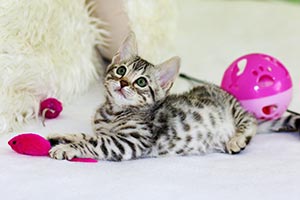
Other Kinds of Toys
Last week, I made a post about one of the best way to play with your cat- with a wand toy! However, there are plenty of other great toy options out there that can benefit your cat (especially if you have one who wants to play ALL the time), so today I’m going to talk about some of those.
-Battery powered toys
Sometimes, the hardest part about picking out the right toy for your cat is choosing one that is engaging enough that they’ll play with it on their own. Battery powered toys often solve this problem because they move, drawing your kitty in! There are lots of different kinds of these toys. I highly recommend one with a ‘timer’ function built into it- one that you push a button to turn it on, and it will shut itself off 10-20 minutes later. It’ll save the batteries, and if a toy is left running all the time it can just fade into the background and become boring to your cat. This is my favorite one to use in the shelter: https://bit.ly/2DXGsY7 but depending on your cat’s play style, there are plenty of other options they may find more appealing.
-Rattle mouse toys
This style of toy is what I’m talking about: https://amzn.to/3KoQ3ba These are probably one of the most popular toys I’ve seen. That honorific comes from a survey of those whose opinions matter the most- the cats, of course. You can toss these around for your cat and maybe even get them to play fetch with them. However, many cats who are on the more playful side also have a great time playing with them on their own- I’ll often see them batting them back and forth between their paws and picking them up in their mouth and carrying them around. The size, texture, and noise really seem to get their hunter instincts in gear!
-Ball toys
Another great kind of toy is the simple ‘ball toy’. I’ve found that most cats aren’t actually the biggest fan of the ones with bells in them, and seem to prefer ping pong style balls or the ones made out of firm foam or other soft material. The problem with these is that it’s so easy to lose them- one bat of the paw and suddenly it’s under the couch, out of reach. You could buy them in bulk so even when you lose the first 20 you still have 20 left- or you can make it a bit easier for your cat. Put the ball in a large cardboard box, or an empty storage bin, or even your bathtub. You could also set up a larger space using a perimeter of towels or boxes to prevent the ball from rolling away. This way they can bat it around in that space and never worry about it rolling underneath something.
-Catnip/Silver Vine
While these aren’t technically toys, when used in conjunction with toys, they can certainly help hype your cat up! Some cats may respond to these by getting sleepy, while others may not have a reaction at all- but many, many cats become more hyperactive after rolling around in these. It can be great to try out catnip for your senior kitty and see if it gets them more engaged in play time. While you can get toys with catnip in them, I suggest getting dried or fresh catnip or silver vine (or silver vine sticks) and giving your cat a little just before you want to initiate a play session.
-Kicker toys
Especially if your cat is the type to get overstimulated when you play with them, I cannot recommend kicker toys enough. They are great for cats to latch onto with all four paws and their mouth and get out their kicking and biting urges on. There are lots of toys specifically designed for this purpose, but some cats can be just as satisfied with a medium-sized stuffed animal. Check out a thrift store near you, toss whatever good ones you find in a laundry bag and run them through the wash, then sprinkle with catnip and see if your kitty likes it!
-Bubbles
There are catnip bubbles made just for cats, which are a lot of fun but are often very sticky and a bit messy for your hands. However, even just regular bubbles can be fun for some cats. Just be sure to blow them a little distance away from your cat, so they can choose whether or not they want to engage- some cats are afraid of bubbles.
-Crinkly toys
Whether it’s little bundle toys of shiny mylar, or a mat or cat bed with mylar sewn inside of it, or even just a crinkly paper bag, many cats love toys that make a crinkle sound when they play with them. If you have a cat who enjoys them, it can often be an easy way to get their attention and let them know it’s play time- simply pick up a mylar toy and crunch it with your fingers, and your cat may come running! Some cats find the sound a little too spooky for their taste, so if you have one cat who loves crinkle toys and another who is afraid of them, be sure to have separate playtime with each cat with different kinds of toys.
Variety is the key! If your cat doesn’t like one kind of toy, there’s always more to try. I’ve barely scratched the surface with this post; there are so many more kinds to try. If you find your cats get bored of their toys after a week or so, put things on a rotating schedule- one week you keep the rattle mice toys in a closet and use bubbles and ping pong balls, and then switch out the next week. Keeping some toys out of sight for a little while can help them feel fresh and brand new. Of course, if your cat has a favorite toy that they adore or like to carry around a lot, you should leave that one out for them all the time!

One of the Best Ways to Play with Your Cat
Every feline, regardless of their age, should be engaged with play and other enrichment every single day. If you have just adopted a cat, keep in mind that they may need to settle into your home and gain their confidence before they are willing to engage in play.
While there are many great things you can give to your cat to play with independently, there is no replacement for interactions with you, their human! There is one kind of toy that shines above all others when it comes to spending time playing with your cat- a wand toy.
Many cats have a preference about exactly what kind of wand toy they want to play with, so you may need to try out a few before you find their favorite. Lots of cats like ones that have string-style elements to them, or dangly tassels/strips at the tip. Get a few different styles, and read through the following tips to get them playing.
-Have the right expectations
If you have a kitten, then your play session could look like how you might imagine- them bouncing off the walls and doing flips to grab the wand. Most cats will lose this intense playfulness as they get older- so maybe your 5 year old cat will only chase the wand toy if you keep the play area small and make it easy for them to catch, and your 18 year old will only follow the wand toy with his eyes and maybe lazily bat at it every once in a while. These are still forms of playing, and if you get your cat to engage in this, you are doing a good job.
-Keep it new and exciting
When not in use, keep the wand toy tucked away behind a closed closet door or somewhere else your kitty can’t find it. Not only does this eliminate the risk of them getting tangled up in it or chewing on it, it also ensures that the toy will be of interest to your cat every time you bring it out, rather than just being another part of the scenery. Switching between styles of wand toys, if your cat will play with more than one kind, is another way to keep things fresh.
-Make the ‘hunt’ fun
If you just stand over your cat and wave the toy back and forth, you might find that they seem bored. Kittens and particularly playful adult cats might find this entertaining enough, but most cats will want a little something more. Remember that in the wild, cats will hunt things both on the ground and things flying up in the air. Try dragging the toy along the ground for them to chase, or flicking it to imitate a bird flying back and forth across the room. Maybe your cat likes to sit on the top level of their cat tree and have you flick the wand toy up towards them, or maybe they’ll hide under a chair until just the right moment and then pounce. Try having the wand toy disappear around the other side of the couch so they have to go look for it. Remember, your cat is a hunter, so make the toy imitate what live prey would do, which most of the time is moving away from the cat. Your cat is going to have more fun this way- and so will you because cats are really cute when they play!
-Let them catch it
If your cat doesn’t get the satisfaction of catching their ‘prey’, it could lead to frustration or redirected aggression- or could simply be unsatisfying for them. Make sure you let your kitty catch and ‘kill’ the toy after a few minutes- and then repeat the playing process a few times, ending on a successful ‘catch and kill’ of the toy. If they don’t seem to find satisfaction in catching the wand toy, you can always switch them over to a different style of toy, like a kicker or something else that they like to grab onto.
-Feed them after
To fully satisfy their hunting instincts, give your cat food after the play session is over. It’s often great to schedule playtime right before mealtime, but you can always just give your cat a couple of treats or a small snack as long as you’re not going overboard with excess food.
Senior Cats
Today I’m going to talk about senior cats!
When is a cat considered a senior? There doesn’t seem to be a set age that everyone will agree on, but the range where you can start thinking of your cat as a senior or at least a ‘pre-senior’, if you will, is around ages 7-11. Some seniors, you will not really be able to tell they are seniors! Many cats will keep high energy levels and a youthful spirit well into their late teens. Of course we all want to make sure our kitties have long, happy lives, and I’m going to give you a few suggestions on how to help keep your cat content and healthy as they age.
-Have a good partnership with your vet. While it’s usually recommended to take a cat of any age to a vet at least once a year, it becomes even more important for senior cats. If you can catch an oncoming health condition early, it will be easier and cheaper to manage, and can give your cat a longer, higher quality of life. You also want it to be easy and fast to get them to a vet if something unexpected comes up. If you’ve ever thought about getting pet insurance, you may want to consider doing it BEFORE your cats reach their senior ages, to better prepare for anything that comes up. Some common health conditions that you may bring up with your vet, or they may look for with seniors, are: kidney health, thyroid health, diabetes, and arthritis.
-Water intake. Important for all cats, even moreso for seniors! Making sure they are getting adequate hydration is a part of staving off health conditions. In the natural world, cats get 70-75% of their hydration from their food, so if you’re not already, talk to your vet and consider switching your kitty to a wet food diet (or at least including wet food in their meals). If they’re a fan of wet food already and you’ve been advised to increase their hydration even more, you can try mixing warm water into their food- some cats may really enjoy the ‘broth’ this creates. Be sure that they have multiple water sources available to them, and that they are refreshed daily, as cats will commonly turn up their noses at dirty or old water. Drinking fountains are also a great thing to offer for them.
-Ramps, stairs, or stepping stools. As cats age, they may need some help getting to their favorite spots. Cat trees may not be as easy to climb, or your cat may have difficulty jumping up on your bed from the floor. Give them easier ways to climb up to things- you can place an ottoman, small table, or something similar next to a higher object, or get actual pet stairs or ramps. You can also change things up: if they loved sitting on the top of their cat tree in a window where the sun shines through, simply set up a lower-to-the-ground spot that the sun will hit for them to lounge in.
-Litter box changes. If your senior starts going outside the litter box, your first step should be the vet, but sometimes the reason they are going out of the box is simply because the box has become uncomfortable for them to go into. If they are going next to or near the litter box, that is a good clue that this may be what is going on. To help them out, you should consider adding a litter box with lower sides, or an extra-low entrance, in case the problem is that physically climbing into the box is difficult. There are litter boxes made specifically for senior cats; ‘puppy litter boxes’ may also have low enough sides. The other thing to consider for seniors is the substrate you use. If their paws have gotten more sensitive with age, what they’ve been using for years may suddenly be unpleasant or painful to them, so you can try adding a new litter box with a softer substrate and see if they prefer to use that.
If you have a multi-story home, make sure you have litter boxes on each floor. If climbing up or down stairs is more difficult or painful, they may not be willing to make the trek to find the box.
-Don’t give up on playtime! (Most) senior cats aren’t going to be bouncing off the walls running after a wand toy like they did when they were a kitten, but they still need to be engaged. See if they are willing to do shorter chases of wand toys, or bat at one dangled near their head. Give them catnip, and kicker toys, or try different styles of toys to see what will encourage them to be active. If your cat is in their late teens or early twenties, even just following a wand toy with their eyes and giving it a lazy bat ever once in a while can be considered playing. Every cat needs this stimulation, regardless of age.
-Warming mats. Even younger cats often gravitate towards heat, of course, but older cats seem to want it even more. You can get heat pads that are low voltage and plug into an outlet, but if you’re concerned about something like this, there are self-warming mats that are made with a layer of mylar in between the fabric, which helps bounce your cat’s body heat back at them. And leaving soft blankets in a sunny spot is always going to be a hit!
-Slip-proofing. If your senior is having some trouble getting around on slippery surfaces, like hardwood floors or any other smooth or slick areas that they normally traverse, get some rugs or mats with a rubber backing to lay down so they don’t have to worry about sliding around everywhere.
-If you’re looking to add another cat to your household during your current cat’s senior years, I recommend that you NOT get a kitten. Their energy level can be overwhelming to your senior cat, and can contribute to increasing their stress levels. If you are absolutely set on getting a kitten and there is nothing I can say to convince you otherwise, then you are going to better off getting TWO kittens, because they will have each other to direct their energy onto. You will still have to do proper introductions with your senior and the kittens, and ensure that your senior gets alone-time away from the kittens and doesn’t miss out on attention from you. Your best bet is going to be considering adopting another adult cat.
Speaking of senior cats… We have lots of amazing ones available for adoption right now! Here’s a sample of some of the wonderful kitties who we have:
Fabulous Fig, located at our Healdsburg shelter: https://humanesocietysoco.org/pets/fig-the-cat/
Sweet Peanut, in Santa Rosa: https://humanesocietysoco.org/pets/peanut-the-cat-2/
Amazing Lola, also in Santa Rosa: https://humanesocietysoco.org/pets/lola-the-cat/
Cats in Hot Weather
In Santa Rosa, we’ve been having a spell of somewhat cooler weather- but in many other places, it is HOT, and we’re certain to have hot weather here again soon. While cats are a little more tolerant of hotter weather than many humans, we still need to keep their comfort and health in mind when it comes to the heat. So what are some things you should (or shouldn’t) do to help keep your cat cool, and what are some signs of heat stroke to watch out for?
- Be sure to have multiple options for water- bowls, water fountains, whatever they like best. Refresh the water daily so it is clean, as it’s better for your cat and will make them more likely to drink it.
- Take a damp towel and gently wipe their body/feet, if they will tolerate it.
- Encourage them to play with ice cubes, or ice cubes made out of wet food/pet-safe broth or other yummy treats. Frozen water bottles wrapped in towels and placed near them can also provide a cooling effect.
- The things that you would do to keep yourself/your home cool will benefit your cat. Running oscillating fans even when you aren’t home, and making sure you close blinds/windows will help. If you have linoleum, tile, hardwood, etc. encourage your cat to be in these areas. If you don’t, or your cat prefers to hang out somewhere else, consider getting them a cooling mat or two and putting them in places your kitty likes to be. Of course, if you are lucky enough to have AC, then you’re golden!
- Avoid encouraging them to play in the hottest parts of the day. Try to stick to mornings and evenings.
- This is more talked about for dogs than cats, as dogs are more likely be taken in a car, but never leave your cat in an unattended car for more than a minute or two, as the temperature inside a car grows much hotter than outside, and it happens a lot faster than you might think.
- If you normally let your cat outdoors, keep them inside during a heat wave. You will have greater control over the temperature they are exposed to, and will notice if they start showing signs of heat stroke.
What about grooming options, such as lion cuts? Will shaving your cat down help them stay cool during a heat wave? Though it seems like getting rid of that fur could help them, this may not be the case. James H. Jones, an expert in comparative animal exercise physiology and thermoregulation at UC Davis, says “Fur acts as a thermal regulator to slow down the process of heat absorption.” Cats will shed and make their coats more suitable for heat protection instead of warmth by getting rid of their thick undercoat, but according to Jones, having a healthy, well-groomed fur coat will help them stay cooler on hot days. A lion cut could also result in outdoor cats, or even just those who sit in sunny spots, getting a sunburn.
One time that you definitely SHOULD consider getting a lion cut for your cat is if they have mats. Mats or heavy tangles will prevent a cat from thermoregulating properly. If you aren’t sure if a lion cut or other form of fur trimming will be helpful for your cat’s health, I recommend consulting your vet.
What about brushing your cat? Yes, please! Helping them get rid of the fur they are shedding will help keep them cooler. A furminator or other style of brush that is good at removing that heavy undercoat can help in the summer.
Here are some signs of heat stroke to watch out for. If you’re suspicious of heat stroke and see these signs, administer emergency first aid and then take your cat to the vet immediately.
- Anxiety (may present as the cat pacing)
- Bleeding from the nose
- Seizures
- Muscle Tremors
- Dizziness
- Vomiting or diarrhea
- Prolonged panting (some cats may pant after an intense play session, but if it lasts for more than a minute or two or is accompanied by any other concerning signs, it should be taken seriously)
- Bright red tongue
- Dark red, or pale, gums
- Weakness or lethargy
Emergency first aid:
- Get your cat to a cooler location
- Put cool or tepid water (NOT ice cold) on your pet, and blow a gentle fan on them to maximize heat loss
- Wet the area around your cat down; you could get a damp towel or two and place them next to your cat in their carrier as you take them to the vet.
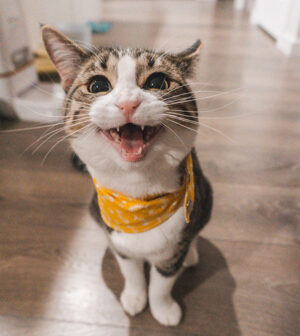
Separation Anxiety
This week, I’m going to talk about separation anxiety.
There’s a stereotype that all cats are aloof and independent- those of us who have cats have seen this proven wrong time and time again! While some cats definitely appreciate their alone time, many cats may suffer from separation anxiety; sometimes, the signs might be very subtle so you don’t even realize that’s what’s happening. So what are some common signs of separation anxiety?
- Excessive vocalization when left alone or when they are about to be left alone, or if separated from their favorite person
- Following their person from room to room as they are getting ready to leave; jumping on top of bags; standing in doorways the person is trying to walk through
- Not eating or drinking when alone
- Urinating or defecating outside of the litter box, especially on things that smell like their person (laundry, a pillow, etc.)
- Over-grooming/hair loss
- Destructive behavior when left alone or separated from their favorite person
- Extreme excitement upon their person returning home
As you can probably tell, some of these signs may be difficult to notice, if they are only happening when no one is home with the cat! If you have suspicions and want to keep a closer eye on your kitty, I would recommend getting a camera to put in your home when you are gone. There are lots of different kinds that allow you to view live video from an app on your phone, and many of these are relatively inexpensive.
So if you think your cat has separation anxiety- what can you do to help them?
- Set aside some time in your morning routine to have a nice play session with your kitty. This is when you should bring out their favorite toy, and spend 5-15 minutes trying to wear them out. Then, give them a snack. If you already gave them breakfast, just give them a small scoop of their favorite wet food, or some of their favorite treats. If a cat plays, then eats, they’re going to be more likely to want to groom themselves and then take a nap, and will be less focused on your departure.
- Don’t make a big deal when you leave the house. Don’t go give them cuddles, tell them you’ll really miss them, or make a big scene of saying goodbye. Ideally, have them occupied with something else- the snack you just set out for them, or a battery-powered toy, and just simply leave. The same thing goes for when you come home- don’t instantly run to them to greet them, especially if they’re meowing or pawing at you for attention. Instead, wait for a moment when they are calm, and then shower them with love.
- Make sure they have lots of independent enrichment available to them. By this, I mean something that doesn’t require a human to make it fun. Toys are great, of course, if your cat will play with them by themselves- battery-powered toys, motion-activated fish that flop around when a cat bats at them, a ping pong ball dropped in the bathtub so they can bat it around without losing it under a couch. It can be a good idea to have these toys hidden away when you’re home, so they feel more ‘fresh’ to your cat who will be more interested in engaging with them when you’re not around. Enrichment goes beyond just standard toys, as well! Puzzle feeders or foraging toys are a great tool- or you can even just leave treats hidden around your home in some of your cat’s favorite places. Leaving on gentle music or low-volume TV, or even an oscillating fan, can be a comfort and may also serve to drown out background noises that could be contributing to your cat’s anxiety. Cat TV in particular can be a great source of entertainment- either videos found on YouTube showing birds, fish, etc., or the real deal- hanging a bird feeder outside a window that your cat has a nice view from. Some cats also feel more secure in a cozy hiding spot, so make sure to provide them with cave cat beds, cardboard boxes, cat tunnels, and the like. If you are able to get a camera to watch your cat when you are gone, then you can pick up on things that make them feel better. If you see them crying and walking around looking stressed, but they become quiet and calm if they go in a cardboard box, then that tells you that they need more den-like places to hang out inside of.
- Desensitize your cat to the signs that mean you are leaving. So if you notice your cat starts to vocalize every time you pick up your keys to head out, pick up your keys at other times of day as well- when you’re heading to the couch for some TV and kitty-cuddle time. If putting on your shoes makes your cat seem anxious, put them on, walk around the house, then take them off. If your cat no longer has these triggers that let them know they’re going to be alone for a long period of time, they’re less likely to feel anxious. You can also show your cat that you won’t always be gone for 8+ hours; start taking five-minute walks around the block, or even just walk to your car and back.
- Use Feliway in your home. Feliway is a synthetic cat pheromone that can provide a general calming effect for your anxious kitty.
- If your cat is attached to you specifically, but there are other people in your home, encourage them to bond with your cat! Get them to feed a couple meals, or give some of their favorite treats, or spend some time playing with them.
- Consider getting another cat. While there’s a process to introducing a new cat to your home, the long-term benefits can outweigh the short-term effort that has to be put in. While of course there will always be some cats who want to be the solo king or queen of the castle, most cats will find having another kitty companion to be very enriching, and having a friend around can help ease their anxiety.
If your cat is showing some of the classic signs of separation anxiety, a trip to the vet is often in order to rule out any medical problems. If your kitty gets a clean bill of health, then you can integrate some or all of the techniques above and see what works to keep you both happy!
Vertical Peeing
Today I’m going to talk about ‘vertical peeing’. I don’t mean spraying, which is when a cat is using their urine to mark their territory- this post is specifically about cats who won’t crouch when they go to pee in the litterbox, or start off crouching and then slowly raise their butt as they are going, resulting in pee getting outside the litter box.
The first thing you should do if your cat engages in this behavior is take them to the vet. It’s possible they have a UTI, or joint pain, or something else going on medically that is causing this behavior. While older (or overweight) cats are more likely to have something medical going on related to this, it’s always possible a younger cat has something happening too.
If kitty has a clean bill of health, step two is figuring out if this is a behavior that you can modify, or if you need to work around the behavior. If your cat has peed normally their whole lives, and they have just started this behavior, then chances are there is something about your litter box set-up that they find distasteful. If you made any changes to their litter box set-up recently- such as you switched types of litter, or got a different kind of box- then simply switching back to what you were using before will hopefully solve the problem.
However, even if you didn’t make any changes to the litter box set-up, it doesn’t mean they aren’t unhappy with it. Many people have less-than-ideal litter box set-ups for their felines, and their kitties tolerate it for years, but then something ELSE happens to add to their daily stress, and they aren’t willing to tolerate it anymore. So even if your cat has been happily using their litter box for years, it is still worth it to try some changes. If you’re not sure where to start, you can check out this previous post I wrote below on Inappropriate Elimination.
Sometimes, there may not be anything you can do to change their behavior, especially if this is something this cat has been doing since they were very young. For some cats, this is just… how they pee. It could be because of an aversion that was formed when they were very young to litter touching near their rear, or something else that happened when they were a kitten, or maybe it’s just more comfortable for them. But I do have a few tips on what you can do to make it more manageable for you.
-Get a very large litter box. Many commercially available litter boxes are not an adequate size for cats. If your cat is as long (or longer) than the litter box, you are making it difficult for them to be able to fit in it properly to make sure their urine stays inside, even if they are trying to do so. With a large box, even if they don’t squat all the way, more or all of the pee may wind up inside because there will be more room behind your cat.
-Get a (large) box with high sides. Note that I’m not saying get a covered litter box- many cats do not like covered litter boxes, and who can blame them, as they are the cat equivalent of a port-a-potty. You are welcome to try, but make sure you also have an uncovered litter box available, or you could end up creating a whole new problem where you cat doesn’t want to use the litter box at all.
With these high-sided boxes, you still want the entrance to be easily accessible for them, so make sure it has a lower-cut entrance that is easy to climb in and out of. If you can’t find one that is appropriate, get a large plastic storage bin, remove the lid, and cut a section out of one side to create an opening for your cat. Make sure the edge is cut smoothly or sanded down if necessary so your cat won’t hurt themselves.
-Get washable mats that you can put under and around your litter box. That way, if some urine does manage to make its way out of the box, it will at least be easier for you to clean up. If you have your litter box against a wall, use Velcro or tape or whatever works for you to secure something to the wall as well. If you don’t want to deal with washing mats, you could always buy pee pads for this purpose instead.
Litter and Litterboxes
I’ve made posts in the past about everyone’s favorite behavioral concern- inappropriate elimination, when your cat urinates or defecates outside the litter box. Today I want to narrow the scope and talk specifically about litter and litter boxes.
Some of you may go through this list and see things that you are doing, and yet your cat has used the litter box without issue for years. That’s great! There will always be exceptions. However, one thing to understand is that a cat may be accepting something unpleasant, because the unpleasantness hasn’t crossed their ‘line of tolerance’, but then something else in their life changes that pushes them over the edge and they stop using the litter box they’ve used for years. So if your cat unexpectedly starts going outside the box, you should still consider some of the things on this list.
First off, let’s talk litter. Different cats have different preferences for style/brand; your average cat will like a soft material similar to the consistency of sand. I can tell you one thing to definitely NOT use, and that’s scented litter. What smells pleasant to us can make your cat, with their superior sense of smell, say ‘no’ to the box. It can be tricky to figure out if a litter is scented or not, as sometimes they are marked with different terminology. It could say ‘scented’, or ‘contains odor-blasters’, or ‘smell-reducing’, so make sure to look a little closer to ensure you truly are getting unscented litter.
Also experiment with how much litter you use. Most cats will want to be able to thoroughly bury their litter, so make sure it is deep enough for them to accomplish this. However, some cats- particularly those with long hair who are more susceptible to getting litter stuck in their fur- may not like a thick layer of litter in the box. For a starting point, I recommend 2-3 inches deep, and then you can adjust from there based on your cat’s behavior.
Now on to the boxes themselves. I present you with a list of “dos” and “don’ts”:
DO- scoop the litter box daily, or even more than once a day. Clumping litter makes this easy. A cat will not want to use a litter box that has a lot of urine and feces in it already. I personally find the ‘litter genie’ or ‘litter locker’ style of litter disposal bins make it less of a chore to clean.
DO- deep clean the box once a month or so. By ‘deep clean’ I mean completely empty out all the litter and wipe down the box with a rag and water. If you need to use a cleanser on it, use something very mild/unscented. If you use non-clumping litter you will need to dump and replace the litter more frequently.
DO- provide enough litter boxes for however many cats you have. General rule of thumb is one more box than the number of kitties in your household.
DO- spread out the location of your litter boxes. If you have five litter boxes but they are all lined up in one spot, to a cat, it is basically the same as just having one litter box. This becomes more and more important the more cats you have.
DO- use large enough boxes. Many commercially available litter boxes are simply not large enough for many cats. You can buy extra-large litter boxes, or you can turn something else into a litter box, such as taking a plastic storage bin and cutting the walls shorter for easy access.
DON’T- use liners. Cats can get their claws stuck in the liner when they are digging in the litter, which is unpleasant to them- and not to mention it shreds the liner and makes it virtually useless anyway.
DON’T- use covered litter boxes. They trap the smell inside, and can make it a scary experience for your kitty- they need to be able to see what’s going on around them as they do their business, and be able to easily escape if something (such as another pet) comes up on them suddenly.
DON’T- keep the boxes in noisy areas. Laundry rooms are a very popular place to put litter boxes, but especially if your cat is the skittish type, having to go next to a loud appliance is going to make them dislike their box.
DON’T- keep the box in a corner/area with no escape route if you have two or more pets who have problems getting along. If someone feels like they can’t use the litter box without being cornered, they will probably find somewhere else to go.
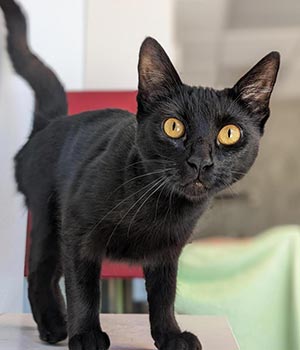
Maddie
Compromise
Today I’d like to talk about compromise. Perhaps not the first thing you think of where cats are concerned, but making compromises for your cat is a big part of being a cat lover! There are a lot of things that I encourage people to provide their cat that they are less than enthusiastic about because of their own personal aesthetic or cleaning preferences. Sometimes, you may be able to give your cat what they need without completely going against your own desires.
I’ll jump right in and start talking about litter boxes. Dealing with litter is typically every cat person’s least favorite task, but having a good litter box setup is essential to keep your cat happy and healthy. One of the first things I look at when I’m trying to help someone solve inappropriate elimination- when a cat urinates or defecates outside their litter box- is where their litter boxes are located. If you’re like most people, you probably have your litter boxes in more ‘out of the way’ places, like your laundry room, or a closet, or some other location that isn’t highly visible. While many cats can and will be fine with this set-up, it’s not guaranteed to work for all cats all the time, so you have to be prepared to put a litter box in a more open, socially significant and easily accessible spot, such as your living room.
So how can you make it more tolerable for yourself and the other people in your house? I have a few suggestions.
- Try a covered litter box. I am usually the first one to tell people to remove the cover from a box (a covered litter box is the cat equivalent of a port-a-potty), but some cats WILL use them without issue, and if it makes it better for you to have the box out in the open, it is worth trying. You could also consider getting a special end table or coffee table that has a little section/compartment in it that can fit a litter box. There are tables specifically designed for this, and these are basically the equivalent of a covered litter box, but some cats may prefer them to having an actual cover.
- Make the litter box pretty. Pick out a color that matches your furniture, or ask the artistic member of your family or friend group to draw a pretty design on the outside of the box with permanent markers. If you like how it looks, it may bother you less.
- Keep the litter box clean. Get a litter genie or litter locker or equivalent, and any time your cat goes, scoop it right away. If you stay really on top of keeping the box clean, you likely won’t even notice that it is there. This is also quite beneficial for your cat!
One thing that is great to have PLENTY of around for your cats are soft, cozy places for them to sleep. Cats are very scent-based creatures who feel most secure when their space smells like them, and while they will specifically mark their territory with their scent glands by scratching or cheek-rubbing, simply just lying on something is also a way that they deposit their scent. The more places you have for them to lounge, the more secure they will feel. Cat beds are certainly one way to offer them this option, but if you find yourself tripping over their beds, or simply don’t like how they look, there is another great way to give the cats what they need: blankets. I haven’t met a cat who doesn’t enjoy faux-fleece throw blankets, and there are SO many options for color, design, and style, you will probably be able to find pretty much whatever your favorite decor-theme is on a throw blanket. I have more throw blankets than I can count, and they are EVERYWHERE. On my couch, on my recliner, folded up by the bed and on the floor by my sliding glass door, in my cats’ crates… anywhere I want my kitties to feel comfortable sitting, I put a blanket there. It has the added benefit of keeping cat hair more localized to the blanket rather than getting directly on your furniture, and can even deter undesirable scratching-if you cat can claim the couch by simply sitting on their favorite blanket that’s draped over it, they may be less inclined to scratch the arm rest to mark their territory.
Speaking of scratchers- cats ARE going to scratch in socially important areas to claim the space as theirs. This is why, even if you have a million scratchers, your cat might ignore them in favor of your favorite chair: the scratchers aren’t in the right spot. Many people aren’t thrilled with the idea of having to put an ‘ugly’ scratcher right next to their couch, but the same thing that applies to beds and blankets can apply to scratchers. There is such a huge variety out there, if it is important to you, you should be able to find some that are aesthetically pleasing to you AND that your cat likes to scratch. You will need to keep your cat’s preferences in mind, but even if your cat’s favorite thing to scratch is a cardboard scratcher, they are made in all kinds of shapes and sizes, and many of them have cute or pretty prints on the side. The internet is of course a great place to look for these, but I have found some unique options in locally owned pet stores that I’ve never seen anywhere else.
The last thing I’ll talk about today is vertical space. It is ESSENTIAL to provide cats with places where they can climb. If you don’t give them spots, I promise you they will make them. An easy way to do this is, of course, by getting a couple of cat trees. The same things apply as with scratchers; shop around and pick one that is aesthetically pleasing to you. If you’re good with building things, or have extra spending money to splurge on something, I have seen beautiful custom-made cat trees that are designed to look like an actual tree, or a castle. If, however, you don’t feel like you can fit a regular cat tree into your space, and want a more affordable option, you have other choices. Window hammocks are a good option- there are ones installed with suction cups, though do be cautious about these slipping and falling. The kind I use screws into the windowsill with support brackets underneath. You can also just use standard shelves, positioning them up and down your wall in places your cat will be able to get to, though be sure to install them with adequate support brackets. If you can’t or don’t want to nail anything into your walls, position your furniture in such a way that cats can jump from the back of the couch, to a nearby small bookshelf with a cleared-off top, and then to another, slightly taller bookshelf or dresser or whatever you have. Put some of those aesthetically-pleasing throw blankets on them instead of picture frames or decor or the things you may normally put on top. Remember that whatever vertical space you choose to offer, it has to be easily accessible, and you should have more than enough for the total number of cats in your home. Your cats will appreciate the effort you put in!
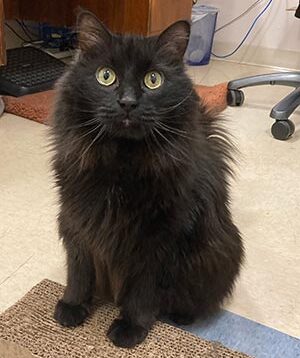
Elfie
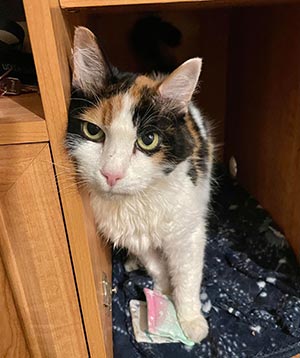
Chanel
Office Foster Cats
At our shelter, we get creative with cat housing. If we have the ability to do it, and think the animal will benefit from it, then we say ‘why not’? One of the things we will do is have cats in an ‘office foster’ placement, meaning that instead of being in a kennel or one of our habitats, they share an office with one of our staff members! Cat’s generally don’t do well with a back-and-forth situation, so when they are an office foster, they stay in the office 100% of the time. Some of the cats would say that it is really THEIR office that they are happy to share with their human friend.
So what kind of cats benefit from being in an office? Many times, putting a shy or timid cat in an office can help them feel more comfortable with people. Some shy cats need to get used to a human presence before they are more deeply engaged with toys or attempts to pet. Having someone sitting nearby, working on their computer, can be hugely beneficial. It can help the cats learn that just because a human is nearby, it doesn’t mean they’re going to be bothered, or reached for, or given medication. It often makes them feel comfortable enough to start coming out and exploring and checking out this person who’s always hanging out near them!
Other times, we’ll put a cat in an office if we want to monitor them for something- for example, if they are at risk for a urinary blockage and we want someone around to notice if they are straining in their litter box; or if we have a bonded pair who we don’t want to separate but need to know which one of them is vomiting.
And sometimes, the reason we put a cat in an office is simply because of space! If all our larger cat habitats are full, and we have a cat who isn’t doing well in one of our portaled kennel set-ups, we will move them to an office to decrease their stress.
While we always make the choice to put a cat in an office or not based on what we think is best for them, that doesn’t mean it isn’t also rewarding for the person! It’s very easy to fall in love with any of the animals at our shelter, but even moreso when they are around you most of the day. Sometimes, if I’m stuck on something I’m writing or another project I’m working on, looking over at the cute face of whatever office cat I have at the time can give me the inspiration or motivation I need to keep going. After all, the animals are why we do what we do!
Right now, we currently have two cats who are available for adoption out of offices!
-Elfie
Elfie is a GORGEOUS fluffy black dude! He was shy for the first week or so after his arrival, but then started hanging out with his office mate regularly, and now greets everyone who enters the office with a happy chirp and an invitation to stroke his luxurious fur. He is tremendously playful and loves wand toys or anything that makes a crinkling noise. He also adores his cardboard scratcher and will sometimes flop over and use it like a kicker toy! Elfie came to us from a bustling household full of lots of noise and activity, and that just wasn’t the lifestyle for this gentle guy. He’s looking for a more relaxing home where he can hang out with his person a lot and bask in the attention!
-Chanel
Chanel is a lovely calico lady who is the master of affectionate cheek rubs. She’s oh-so-slightly timid at first but doesn’t take long to warm up. In her picture, you can see she’s in her favorite little cubby- a part of her office person’s desk that they set up just for her! Chanel loves being all cozy in her cubby, but comes out for plenty of attention too. She’s a great example of an ‘independent yet affectionate’ cat- she doesn’t need constant attention but thoroughly enjoys it when it’s petting time!
A big thank you to Katie and Nina for taking in these kitties, and to all the other staff who have had office cats in the past (and I’m sure will again in the future)!
What to do if you find a kitten outside
It’s kitten season, and that means that at some point, you might stumble across some young kittens outside! We have many good Samaritans show up at our shelter with a kitten or two, or sometimes a litter of four, five, or more. We all want to keep these little guys as safe and healthy as possible. Sometimes that means taking them to a shelter, but other times, the best thing to do is to leave them where they are to receive care from their mom. So how do you figure out what is best?
- If the kittens appear to be sick, injured, really thin, or generally in poor shape, then they are likely not being cared for by mom, and need help! Take them to a vet or animal shelter right away. We recommend you call ahead to make sure the animal shelter you are planning on going to is able to help the kittens; if they aren’t, ask them to refer you to another shelter that may be able to help.
- If the kittens appear healthy but are really small and young, then mom is probably nearby, and typically their best chance at growing big and staying healthy is by staying with mom. Mom might be off hunting and planning on returning to her babies later; you can check on them every couple of hours if possible, to see how they’re doing or if there is any sign that mom returned, even briefly. Try putting a ring of flour around the kittens, so you can check for paw prints. If you feel like the spot the kittens are in isn’t safe, you can move them a short distance away, or even put out a cardboard box and let them all snuggle up in that. As long as you don’t move them too far, mom will be able to find them. If you’ve seen no sign of mom after 12 hours or so, contact your local animal shelter and see what they advise- the young kittens may need a foster home or other help from the shelter! If mom has returned, however, that means the kitties are being cared for and should stay with mom- you can contact your local shelter for information on what to do concerning spay and neuter and when it should happen.
- If the kittens are older/larger, are active, playful, and running and walking around without issue, then they are likely of an age where they aren’t depending on mom quite as much. Contact your local animal shelter and ask about the best course of action; trap-neuter-return (TNR) might be the best choice for the cat family, hopefully including mom, or it may be appropriate to bring them to an animal shelter for adoption or foster care.
Additional resources to check out:
https://www.instagram.com/reel/CdtGzD9jxgU/?igshid=YmMyMTA2M2Y=
Undersocial Kittens
It’s undersocial kitten time!
Our shelter currently has a BUNCH of cute little kittens who are ‘undersocial’- that is, they did not have exposure to humans for the first several weeks of their life, and aren’t quite sure what to make of us humans when we first start interacting with them. If they were to continue having no experiences with humans, or only scary experiences, they would grow up to become feral adult cats- cats who have no interest in interacting with humans. However, we’re on a mission to socialize: with the use of toys, treats, and positive reinforcement, young kittens can be turned into little purring machines who love scritches, snuggles, and playing.
Kittens under 2 months of age are the easiest to socialize; they can warm up to humans in as little as 24 hours, in some cases! However, up to about 4 months, it’s often still possible to help kittens form a lasting positive impression of humans. Staff and volunteers at the shelter work with each undersocial kitten several times a day, with the goal of creating as positive an experience as possible. We often have to start off by simply sitting nearby, talking to them, and slow-blinking at them; if you try to force touch on them before they’re ready, that can end up reinforcing their feelings of fear and make the socialization process take longer, or even fail completely.
Food is one of the most useful tools for socializing kittens. Kitten wet food, and churu wet food treats are often the most popular, but we have a variety of treats on hand to try! The beginning of the process typically starts with us sitting nearby and talking in a gentle tone while a kitten eats food from a dish. We’ll then see if they’re willing to eat straight from a churu packet that we’re holding, or off the end of a popsicle stick or spoon, and then directly out of our hands. As they show more relaxed body language, as long as they don’t flinch away from us, we will begin to pet them while they eat- thus associating our touch with the food that they love. We start off with a very brief and gentle touch, likely on their cheek or neck, and slowly work our way up to actual scritches and full body pets. We tailor our approach to what the kitten is comfortable with- there is no rushing them, they are the ones who set the pace!
Some kittens make more progress with toys and play than they do with food. Having a good wand toy is key- we want to be able to sit far back enough from the kitten that they will feel safe enough to play. We keep in mind that these kittens have never played with a toy like this before, so we start off slow, literally- we don’t move the wand toy very fast, refraining from the wild, through-the-air motions like we might do with a fully social, super playful kitten. We don’t put the wand toy too close to them at first, either- we start from far back and see if they track it with their eyes, and gradually move it closer to them to see if they are interested in sniffing it or even batting at it. If they flinch away, put their ears down, hiss or growl at the wand toy, or otherwise seem scared, we pause and withdraw it and try again later. Many kittens only take a couple tries before their hunting instincts kick in and they start to relax and play with the toy.
Once an undersocial kitten has shown steady progress and is open to human engagement, we make them available for adoption! We continue the socialization process while they are in the shelter, but there is absolutely no reason why YOU can’t continue it in your home! Socializing a kitten is fun and rewarding- if you have the patience to try the techniques that we described above and want to help a kitten in need, come adopt one (or two)! Adopters of undersocial kittens are sent home with a short instructional handout with tips on how to help their kitten settle in, as well as a link to The Kitten Lady’s fabulous undersocial kitten instructional video, so you will be set up for success!
Training Your Cat
Last week I wrote about treats and hinted that I would be writing a post about training cats, and here it is! This is not a comprehensive guide to training- there is way too much to talk about for that! This will be a basic guide that can help you get started. Training, if done properly, can be extremely enriching and beneficial to a cat (or any other animal). Don’t listen to anyone who tells you cats can’t be trained- they absolutely can, and I know because I’ve done it!
First off, I will say that training cats is really not that different from training dogs, or any other species. The most widely accepted method of training in the modern age is positive reinforcement based training. We never use force or punishment to get an animal to do what we want; instead, we give the animal something that they want, to reinforce a behavior that we want from them. If you are already familiar with this method and have used it with a dog, rat, bird, etc. you can apply the same exact techniques to a cat! Often the easiest animals to train are those who are food motivated, as treats are a very easy reward to give, but if an animal isn’t that into food, you will have to ask yourself what it is they DO want. Pets? A favorite toy? Catnip? Finding something that they like and will be willing to work for is the first thing for you to do and will help shape how you train them.
When you are training an animal to do something, you need to work in small approximations. Say you want to train your cat to jump through a hoop. You can’t hold the hoop three feet above their head and expect them to just jump through it right away. You need to break it down into smaller pieces. So what could be the first step here? Simply getting your cat to approach the hoop. Hold it at ground level and encourage your cat to walk towards it, and if they do, reward them. Once they have that step down, move on to step two: getting them to walk through the hoop at ground level, rewarding after. Once they will walk through it, you can lift the hoop, maybe just an inch off the ground, so they have to step slightly higher to get through, rewarding after. Then raise it another inch, and so on, and so on. How fast you are able to progress will depend entirely on your cat. Some cats may not be willing to walk through the hoop as step two; maybe they are nervous about it but will be willing to stick their head through it, in which case you can reward that behavior, and then get them to put one paw over it, and then the second, and then the front half of their body. If your cat isn’t willing to do what you are considering the ‘next step’, it probably means you are asking too much of them and need to break the training down into more manageable pieces for them.
What if your cat won’t even approach the hoop in the first place? If you find that they are scared, intimidated, or otherwise repelled by an object that you are trying to use in the training, you will first need to desensitize them to the object. You can do this by first figuring out on what level they will accept the object. Are they fine with the hoop if it’s lying flat on the ground? Does it have to be on the other side of the room from them? Does it need to be tucked under a couch or blanket with only a small part of it showing? Whatever you find they will accept, start there, and then use gradual steps to get them more used to it. Desensitization can also apply to things like noises or smells, so if you are trying to get your cat used to electric trimmers, for example, you may need to desensitize them to both the site and sound of the trimmers.
One key point about delivering a reward to the cat is the TIMING. If you give them their treat at the wrong moment, they won’t necessarily understand that you are rewarding them for the specific behavior they did. So if they are willing to walk through the hoop, and then they come over to you and get a treat, they may think they are being rewarded for coming to you rather than the act of walking through the hoop. It can be awkward and difficult to make sure you are getting a treat to them right as they are walking through the hoop, though- and this is why clicker training is such a useful tool. The purpose of using a clicker is to mark the point in time that your cat is doing the thing you want it to do- it’s really easy to quickly press down on something you’re holding in your hand. Of course, you first have to teach your cat that the sound of the clicker means a treat is on its way. This video does a good job of explaining the basics of clicker training: https://www.youtube.com/watch?v=INBoq-5D_m4
For more info about clicker training (or training tips in general), you can find a lot of resources online. However, make sure that whoever is writing the articles you read, or whoever makes the videos you are watching, promotes positive reinforcement based training and isn’t advocating for force or punishment. Karen Pryor is a great animal trainer with lots of online resources- or if you want a book, she has one called ‘Don’t Shoot the Dog’ that is a great read.
Positive reinforcement training and desensitization can be used for so many things: getting your cat to like their crate, getting them to wear a harness, teaching them to give a high-five… Anything that your cat is physically capable of doing, with enough time, dedication, and consistency, you are likely to be able to train them to do it. This post barely scratches the surface of training- I haven’t even talked about cues, or shaping vs. capturing- but with an understanding of the basic principles you can teach simple behaviors like jumping through a hoop. And don’t think that you can’t teach your 14-year old to do something- old cats absolutely CAN learn new tricks, and with positive reinforcement based training, the experience will be enjoyable and enriching for both you and your cat.
Giving Your Cat Treats
Giving your cat treats can be useful in so many different scenarios- when you are introducing a new animal to your home, getting them used to going in a crate, getting them to take medication, helping shy cats gain their confidence, helping them make friends with a new person in your life… the list goes on and on. If there is something you want to get your cat to do, or something you DON’T want them to do, then treats will likely be able to play a role.
An important part of making sure that the treats can help you and your kitty friend in whatever you are trying to accomplish is to avoid giving them treats ‘whenever’. Save them for when you are working with your cat or teaching them something! Another thing to keep in mind to ensure treats are being used as effectively as possible is that it’s often better to have your cats on set meal-times rather than free-feeding them. If your cat can eat whenever they want, they are going to be less hungry for treats and less motivated to work with you for a food reward. When you are giving them treats, give them as small a piece or amount as you can that still seems motivating to them.
So what kind of treats are good? Well, that really depends on your cat. If they are on a special diet, you should consult with your vet to see if there are any commercially available treats that would be all right for them to have. Some prescription diets also make treats that still meet the requirements of that diet, so you can ask about those. If your cat is really food motivated you may even be able to use their regular kibble or wet food for training purposes. If you are going to be using a lot of treats, as may be the case if you are training them to do something difficult, you should check with your vet to see if you need to decrease the amount of regular food they get, so weight gain doesn’t end up being a concern.
If your cat doesn’t have any dietary restrictions and you’re not sure what treat to get them, I have some suggestions of things to try:
- Tiki Cat/Churu/other wet food style treats. These kinds of treats come in a small tube-like package and have a soft, creamy consistency (the packaging is reminiscent of Go-Gurt). Most cats will lap them up with their tongue straight from the package, and you can just squeeze it up as they go. If that doesn’t work well for you, you can always squeeze some out onto a small spoon, a popsicle stick, or something similar. A spoon or stick works well for using regular wet food as a treat, as well.
- Meaty sticks. The brand I’ve used the most is ‘Sheba’ but there are other kinds out there too. They can easily be torn or cut into small pieces.
- For something easy to make yourself, use plain cooked chicken. Boil it, or if you have a pressure cooker that works great, and be sure not to add any seasoning. Then you can cut it up into small chunks and freeze it in little baggies or tupperware, so you can unfreeze what you need for a day or two and the rest will keep longer.
- Greenies, Temptations, or other similar crunchy treats. These kinds of treats come in different flavors and styles, and while many cats won’t care, others are definitely picky about what kind they like best. Greenies are my most-used treat at the shelter, and I’ve found that more cats prefer the smaller, square-shaped greenies over the larger, fish-shaped ones.
There are SO many kinds of treats out there; don’t be afraid to experiment to find something your cat truly loves! If you wind up with a treat that your cat doesn’t like, give the rest of them to a friend, or donate them to us or another animal shelter where they’ll go to the shelter cats (or in our pet food pantry for other cat people).
If you are wanting to train your cat to do something specific- give you a high five, come when you call them, walk into their crate or to a specific location on command- often the best place to start is by clicker training them. I’ll write a post about training in the future, but if you think training your cat is something you’d like to do, then I encourage you to start looking for that special treat that your cat absolutely loves!
Cats Who Won’t Let You Sleep
Today I’ll be talking about cats who won’t let you sleep!
Most cats are crepuscular by nature, meaning that they are naturally most active and dawn and dusk. However, this doesn’t mean that their routines can’t be altered, resulting in a kitty who is meowing for food or attention at two in the morning. The good news is if their routines can be altered in this way, they can also be altered in a way that is more in sync with your own schedule!
The first mistake many people make is unintentionally rewarding their cat’s nighttime activity. If your cat is yelling at you for food in the middle of the night, and you get up and give it to them, then you have just encouraged them to continue their behavior. The best thing you can do for your cat’s unwanted nighttime behavior is to ignore it. I know how difficult this can be- I have a cat of my own who would often try and insist on getting pets at 3 AM, and he figured out he could wake me up by standing right next to my face, pulling at the cord charging my phone, and knocking it onto the ground. To solve this, I had to temporarily change the way I positioned my phone on my nightstand so he couldn’t get to it. After he got out of that habit, I was able to put my phone back in its normal position, and he leaves it alone to this day. The caveat I will add here is if your cat is suddenly exhibiting strange vocalizations or behavior that you have never seen from them before, then it can be a good idea to get them checked out by a vet. If they have a clean bill of health, then you can go ahead and ignore away!
Of course, ignoring this behavior will only go so far if you don’t engage with them during the times of day you DO want them to be active. It is especially important to establish a routine of playing and feeding. Perhaps an hour or half hour before you are ready to wind down for the night and head to bed, you should have a play-session with your cat. Do your very best to tire them out! Once playing is over, this is when they should receive their dinner, or even just a small snack. A cat who just expended a bunch of energy and then ate a meal is going to be a sleepy cat, and timing it out like this is going to align their ‘bed time’ with YOUR ‘bed time’. If you are having a hard time getting your cat to play, I strongly recommend watching this video: https://www.youtube.com/watch?v=SMPjoNg3nv8
It can also help to establish a routine/boundaries in the morning. Maybe you roll right out of bed and the first thing you do is go hug your cat and feed them. While this may not create any problems with most cats, some cats will connect you waking up with them immediately getting attention or food, and then may decide to try and wake you up earlier if they want those things while you are still asleep. If yours is the kind of cat who does this, then you should wait to give them attention until after you’ve done something else- brushing your teeth, or booting up your computer, for example. Your cat can then establish this as the ‘signal’ that you are going to give them attention. For feeding, the best thing you can do is establish a very clear, unique signal that you are going to start prepping their meal. You can pick whatever you want, but make sure it’s something that doesn’t occur at any time OTHER than when you are offering food. I have a service bell that I ring, and all my cats come running in anticipation of food. I taught them what it meant by ringing the bell and then immediately giving them a treat before prepping their meal- they figured it out really quickly!
As you work with your cat to help shift their desires to align with your own schedule, the most important thing to remember is that it will take time and consistency. They may not understand what is happening at first, so you need to be patient with them as they learn. Just as it isn’t easy for humans to instantly adapt to a new schedule, cats need time to get used to a new routine, so while some cats may pick up on what is happening right away, with most kitties it will likely be at least a few weeks before you start to see positive results.
How to Feed Your Cat
Today I’m going to be talking about how you should feed your cat!
I’ll start by saying that I’m not going to tell you WHAT to feed your cat. There’s a lot of debate over wet food vs. dry food, this brand vs. that brand, and the best thing I can tell you to do is to consult your vet. While I’m personally a fan of wet food since cats get a lot of their moisture from their food, different cats have different dietary needs, and a medical professional is going to be the best person to tell you what- and how much- your cat should be eating.
Free-feeding vs. Scheduled mealtimes
For both medical and behavioral reasons, I strongly encourage you to have your cat on set mealtimes rather than leaving food out for them all the time. Free-feeding, or ‘grazing’, has a higher potential to lead to obesity and other health issues. Some cats may also not want to eat food that’s been sitting out for a while- with wet food, it’s usually easy to see why as it hardens up with an unappetizing crust, but dry food that’s been sitting in a bowl for a few hours can also be more ‘stale’ and distasteful to your kitty, even if it looks all right to us. Grazing also isn’t aligned with the natural patterns of their behavior. Cats are designed to work for their food, and eat once every several hours. Ideally, a cat’s daily food should be broken down into 3 or 4 smaller meals each day, roughly 6-8 hours apart, with each one being preceded by a play session or some form of activity on your cat’s part.
This type of schedule isn’t going to be practical for every pet owner, as we all have busy lives and there might not be someone at home in the middle of the day to offer a third meal. If all you can manage is two meals a day, that’s okay too! To help add more enrichment to mealtimes, you can look into getting your cat a puzzle feeder. This can be an easy way to engage their mind and promote behavioral health. There are LOTS of different kinds of puzzle feeders, so you may need to experiment to figure out what works for your cat. Understand that it may take them time to learn how to use a puzzle feeder, but they can be great for all cats, regardless of their feeding schedule. I recommend looking at this website to figure out what puzzle feeder may be right for you: http://foodpuzzlesforcats.com/
Cats who beg for food in between mealtimes
A lot of the time, I have people tell me that they keep their cat on a free-feeding diet because if they don’t have food out constantly, their cat won’t stop begging them for food. They’ll knock things over, chew on things, or meow incessantly. One thing to keep in mind is that if your cat engages in this behavior, and then you give them food, you have just taught them that doing these things is a good way to get food! There are better strategies you can use to eliminate or lessen this behavior.
- Follow a set schedule for feeding. Cats may not be able to read a clock, but they do have a general sense of time, and benefit hugely from having a routine. Do your best to feed your cat at the same times each day.
- Perform an action that can let your cat know that it’s feeding time. Pick something unique that won’t occur at other times of day. For example, I have a service bell in my kitchen, and when it’s time to feed my cats I ring it, and they all come running. I started off by ringing the bell and giving them each a treat, so they’d get an instant reward for the sound, rather than having to wait for me to put food in their bowls. It didn’t take them very long to figure out that bell=food. You can use whatever signal you like as long as it’s obvious to your cats, it’s not something that occurs at other times, and you’re able to provide reinforcement immediately after using the signal.
- Make sure your cat isn’t simply bored in between mealtimes. If they’re bothering you a lot, maybe they’re looking for cuddles, or some play-time with you. Think about how frequently you play with your cat and ask yourself if you may need to make more time to do so, and look at the enrichment you have for them around your home- if they aren’t using it then it may be time to switch things up.
- If your cat is one of those who seems to chew on everything when they’re hungry, provide them with some objects that are appropriate to chew. I suggest looking into cat grass, silver vine sticks, and commercially available chew-toys for cats.
Feeding multiple cats
Whether your cats are all on different diets for health reasons, or one of them finishes quickly and tries to get more than their fair share, I always recommend feeding cats spread out from each other. Even if they don’t appear to be at odds during meals, one of them may be scarfing their food faster than they’d like to prevent another from stealing, and it can cause stress that may bleed over into other areas of their life. If your cats love each other, never try to go for the other’s bowl, and no one has any behavioral problems, then you’re probably fine just putting their bowls several feet away from each other. If there’s any conflict between your kitties around mealtimes, I highly recommend putting them in separate rooms with closed doors. This gives slow eaters a chance to relax and take their time without worrying they’ll lose their food, and in general can reduce the stress in your cats’ lives.
Suckling Behavior in Cats
Suckling and kneading are completely normal behaviors- it’s how kittens get milk from their mother. Young kittens will often continue to suckle on things for a period of time after being separated from their mother, and while many cats will grow out of this behavior, some will continue to do it well into adulthood. So, should you be worried if your cat or kitten suckles on things?
Most of the time, no. When older cats suckle on something, it’s usually an instinctual “I’m very happy” moment for them. It’s often accompanied by biscuit-making, a much more common behavior that nearly every cat engages in at some point. However, as with all behaviors, if suckling is something that you’ve never seen your cat do before, and they’re suddenly doing it all the time, you should consult a veterinarian. If your cat is licking or suckling on lots of different things, it can indicate a nutritional deficiency or other health concern.
The other thing to look out for is WHAT your cat is suckling. I most commonly see the behavior with soft blankets or other bedding. If your cat’s favorite blanket has a bunch of loose threads, they could end up accidentally swallowing them, which can cause some serious health issues. If your kitty wants to suckle a blanket, make sure it’s in good condition and doesn’t have any tassels or anything else that could turn into a hazard.
Sometimes, you’ll also see kittens suckling on each other. This is more concerning as it can cause irritation or injury on the kitten being suckled, and can even result in a medical emergency, especially when the genital area is being suckled. Most of the time, temporarily separating the two kittens for about a week (sometimes a little longer) is all it takes. You can put them back together for play sessions a few times each day, but you’ll want to keep them separated whenever you aren’t available to supervise. Temporary separation may not always solve the problem, however, especially with older kittens. There are a few other things you can do:
- Put a pet-safe, gross tasting spray on the spot that is being suckled. Ask your vet for recommendations. At the shelter we sometimes use ‘Grannicks Bitter Apple’.
- Redirect the suckling. When you catch them in the act, gently remove them from their friend and present them with a soft blanket or cuddly toy.
- Enrichment, enrichment, enrichment! Keep your kitty active and engaged in other behaviors and they will be less likely to suckle. Ensure that you are not only having interactive play sessions with your kitties multiple times a day, but that they also have things to keep them occupied when you’re not around. Window perches with views of bird feeders, battery-operated motion toys, puzzle feeders and foraging toys… the list goes on!
You may also find that your cat likes to suckle on you! If you think it’s cute and don’t mind, just make sure that you don’t have on any lotions, perfumes, makeup, or anything else that could be harmful if ingested. However, I’ve found that most people aren’t big fans of having their cat suckle on them. If you want to stop the behavior, simply use the same techniques as listed above.
Why you shouldn’t use a squirt bottle on your cat, and what to do instead
When you think of trying to get a cat to not do something, perhaps an image of spraying a cat with water from a squirt bottle pops into your head. You wouldn’t be alone- numerous pet parents will use a spray bottle to try and deter their animal companion from doing something such as jumping on countertops or scratching their favorite armchair. I would like to encourage you to STOP thinking of this as a default method for telling your pet ‘no’ for two reasons: 1. it can be harmful to the trusting relationship you have built with your pet and 2. it is likely not working as well as you think it is!
Say you give your cat a little spritz from the spray bottle every time you see them jump on the kitchen counter, and you think it’s working well because your cat will jump down and run away, and you see them jumping up there less over time. However- more likely than not, it is only stopping them from engaging in that behavior WHILE YOU ARE AROUND. Most cats will not understand that you are trying to tell them not to do a specific thing when you spray them- rather, they will start to connect your presence with being sprayed. Even if they DO make the connection and learn that they shouldn’t jump on the counter anymore, you are utilizing ‘punishment’ as a training method which can increase fear, anxiety, and stress for your cat- and that’s something that all of us could do with less of in our lives! Even if spraying your cat with water doesn’t appear to make them like you any less, increased stress can lead to other health and behavior problems- so why risk it?
So do you have to live with letting your cat jump on the counter, or tear up your brand new couch? No- there are better strategies you can employ to decrease undesired behaviors, which I will share momentarily. However- one very important thing to keep in mind with a cat, or honestly any animal companion, is that this is a living being that you are welcoming into your home who has their own needs and desires- and those are not always going to line up with yours. You will never be able to control their actions 100% of the time and they are absolutely going to do things that you don’t like. Just like living with a spouse, partner, sibling, or roommate, you have to accept that there will be conflicts between your needs and theirs.
That being said- no need to throw in the towel right away! There are lower stress ways to help guide your cat away from things you’d rather they not do. Let’s take jumping on the counter as an example. To figure out how to deter them, you first need to figure out WHY they are jumping on the counter- I promise you they aren’t just doing it to annoy you! Perhaps there is a plant that you have in your kitchen window that they want to chew on. Maybe when you make breakfast in the mornings, you leave crumbs of food on the counter that they want to eat, or even just the lingering smell of food draws them in. Maybe they are fulfilling their need to climb up to higher locations, or look out a window, or they have energy to burn. Whatever reason it is, your cat is jumping on the counter to fulfil a need that they have, and if you can find a different way to give them what they want, they are far more likely to leave your countertops alone.
You will have to tailor what you offer to them as an alternative based on why you think your cat keeps returning the counter. If they’re having zoomies and are leaping off the counter as part of their daily parkour routine, then they probably aren’t having their play and enrichment needs met, and you need to set aside more time for wand toy play and get them some toys that are easy and fun for them to play with on their own (like battery powered motion toys, or door-hanger toys that bounce around). If they’re climbing up there to chew on a plant, grow cat-grass for them and place it in an easily accessible location far away from your counter.
Perhaps you feel that you’ve given your cat alternatives- maybe you have five scratchers for your cat and they STILL go after your new couch. What more could you offer? Situations like these are where you need to critically evaluate the alternatives you are offering. Are they a type that your cat likes to use? Are they in good locations? Are they large enough for your cat? Are they angled- horizontally, vertically, or diagonally- the way your cat prefers to scratch? If you have five scratchers for your cat, but they’re in the bedrooms and office and your couch is in the living room, of course your cat is going to scratch the couch- scratching is a huge, important part of how cats mark their territory and help themselves feel comfortable in their home, and they want to do it in as many locations as possible. Socially important locations- where humans and cats spend a lot of time- are especially going to be targeted. If you can put your cat’s favorite kind of scratching post in the living room, perhaps even right next to the couch, they will be more likely to turn to that instead, especially if you encourage them by rubbing catnip on the post or using a toy to get them to engage with it. You can also provide other, alternative means for them to leave their mark- put up self-groomers throughout socially important locations at face-height so they can easily mark with their facial scent glands. Put soft blankets or beds on the couch or the ground, as these will easily get your cat’s scent on them from them simply sitting or laying on them.
While providing an appropriate alternative to give your cat an outlet for whatever natural behavior they are engaging in is the number one most important thing to do, in addition to giving them this ‘yes, you can do this thing but over here please’, you can also give them a gentle ‘no, please don’t do this thing in this spot’ in the form of environmental deterrents. An environmental deterrent is something you utilize in a passive manner, to let your cat discover on their own and make the decision that ‘no, I don’t want to go here or scratch here anymore’. These should be harmless but unpleasant things. Different deterrents will work for different cats. Some cats hate walking on aluminum foil, so you could line your countertop with that. Most cats are deterred by citrus, so you could leave orange peels in your plant’s pot to get them to leave it alone (though keep in mind that citrus is toxic to cats, so you should be sure you know that your cat responds appropriately to it and won’t try to eat it before you leave anything citrus out- or, instead you can use a pet-safe citrus scented spray). Double-sided sticky tape on the arm of your couch will likely make your cat turn and scratch their post instead. Environmental deterrents do not usually need to be permanent- after your cat learns that jumping on the counter is unpleasant several times in a row, they may stop trying entirely.
So why is an environmental deterrent that different than simply spraying your cat? Because these are passive deterrents that are simply there for your cat to discover, which means that 1. they will associate the deterrent with that location rather than with YOU, and 2. they are the ones making the choice about interacting with that deterrent or not, and putting the power of choice in their paws is key. If a cat hates walking on aluminum foil, they are likely going to choose to go climb on their cat tree instead of having to deal with it. Please note the key words ‘harmless’ and ‘unpleasant’ that I used- you should NEVER use anything that could harm or injure your cat in any way as a deterrent. Make the location, object, or behavior that you don’t want your cat to engage with undesirable to them by moving things they want out of that area, leaving harmless environmental deterrents in their way, and giving them excellent alternatives to express whatever behavior they’re engaging in, and both you and your cat will likely find yourselves with a happy compromise where you can both feel less stressed.
Content Cats
Cats are complex creatures that we are so lucky to have as our companions; today I’m going to talk about a few basic things that you can do to help keep your cat content and happy in your home!
-Pet your cat how they want to be pet.
This can mean something different for every cat. Some cats love to be picked up and held and pet ‘roughly’. Others will not, and when well-meaning people think they are showing them love by picking them up and cuddling them, the cat is actually feeling uncomfortable. Learning more about cat body language can help you figure out when your cat is comfortable or not, but if you’re a beginner to learning about it, an easy thing to do is simply to let your cat choose. Sit near them, offer a hand, and let them guide you to the areas they want to be pet. One of my cats will run up to me and meow when she wants pets, and once I’ve started, she turns her face away and presents her butt to me because booty scritches are her absolute favorite! She is also a very selective lap cat- she only wants to sit in my lap when it’s HER idea, so while I don’t pick her up and put her in my lap, I will sit near her and make my lap as appealing as possible by sitting in a neutral pose and draping a fuzzy blanket over my legs. It often results in a happy purring cat on my lap!
-Play with your cat every day.
Every cat, regardless of age, needs interactive play time with you on a daily basis. Cats can have varying tastes in toys and play styles, but one toy that works well for many cats is a wand toy/fishing pole toy. Read about how to effectively use this kind of toy here: https://humanesocietysoco.org/owner-support/caturdays/#1661791767055-9b0b0a88-b01c
There are plenty of other kinds of toys that cats will enjoy, however, both with and without your participation. You can read about some suggestions here: https://humanesocietysoco.org/owner-support/caturdays/#1663632029268-c0c7b435-540e
-Make your home cat friendly.
While it’s easy to grab a cat tree, a soft bed, and food and water dishes, looking at your home from a cat’s perspective can help you figure out how to enrich their environment to keep their stress levels low, their happiness high, and will result in increased happiness for you- generally the more well-enriched a cat is, the fewer behavior challenges you will face! Vertical space like cat trees, window hammocks, or shelves installed specifically for your cat (no valuables to knock off of them) is essential. A variety of cat scratchers in socially important locations (such as next to the living room couch) is also a must, as are soft beds or blankets that you don’t wash too frequently, so your kitty can sit on them and ensure their scent is spread around throughout your home (it’s their home too, after all). Cheap throw blankets that you can find at many department stores are an excellent option- I have probably about 20 throughout my apartment and my cats sit on all of them. Another key thing to pay attention to- and this will be your least favorite thing- is how many litter boxes you have, and where they are located. The general guideline to follow is to have one more litter box than the total number of cats you have, and to place them in easy-access locations, away from noisy appliances. While some cats may be fine having litter boxes placed in out-of-the-way corners or closets, many will need them in a more open space that is easier for them to get to, so keep in mind that you may need to put a litter box somewhere that you personally may not be fully satisfied with. The good news is that if you scoop eliminations promptly, you likely won’t even notice a litter box in your living room- and cats love clean litter boxes anyway, so it’s extra motivation to make sure you’re keeping their bathroom clean!
Remember that a cat is a living creature who has their own needs and desires that won’t always line up with yours 100% of the time, so sometimes you may need to compromise!
Whiskers
Whiskers, also known as vibrissae, are ‘sensory tactile hairs’ and are absolutely vital to cats! The whiskers that everyone thinks of when they picture a cat are the long ones on their muzzles, but if you look closely, you’ll spot whiskers in other areas like above their eyes, on their chin, and on the back of their forelegs.
Whiskers help a cat understand what is going on in the world around them. Their roots are three times deeper than that of a cat’s fur, and the follicles they emerge from have more nerves and blood vessels, so while the whiskers themselves don’t have any feeling, the movement of whiskers triggers the nerves in the follicle. Whiskers are equipped with a special sensory organ called a proprioceptor, which detects vibrations in the environment and aids the cat in navigation and balance. A cat’s eyesight is not their best sense, especially at close range, and their whiskers more than make up for this deficit. If a cat is hunting something- whether it’s a mouse outdoors or a wand toy that you’re swinging in front of them- their whiskers help them detect the slight changes in the air currents created by the moving object or creature to know it’s exact location. Whiskers also help cats balance on the top of a narrow fence, or a door frame or window ledge.
Whiskers also assist with a cat’s spatial awareness; when a cat puts their head up to a small opening, their whiskers help the cat determine if they can fit through the space or not. Generally, a feline with appropriate body condition will be able to squeeze through any space that their head and whiskers indicate they can, but an overweight feline may not compensate for their extra pudge- one of many reasons to keep your cats at an appropriate weight!
Since cats gauge so many things by the feedback their whiskers get them, this offers an explanation from why cats will sometimes turn away from food or water bowls that are too narrow for them. When their whiskers are brushing against, or being pushed back by the sides of the dish, it can be painful or uncomfortable for them- and it’s possible their brain is telling them that if they push their head further into the bowl, they may get ‘stuck’ and not be able to get out again! Of course, we’ve all met cats who have no problem shoving their face in a narrow glass to steal the water you’ve just poured for yourself, but in general you should be sure to offer food and water in wide, shallow dishes to avoid ‘whisker fatigue’ or ‘whisker stress’, as it’s often called.
The way a cat positions their facial whiskers can also tell you a little about how they’re feeling. Whiskers that are in the ‘relaxed’ or ‘neutral’ position will be straight out to the side and following their natural curve from the cat’s muzzle, and this means the cat is feeling at ease. If their whiskers are pointed forward, away from their face, they are focused on something or excited about something- perhaps hunting a toy or looking at a bird out a window, or in some cases this can be a sign of overt aggression. However, more common with a cat who is feeling fearful or is willing to defend themselves in an aggressive manner is whiskers that are pulled back and flattened to their face: they want to get these important sensory hairs out of the way so there is less a risk of damaging them if a fight ensues.
Due to their sensitivity, many cats will not like having their whiskers touched or petted. Some cats, however, welcome pets on and around their whiskers as long as you are gentle! Always let your cat decide if they are okay with you touching their whiskers or not, and be sure never to pull on them or rub them away from the direction the cat is angling them. And of course, never trim your cat’s whiskers! While they will shed and regrow naturally, trimming whiskers can be very detrimental to a cat- after reading about how important they are and what they do for cats, it should be easy to understand why!
Tail Quiver
When cats are feeling relaxed and friendly, you’ll often see them walk around with their tail held straight up in the air, or possibly up in a ‘question mark’ shape! Sometimes you may even see your cat ‘quiver’ or vibrate their tail- perhaps when you’ve just come home, or maybe when you’re opening up a can of wet food for them. This quiver is a sign of happiness, indicating that your cat is excited to see you, or is excited for what is happening, like getting their favorite treat or playing with their favorite toy.
Why the tail-up pose when a cat is relaxed and content? Having their tail up exposes a very vulnerable part of their body, and if they are willing to have it on display like that, it means that they are feeling comfortable and they trust the people or other animals that are around them. If you often find yourself with a cat butt in your face, you should take it as a compliment- it’s the equivalent of your cat saying that they love and trust you!
The tail quiver I described earlier can sometimes be confused for a cat spraying. The happy-quiver does greatly resemble the motion that cats do when they are urine marking, but it’s quite easy to tell when they are spraying as they will typically be backed up to a wall or other vertical surface- and of course you can see and smell urine after. Though these two behaviors look similar, they are not linked: a cat who greets you with a happy tail quiver is not more likely to spray than any other cat. One common thing that will more likely than not result in a cat spraying, is not spaying or neutering them (yes, female cats will spray too) so be sure to get your cats spayed/neutered!
It’s important not to mistake a bristling, puffy, or thrashing tail for a happy quivering tail. A cat who has their tail fur puffed up or is thrashing their tail back and forth a lot could be feeling scared and willing to act in an aggressive manner, or they could be overstimulated or be looking for something to play with. If it’s a sign of fear or aggression, the tail usually isn’t held up as high as a relaxed cat, but there can be exceptions. However, there will likely be plenty of other signs- growling, hissing, intense staring, a tense body, or flattened ears, for example. A cat with a poofy tail or wagging tail who is in the mood to play will not display these warning signs, and they may start engaging in what is often called ‘zoomies’! In those cases, throw some toys around for them to chase, or start swinging around a wand toy to give them a healthy outlet for that energy- otherwise you may find yourself with a cat who tries to play with your ankles as you walk around your home, or pounces on your toes at two in the morning!
Redirected Aggression
Today I’d like to talk about redirected aggression. Picture this: Your cat is sitting in a window, staring at something very intently. After a few minutes, they walk away from the window, looking agitated. Then, one of your other pets walk by and your cat hisses and swats at them. Or maybe they come over to where YOU are sitting and bite your leg. This is a classic example of redirected aggression!
It works like this: your cat sees something that elicits either a prey or predator response in them- another neighborhood cat, a dog, a bird that they REALLY want to leap for- but isn’t able to get to them. Or, maybe something scares them- you drop a ceramic bowl in the kitchen while they are nearby, and the bowl shatters and scatters its contents around. Whether they cannot reach the source of their feelings (a bird or cat outside) or associate the fear they felt from the shattering bowl with you or another pet in the home, they seek another outlet for whatever kind of pent-up energy they are feeling. This is completely relatable behavior- have you ever had a bad day at work, and then gone home and snapped at a loved one even though they had nothing to do with why you are feeling so crummy?
So what can you do about it? There are two angles to this: prevention vs. managing it when it happens. Many times you may not be able to identify the trigger, but if you can, figure out the context in which your cat is experiencing the frustration that is causing them to redirect. Here’s a common scenario: your cat is sitting in a window, and you notice that a neighborhood cat is stalking around outside, and then a minute or two later your cat lashes out at you or another pet in the home.
To try and prevent this, you can either work to keep your own cat away from the window, or to keep the outdoor cat away from the window. If this is the only window that looks down onto the area the stray cat uses, then simply blocking it off, using blinds, curtains, or opaque window clings could be a simple solution, and you can direct your cat to a window where they will have a more calming view. However, if there are multiple places where your cat will be able to see the ‘intruder’, then you’ll want to put outdoor environmental deterrents out to keep the cat from coming too close to your home. Examples of these include motion-detecting bright lights or sprinklers (or ones set to go on at a certain time if the cat always comes around a certain hour); ‘cat spikes’ which can be lay on dirt, gravel, grass, etc. and will be uncomfortable for a cat to step on; and scent-based deterrents such as citrus scents and vinegar.
If you’re not able to identify a specific trigger or are unable to prevent it, then you can manage the behavior your own cat displays. It will help to learn what your cat’s signs or behavior are before a potential event. If you’ve noticed that your cat always goes and swats at your dog right after sitting in a specific window for 20 minutes, then be prepared to engage them with a toy or other distraction to give them a healthy outlet for their energy. It can help to give them a ‘time-out’, not as a punishment, but as a way to allow them time to cool off. You can put them in a room with some toys (a battery-powered toy can be great here) and let them spend a few minutes alone to work off whatever frustration they are experiencing.
In some cases, you can also see longer-lasting redirected aggression, even if there is no trigger present: after an initial incident of one cat redirecting onto another animal, you may notice in the coming days or weeks that they start to lash out at the ‘victim’ for no apparent reason. This is because when they see the other animal, they are connecting them with the state of arousal they were in that caused them to attack in the first place. Sometimes this will fade on its own within a few days, but many times you will need to work to break this association. Step one is separating the animals for a few days; you may need to switch off who has access to the ‘main rooms’ of the house and who is being confined to a smaller (but well-enriched) area, so no one becomes frustrated with their situation. After a few days have passed and the feelings of fear on the victim’s side and the feelings of aggression on the instigator’s side will have faded a little, start to use positive reinforcement to rebuild the relationship. Things like offering treats when the cat shows calm behavior around their ‘victim’, providing things that smell like the other animal at meal times or during play sessions, or getting them to play on opposite sides of the same room. In some cases you may need to work through it as though you are introducing two animals who have never met before. You can find guides about introducing cats to other cats or to dogs on our website:
Here are some recommendations for how you can best accommodate a blind and deaf kitty.
Sweet cat Maribel, who entered our care as a stray a little while ago, is now available for adoption! It turns out that Maribel is blind AND hard of hearing- but she is ALL sweetness! She is a champ at navigating her habitat here at the shelter. She climbs up and down her cat tower, drinks from her water fountain, never misses where her food is due to her keen sense of smell, and uses her litter box well. She is affectionate, cute, and will make a wonderful companion cat.
It isn’t exactly common for a cat to be blind and partially deaf, as well, so you might be wondering what you may need to do to help Maribel thrive in your home that a fully visual, fully hearing cat would not need. Here are some recommendations for how you can best accommodate a blind and deaf kitty.
???? When you first bring your cat home, you should start them off in a single room and gradually expand their world, so they have time to learn where everything is.
???? When approaching your cat, to avoid startling them, you can tap the ground with your feet to create vibrations, gently pat the surface the cat is on, or gently blow on them from a short distance away. You can also use their sense of smell to your advantage and hold treats or a food dish in your hand and let them find your hand.
???? Try to keep their environment as static as possible; while they can adjust to occasional furniture moves, the less things change, the less chance for confusion. It is especially important to keep litter boxes, food dishes, and water dishes in consistent locations. Meal times should be as consistent as possible every day. It can be a good idea to provide a water fountain, as the motor will produce vibrations, so your cat has an easier time locating it. You can also leave a radio or TV that is low to the ground on; the sound will produce vibrations that can help your cat orient themselves within your home.
???? Nothing ‘essential’ to your cat should be on an elevated surface; all litter boxes, food, water dishes, etc. should be as easy as possible for them to get to.
???? Your cat should be kept indoors only, with the exception of a completely enclosed catio.
???? Offer your cat multiple litter boxes, especially if you have a large house. If they seem to be having trouble stepping in and out of the box, you can offer them one with especially low sides.
???? Use toys and enrichment that will allow them to use their other senses; catnip, silver vine, and cat grass are all examples. Toys that make noise typically also produce vibrations, which can help engage your cat. There are ‘purring toys’ or ‘heartbeat toys’, typically designed for kittens, that may be of interest to your cat. Having an open window with a screen so they can enjoy the smells and feel fresh air and sunlight can also be very enriching. You can also ‘talk’ to your cat by speaking while you are petting them; they will feel the vibrations from your voice.
???? Don’t carry your cat around the house; this will make it harder for them to orient themselves. If you pick them up to cuddle them, try to place them in the same area you picked them up from. If your cat ever seems lost and unsure of where they are, you can take them to a familiar spot such as their litter box or feeding area.
Cats are resilient creatures and with just a little help from you, a blind and hard of hearing kitty can live a fulfilling life full of happiness!
Night Vision
Cats are often thought of as nocturnal creatures. While this isn’t exactly true (they are crepuscular and tend to be most active around dawn and dusk), cats do still need to be able to see well when it’s dark out. While a cat won’t be able to see in complete darkness any better than a human, they CAN see much better than us in dim lighting. How do they accomplish this?
The eyes of cats, as well as many other animals who are most active during times of low-lighting, have a structure in them called a tapetum lucidum. If you’ve ever shone a flashlight towards a cat and watched their eyes shine, or turned on your porchlight at night and seen creepy glowing eyes looking at you from the darkness, then you have seen the tapetum lucidum in action. It functions in much the same way a mirror does- light that goes in reflects off of it, and the light that ‘escapes’ from the eye after bouncing off of it is what creates the glowing effect that you will see.
However, not all of the reflected light escapes from the eye. Some of it reflects back through the retina, increasing the light that goes to the photoreceptors in the eye. The photoreceptors trigger nerve impulses that pass via the optic nerve to the brain, where a visual image is formed. If there is only a small amount of light that reaches the photoreceptors, what is seen will not contain as much detail. Because the tapetum lucidum reflects an extra bit of light to the photoreceptors, it increases the amount of detail and allows cats (and other species with a tapetum lucidum) to see better in dim lighting than humans can!
The attached ‘night vision’ picture shows a comparison of what a human (top) and a cat (bottom) would see on a dark night.
Why We Don’t Always Take In Stray Cats
It isn’t uncommon to see cats outdoors. It can be hard to know when it is appropriate to bring a feline to a shelter, and when it is best for them to stay where they are. Typically, if a cat looks like it is in good shape, the best thing to do is to leave it where it is. One of the big reasons is that by not intaking cats that don’t ‘need’ us, it leaves us open to help more cats (and other animals) who genuinely need our help, thus allowing us to save more lives!
However, there may be times where you want to find out more information about a cat. As animal welfare professionals, we want to make sure outdoor cats are spayed and neutered, but it can be difficult to tell if you’re not a medical professional. Or maybe you are considering ‘adopting’ a friendly cat who is always greeting you when you get home from work, and want to make sure they don’t already have a human. You could go knock on some doors in your neighborhood and see if anyone is familiar with this cat. You could also try posting fliers with your phone number or email and a picture of the cat asking if it belongs to anyone; or even put a breakaway or easily torn paper collar on the cat with a note taped to it with your contact info. Please note that it is ESSENTIAL the collar be a breakaway, as a regular collar could be very hazardous to the cat.
If you’re not sure if the cat should be taken to a shelter or not, or would like to get a friendly, handleable cat scanned for a microchip, you should always call ahead. That way, staff can advise you on the best course of action, and if they do think a cat needs to be brought to a shelter, they can advise you on which one based on jurisdiction so you don’t have to waste time driving to a bunch of different shelters.
What can you do to help make sure your kitty will not wind up in a shelter? You should ALWAYS microchip your pets, and always double-check that your information is up to date! There have been times that a cat is brought to us with a microchip, but it’s unregistered, or has 10-year old info, so there is no way for us to contact the owner. You can register your pet’s microchip online through the specific microchip company; there are also online registries that will work for any microchip regardless of brand. It’s never a bad idea to keep your info up to date in multiple registries! If you plan on letting your cat roam freely around your neighborhood, it can also be a good idea to be on speaking terms with your neighbors and make sure everyone knows you have a cat- that way, if someone is having an issue with your feline or is concerned for their well-being, it’s more likely they will know to just come talk to you instead of taking them to a shelter.
Cat Overstimulation
Sometimes, you’ll be petting your cat, having what you think is a wonderful time, and they’ll scratch you, or nip at you, seemingly ‘out of the blue’. This kind of behavior is typically referred to as petting-induced overstimulation, and though it might seem like it sometimes, it is never ‘out of the blue’; there are always warning signs! Many people just don’t know what to look for, as understanding cat body language is definitely an acquired skill- and some cats’ signs may be far more subtle than others. If you can figure out what the triggers for overstimulation-induced nips and swats are for your individual cat, and learn to read their body language indicating that they are becoming overstimulated, you will be able to interact with your cat nip- and swat-free!
So if you and your cat are both enjoying a session of scritches-why do they turn and bite you or scratch your hand? The thing is, when being pet, cats can be enjoying themselves AND become overstimulated at the same time. Not every cat is going to walk away if they need you to stop petting them, because they don’t necessarily WANT you to stop petting them, or at least don’t want you to stop being around them. They may want to sit next to you, or in your lap, even if the act of petting has become too overwhelming for them. They will not always make the conscious decision to walk away before overstimulating, so we have to choose to stop petting them when we see the signs.
Every cat is capable of getting overstimulated, but some have very low thresholds, and some have very high ones- so if you have a very easygoing cat who has a high tolerance for touch, you may never actually experience petting-induced overstimulation with them. Cats who become overstimulated more easily are simply more sensitive to physical touch; the hand that’s stroking down their back feels great one minute, then not so great the next. You could compare this to when you have an itch- it’s a small itch, and you scratch it and it feels good, but you keep scratching it and your skin starts to feel irritated, and if you KEEP scratching it, it can start to hurt quite a bit! And of course, different body parts have different sensitivities: many cats tend to overstimulate much faster from touch on their stomach or their legs and paws, or on and around their whiskers.
Every cat can have individual signs that they are becoming overstimulated, and they can present with varying degrees of subtlety. One cat may thrash their tail in large motions, whereas another may only move the very tip a slight amount. Some cats may hiss or growl. It’s your job to tailor cuddling and petting styles to each of your individual cats; one may LOVE having their belly rubbed, while another may find it extremely unpleasant and will react accordingly. If you ignore their signs of overstimulation, they will take the more direct approach of biting or scratching- and over time, if their warning signals are consistently ignored, they may be much quicker to go to biting and scratching, which in turn will make it even harder for you to pick up on their overstim signals.
Common signs of overstimulation include:
- Twitching or thrashing tail
- Twitching or flattening their ears
- Dilated pupils
- Skin rippling under your hand
- Fluffed up fur (especially at the base of their tail)
- Turning their head toward your hand quickly
- General body tenseness
- General restlessness
The more time you spend observing your cat, the easier it gets to notice their individual signs that they are reaching their petting threshold, and then you can prevent nips and scratches from ever happening!
I suggest watching this video by Jackson Galaxy on this topic, especially for you visual learners:
